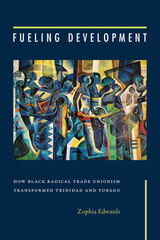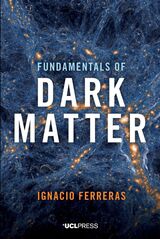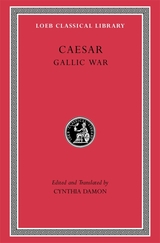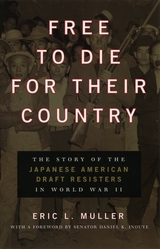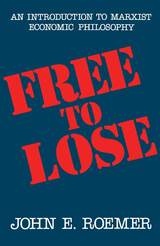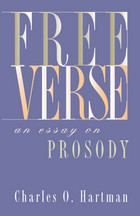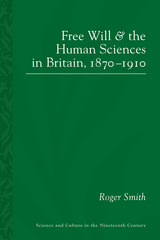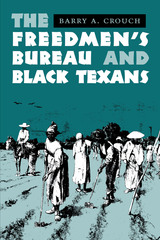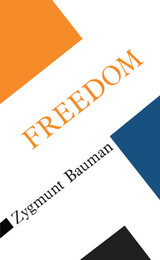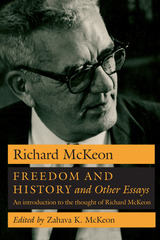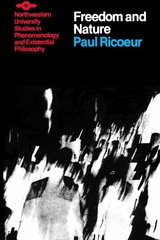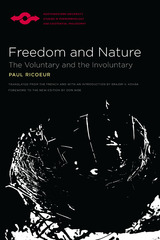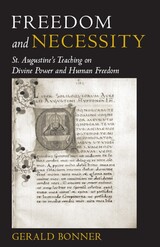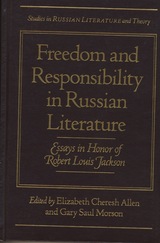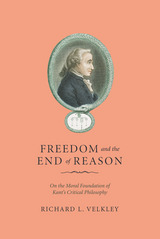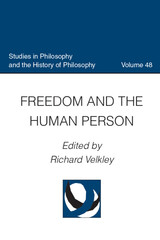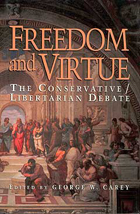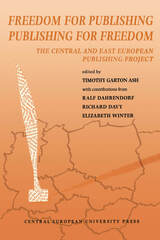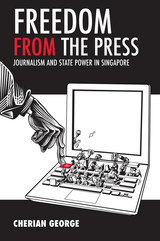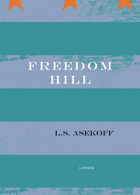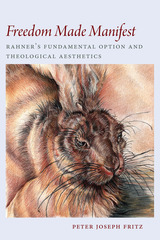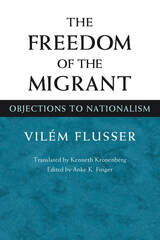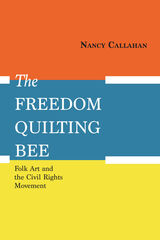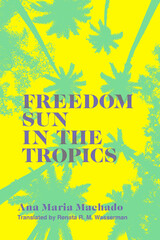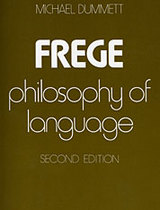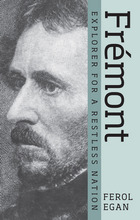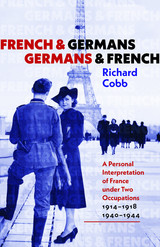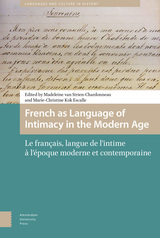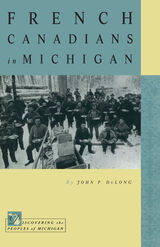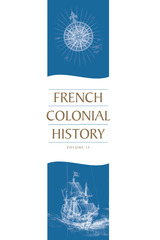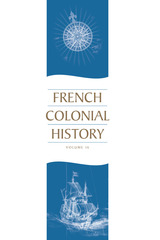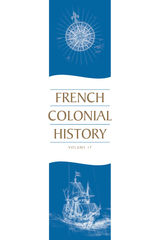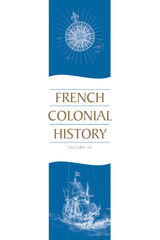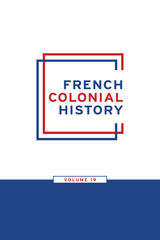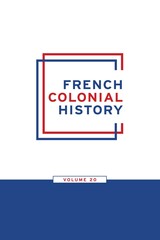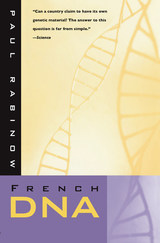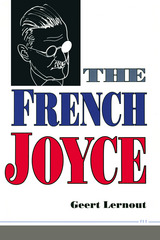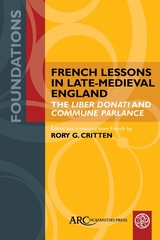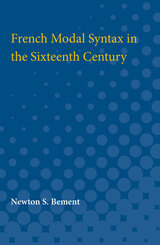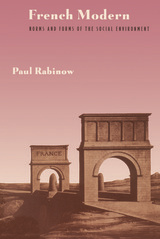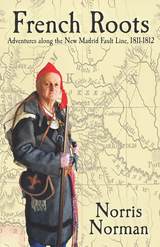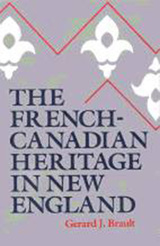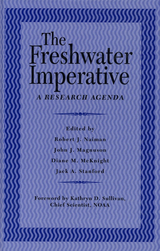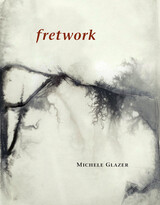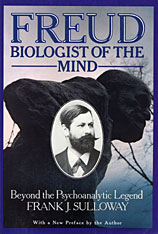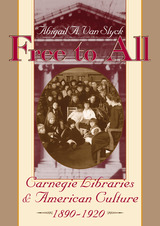 Free to All: Carnegie Libraries & American Culture, 1890-1920
Abigail A. Van Slyck
University of Chicago Press, 1996 Familiar landmarks in hundreds of American towns, Carnegie libraries today seem far from controversial. In Free to All, however, Abigail A. Van Slyck shows that the classical façades and symmetrical plans of these buildings often mask a complex and contentious history.
"The whole story is told here in this book. Carnegie's wishes, the conflicts among local groups, the architecture, development of female librarians. It's a rich and marvelous story, lovingly told."—Alicia Browne, Journal of American Culture
"This well-written and extensively researched work is a welcome addition to the history of architecture, librarianship, and philanthropy."—Joanne Passet, Journal of American History
"Van Slyck's book is a tremendous contribution for its keenness of scholarship and good writing and also for its perceptive look at a familiar but misunderstood icon of the American townscape."—Howard Wight Marshall, Journal of the Society of Architectural Historians
"[Van Slyck's] reading of the cultural coding implicit in the architectural design of the library makes a significant contribution to our understanding of the limitations of the doctrine 'free to all.'"—Virginia Quarterly Review
Free to Die for Their Country: The Story of the Japanese American Draft Resisters in World War II
Eric L. Muller
University of Chicago Press, 2001 One of the Washington Post's Top Nonfiction Titles of 2001
In the spring of 1942, the federal government forced West Coast Japanese Americans into detainment camps on suspicion of disloyalty. Two years later, the government demanded even more, drafting them into the same military that had been guarding them as subversives. Most of these Americans complied, but Free to Die for Their Country is the first book to tell the powerful story of those who refused. Based on years of research and personal interviews, Eric L. Muller re-creates the emotions and events that followed the arrival of those draft notices, revealing a dark and complex chapter of America's history.
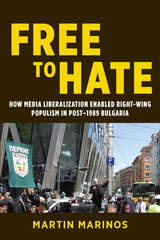 Free to Hate: How Media Liberalization Enabled Right-Wing Populism in Post-1989 Bulgaria
Martin Marinos
University of Illinois Press, 2023 Linking neoliberalism with the Right’s global rise Bulgaria’s media-driven pivot to right-wing populism parallels political developments taking place around the world. Martin Marinos applies a critical political economy approach to place Bulgarian right-wing populism within the structural transformation of the country’s media institutions. As Marinos shows, media concentration under Western giants like Westdeutsche Allgemeine Zeitung and News Corporation have led to a neoliberal turn of commercialization, concentration, and tabloidization across media. The Right have used the anticommunism and racism bred by this environment to not only undermine traditional media but position their own outlets to boost new political entities like the nationalist party Ataka. Marinos’s ethnographic observations and interviews with local journalists, politicians, and media experts add on-the-ground detail to his account. He also examines several related issues, including the performative appeal of populist media and the money behind it. A timely and innovative analysis, Free to Hate reveals where structural changes in media intersect with right-wing populism.
Free to Lose: An Introduction to Marxist Economic Philosophy
John E. Roemer
Harvard University Press, 1988 Attacking the usefulness of such central Marxian concepts as the labor theory of value and surplus value, John Roemer reconstructs Marxian economic philosophy from the concepts of exploitation and class, showing that exploitation can be derived from a system of property relations. He then looks at the causes of the unequal distribution of wealth, including robbery and plunder, willingness to take risks, differential rates of time preference, luck, and entrepreneurship. He further examines the evolution of property systems—slave, feudal, capitalist, socialist—from the perspective of the theory of historical materialism, and ends by analyzing the properties of a social system in which ownership of productive assets in the external world is public, while ownership of internal productive assets—skills and talents—is private.
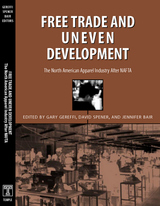 Free Trade & Uneven Development: North American Apparel Industry After Nafta
edited by Gary Gereffi, David Spener and Jennifer Bair
Temple University Press, 2002 This volume addresses many of the complex issues raised by North American integration through the lens of one of the largest and most global industries in the region: textiles and apparel. In part, this is a story of winners and losers in the globalization process, especially if one focuses on jobs lost and jobs gained in different countries and communities within North America, defined here as: Canada, the United States, Mexico, Central America, and the Caribbean. However, it would be a mistake to view the industry solely in these zerosum terms. The North American apparel industry is an excellent illustration of larger trends in the global economy, in which regional divisions of labor appear to be one of the most stable and effective responses to globalization.The contributors to this volume are an international and interdisciplinary group of scholars who have all done detailed fieldwork at the firm and factory levels in one or more countries of North America. Taken together the essays offer theoretical and methodological innovations built around the intersection of the global commodity chains and industrial districts literatures, as well as innovative approaches to studying the impact of cross-national, interfirm networks in terms of production and trade issues, and local development outcomes for workers and communities.
 Free Trade between the United States and Canada: The Potential Economic Effects
Ronald J. Wonnacott and Paul Wonnacott
Harvard University Press This study is the first major attempt to estimate what would happen in Canada if all trade restrictions between that country and the United States were removed.
In an intensive and far-reaching examination, the authors begin by confronting the generally held assumption that the lowering or eliminating of tariff protection would be disastrous for Canadian manufacturing. On the contrary, their findings lead them to conclude that, given present wage and exchange rates, the Canadian industrial complex would benefit substantially. The basis for this conclusion is a detailed analysis of the growth prospects—in the event of free trade—of five Canadian regions along with thirteen similarly definable regions in the United States. Sixteen manufacturing sectors (food, paper, textiles, etc.) are covered.
The second part of the study explores resulting general equilibrium pressures on wages and exchange. The probability, the authors believe, is that the Canadian dollar would rise to parity, and Canadian wages would reach the U.S. average level although they would remain below wage rates in contiguous areas of the U.S. North. The adjustments would necessarily be of a long-term nature and would be contingent on an effective reorganization of Canadian industry.
The historical effects of protection on Canada are then considered. Inefficiencies in Canadian production are estimated by comparing recent Canadian costs with costs which would exist in a free-trade situation. (The auto industry is singled out for special treatment, and an analysis of recent developments in that industry is appended.) The conclusion is that Canadian per capita real income is 10 to 11 percent lower because of protection. Higher Canadian prices explain about 4 percent of this figure, and lower money incomes 6 to 7 percent.
Finally, the authors discuss the possible structure and implications of various alternative forms of economic integration (Free Trade Area, Customs Union, Common Currency Area); various means of staging tariff reductions; and proposals for adjustment assistance. The techniques they suggest, although focusing specifically on Canada and the United States, are applicable to other countries considering similar programs.
 Free Trade In The Bermuda Triangle: And Other Tales Of Counterglobalization
Brett Neilson
University of Minnesota Press, 2003 Shangri-La, the Bermuda Triangle, Transylvania, the Golden Triangle—far-flung in popular conception, these anomalous places nonetheless occupy the same mysterious zone, a mythography of unruly cartographic practices. And because this mythography becomes associated with a particular area of the earth’s surface, it may well suggest an alternative means of mapping the world, dissociated from the dominant geographical paradigms of nation-state, economic region, and the global/local marketing nexus. Large-scale nonnational geographical spaces that find their genesis in popular feeling, mystery, and belief, these four sites provide Brett Neilson with the basis not only for rethinking the current global reorganization of space and time but also for questioning the dominant narrative by which globalization marks the victory of capitalism. Free Trade in the Bermuda Triangle moves between analysis of popular fantasies and engagement with on-the-ground realities, weaving together topics as diverse as airplane disasters off the U.S. Atlantic coast, the global drug trade, vampire culture in postsocialist Europe, and the search for utopia in Chinese-occupied Tibet. The study of globalization is largely a solemn affair, occupied with increasing economic polarities, environmental degradation, and global insecurity. Free Trade in the Bermuda Triangle maintains a critical focus on these sobering issues but at the same time asks how popular pleasure and enjoyment can create viable alternatives to the current global order. Neilson takes seriously the proposition that capitalism must be contested at its own level of generality, finding provisional grounds for resistance in nonlocal transnational spaces that embody quotidian hopes, desires, and anxieties. By studying the real and imagined dimensions of these popular geographies, his book seeks resources for social betterment in the fallen mythologies of the contemporary postutopian world.Brett Neilson is senior lecturer in the School of Humanities at the University of Western Sydney, where he is also a member of the Centre for Cultural Research.
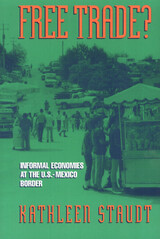 Free Trade: Informal Economies at the U.S.-Mexico Border
Kathleen Staudt
Temple University Press, 1998 In the aspiring global cities of Ciudad Juarez and El Paso, people generate income and develop their housing informally on both sides of the U.S.-Mexico border. Staudt analyzes women and men in low- and middle-income neighborhoods in the core an in the old and new peripheries of two cities that straddle an international border.
Residents counter national and international influences to build shelter and incomes, albeit meager. But the political machinery of both the U.S. and Mexico constrains the ability of these quintessential free traders to build political communities and organize around self-sufficient work and housing in visible ways.
Experiences at the border, along the central gateway for capital, job, and labor movement, offer insights to readers as the globalized economy spreads and engulfs the heartlands of both the U.S. and Mexico. People’s everyday victories in countering petty regulations can counter or feed the grand global hegemonies.
 Free Up Yuhself
Nikoli A. Attai
Rutgers University Press, 2025 Free Up Yuhself explores and theorizes what it means to embody and be empowered by the chaos of transgression, evaluating the implications for people who destabilize the Caribbean region’s dominant gender and sexuality politics within the Caribbean and the Caribbean diaspora. This book examines how people actively utilize the carnivalesque – spaces of festivity and places of excitement, the extraordinary, the ritualistic – to confront, negotiate, disrupt, and transgress normative trends, boundaries, and perspectives in the Caribbean and Caribbean diaspora communities. This book is particularly concerned with the ways that Caribbean people contest sexual and gendered expectations through their bodily performances across regional and diasporic festival spaces. Through illustrative, analytical, evaluative, and reflective chapters, the collection contemplates the themes of freedom, belonging, acceptance, and recognition as these affect the experience of people’s sense of being. The authors reflect on “freeing up” as a contentious politics, understanding that people have the capacity to enact their freedom through transgressive movements and performances that persistently grapple with notions of respectability, agency, empowerment, disruption, and the meanings and consequences of their varied social and political locations.
Free Verse: An Essay on Prosody
Charles O. Hartman
Northwestern University Press, 1996 To make sense of "free verse" in theory of in practice, the study of prosody—the function of rhythm in poetry—must be revised and rethought. In Free Verse: An Essay on Prosody, Charles Hartman develops a theory of prosody that includes the most characteristic form of twentieth-century poetry.
Free Will and the Human Sciences in Britain, 1870-1910
Roger Smith
University of Pittsburgh Press, 2013 From the late nineteenth century onwards religion gave way to science as the dominant force in society. This led to a questioning of the principle of free will—if the workings of the human mind could be reduced to purely physiological explanations, then what place was there for human agency and self-improvement?
Smith takes an in-depth look at the problem of free will through the prism of different disciplines. Physiology, psychology, philosophy, evolutionary theory, ethics, history and sociology all played a part in the debates that took place. His subtly nuanced navigation through these arguments has much to contribute to our understanding of Victorian and Edwardian science and culture, as well as having relevance to current debates on the role of genes in determining behaviour.
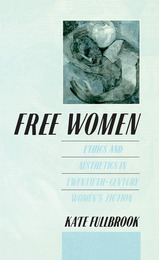 Free Women: Ethics and Aesthetics in Twentieth-Century Women's Fiction
Kate Fullbrook
Temple University Press, 1990 "In her lucid and persuasive study, Kate Fullbrook shows bow women writers from Edith Wharton to Toni Morrison have used their fiction to help restructure our ethical landscape. Her book insists on the useful truth that feminism, with its moral centre, has still much to offer the late twentieth century."
--Janet Todd, University of East Anglia
In this sensitive and incisive study of eleven major twentieth-century women novelists, Kate Fullbrook traces the ethical and aesthetic impulses that have shaped their fiction. The result is a profoundly important way of reading women writers in the light of a new ethics for women.
This book captures the sweep of women's literary achievement in the modern period and the impact of the radical new moral principles outlined in their fiction. The novelists included here are Edith Wharton, Willa Cather, Zora Neale Hurston, Gertrude Stein, Virginia Woolf, Dorothy Richardson, Djuna Barnes, Christina Stead, Doris Lessing, Margaret Atwood, and Toni Morrison. Fullbrook treats them not only as major literary figures in their own right but also as part of a tradition of women's writing that has as its project nothing less than an attempt to shift the moral ideas of the modern world.
"This is an exciting, original, and informative study of twentieth-century women's fiction. It brings a vast amount of material together, yet manages never to lose or confuse the reader--always there is a clear line of argument. The approach is genuinely interdisciplinary in the best spirit of feminist inquiry and [Fullbrook's] readings are fresh and illuminating. Fullbrook's argument that these women writers restructure the ethical landscape by devising new patterns for measuring moral success or failure is persuasive. Her discussion of the way they rebuild from the philosophical rubble of relativism, the way they intervene at a moment of cultural disjunction to propose alternative futures, is convincing and important."
--Gayle Green, Scripps College
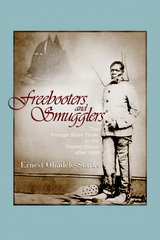 Freebooters and Smugglers: The Foreign Slave Trade in the United States after 1808
Ernest Obadele-Starks
University of Arkansas Press, 2007 In 1891 a young W. E. B. DuBois addressed the annual American Historical Association on the enforcement of slave trade laws: “Northern greed joined to Southern credulity was a combination calculated to circumvent any law, human or divine.” One law in particular he was referring to was the Abolition Act of 1808. It was specifically passed to end the foreign slave trade. However, as Ernest Obadele-Starks shows, thanks to profiteering smugglers like the Lafitte brothers and the Bowie brothers, the slave trade persisted throughout the south for a number of years after the law was passed. Freebooters and Smugglers examines the tactics and strategies that the adherents of the foreign slave trade used to challenge the law. It reassesses the role that Americans played in the continuation of foreign slave transshipments into the country right up to the Civil War, shedding light on an important topic that has been largely overlooked in the historiography of the slave trade.
The Freedmen's Bureau and Black Texans
By Barry A. Crouch
University of Texas Press, 1992 Drawing on a wealth of previously unused documentation in the National Archives, this book offers new insights into the workings of the Freedmen’s Bureau and the difficulties faced by Texas Bureau officials, who served in a remote and somewhat isolated area with little support from headquarters.
Freedom
Zygmunt Bauman
University of Minnesota Press, 1989
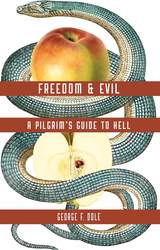 Freedom & Evil: A Pilgrim's Guide to Hell
George F. Dole
Swedenborg Foundation Publishers, 2001 Is there really a hell? Should we be good simply to avoid punishment in the life hereafter? Just asking these questions theoretically doesn't get us far, George F. Dole suggests, but examining the works of someone who has been there may help. Dole refers to Emanuel Swedenborg, the eighteenth-century Swedish scientist and statesman who over the last twenty-seven years of his life had the privileged status of an observer of non-physical worlds, including hell. Swedenborg wrote that we are unconscious residents of the spiritual world as well as the material world, and the hells he encountered have mirrors in our everyday lives.
Within this framework, Dole examines questions about evil and hell that have plagued thinkers for centuries: Do we have freedom of choice? Do our spirits exist after death? Does an all-loving God condemn us to hell? If not, can we ourselves become irredeemably evil? What distinguishes Dole's approach to these questions is his open-mindedness and his hopefulness. Freedom and Evil brings us face to face with a God of mercy, and it is easy to believe, with Dole, that the gates of hell are not to keep people in but to keep people out.
 Freedom: An Unruly History
Annelien de Dijn
Harvard University Press, 2020 Winner of the PROSE Award
An NRC Handelsblad Best Book of the Year
“Ambitious and impressive…At a time when the very survival of both freedom and democracy seems uncertain, books like this are more important than ever.”
—The Nation
“Helps explain how partisans on both the right and the left can claim to be protectors of liberty, yet hold radically different understandings of its meaning…This deeply informed history of an idea has the potential to combat political polarization.”
—Publishers Weekly
“Ambitious and bold, this book will have an enormous impact on how we think about the place of freedom in the Western tradition.”
—Samuel Moyn, author of Not Enough
“Brings remarkable clarity to a big and messy subject…New insights and hard-hitting conclusions about the resistance to democracy make this essential reading for anyone interested in the roots of our current dilemmas.”
—Lynn Hunt, author of History: Why It Matters
For centuries people in the West identified freedom with the ability to exercise control over the way in which they were governed. The equation of liberty with restraints on state power—what most people today associate with freedom—was a deliberate and dramatic rupture with long-established ways of thinking. So what triggered this fateful reversal? In a masterful and surprising reappraisal of more than two thousand years of Western thinking about freedom, Annelien de Dijn argues that this was not the natural outcome of such secular trends as the growth of religious tolerance or the creation of market societies. Rather, it was propelled by an antidemocratic backlash following the French and American Revolutions.
The notion that freedom is best preserved by shrinking the sphere of government was not invented by the revolutionaries who created our modern democracies—it was first conceived by their critics and opponents. De Dijn shows that far from following in the path of early American patriots, today’s critics of “big government” owe more to the counterrevolutionaries who tried to undo their work.
 Freedom and Creation in Three Traditions
David Burrell
University of Notre Dame Press, 1993 With creation of the universe as its focus and a deeper understanding of human freedom as its goal, Freedom and Creation in Three Traditions is a work of philosophical theology that brings together Jewish, Christian, and Muslim perspectives on the complex questions surrounding divine and human freedom. Burrell shows how the three traditions (each avowing the free creation of the universe by God) have developed a view of free human actors in relation to their initial affirmations that the universe is freely created by God. The concept of a free creation of the universe forms a motif for all three traditions, and their respective encounters with divine relation—in the Torah, Jesus Christ, and the Qur’an—offer distinctive ways of articulating and assimilating the original faith in a free creator. Burrell emphasizes the common ground among the traditions, but does not limit his discourse to a search for a common denominator among them. Instead, he traces the interactions among the traditions, employing an explicitly interfaith perspective that offers new ways to probe the vexing question of the relations between a free creator and free creatures. The results of this comparative method of reflection produce fresh insights into perennial human questions about creation and freedom—questions that have constituted a major body of theological reflection over the centuries.
Aimed at graduates and advanced undergraduates as well as laypersons interested in interfaith dialogue and reflection, Freedom and Creation in Three Traditions illustrates the value of tradition-directed inquiry and clearly demonstrates the fruitfulness of comparative inquiries in philosophical theology.
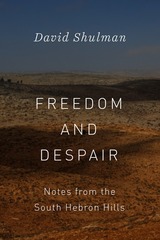 Freedom and Despair: Notes from the South Hebron Hills
David Shulman
University of Chicago Press, 2018 Lately, it seems as if we wake up to a new atrocity each day. Every morning is now a ritual of scrolling through our Twitter feeds or scanning our newspapers for the latest updates on fresh horrors around the globe. Despite the countless protests we attend, the phone calls we make, or the streets we march, it sometimes feels like no matter how hard we fight, the relentless crush of injustice will never abate.
David Shulman knows intimately what it takes to live your beliefs, to return, day after day, to the struggle, despite knowing you are often more likely to lose than win. Interweaving powerful stories and deep meditations, Freedom and Despair offers vivid firsthand reports from the occupied West Bank in Palestine as seen through the eyes of an experienced Israeli peace activist who has seen the Israeli occupation close up as it impacts on the lives of all Palestinian civilians.
Alongside a handful of beautifully written and often shocking tales from the field, Shulman meditates deeply on how to understand the evils around him, what it means to persevere as an activist decade after decade, and what it truly means to be free. The violent realities of the occupation are on full display. We get to know and understand the Palestinian shepherds and farmers and Israeli volunteers who face this situation head-on with nonviolent resistance. Shulman does not hold back on acknowledging the daily struggles that often leave him and his fellow activists full of despair. Inspired by these committed individuals who are not prepared to be silent or passive, Shulman suggests a model for ordinary people everywhere. Anyone prepared to take a risk and fight their oppressive political systems, he argues, can make a difference—if they strive to act with compassion and to keep hope alive.
This is the moving story of a man who continues to fight for good in the midst of despair. An indispensable book in our era of reactionary politics and refugee crises, political violence and ecological devastation, Freedom and Despair is a gripping memoir of struggle, activism, and hope for peace.
Freedom and History and Other Essays: An Introduction to the Thought of Richard McKeon
Richard McKeon
University of Chicago Press, 1990 This volume of essays is an important introduction to the thought of one of the twentieth century's most significant yet underappreciated philosophers, Richard McKeon. The originator of philosophical pluralism, McKeon made extraordinary contributions to philosophy, to international relations, and to theory-formation in the communication arts, aesthetics, the organization of knowledge, and the practical sciences. This collection, which includes a philosophical autobiography as well as the out-of-print title essay "Freedom and History" and a previously unpublished essay on "Philosophic Semantics and Philosophic Inquiry," is a testimony to the range and systematic power of McKeon's thinking for the social sciences and the humanities.
Freedom and Nature: The Voluntary and the Involuntary
Paul Ricoeur
Northwestern University Press, 1966 This volume, the first part of Paul Ricoeur's Philosophy of the Will, is an eidetics, carried out within carefully imposed phenomenological brackets. It seeks to deal with the essential structure of man's being in the world, and so it suspends the distorting dimensions of existence, the bondage of passion, and the vision of innocence, to which Ricoeur returns in his later writings. The result is a conception of man as an incarnate Cogito, which can make the polar unity of subject and object intelligible and provide a basic continuity for the various aspects of inquiry into man's being-in-the-world.
Freedom and Nature: The Voluntary and the Involuntary
Paul Ricoeur
Northwestern University Press, 2007 This volume, the first part of Paul Ricoeur's Philosophy of the Will, is an eidetics, carried out within carefully imposed phenomenological brackets. It seeks to deal with the essential structure of man's being in the world, and so it suspends the distorting dimensions of existence, the bondage of passion, and the vision of innocence, to which Ricoeur returns in his later writings. The result is a conception of man as an incarnate Cogito, which can make the polar unity of subject and object intelligible and provide a basic continuity for the various aspects of inquiry into man's being-in-the-world.
Freedom and Responsibility in Russian Literature: Essays in Honor of Robert Louis Jackson
Elizabeth Cheresh Allen and Gary Saul Morson
Northwestern University Press, 1994 Robert Louis Jackson has long been recognized on both sides of the Atlantic as one of the foremost Dostoevsky scholars in the world. Freedom and Responsibility in Russian Literature collects twenty essays by distinguished scholars (many former students of Jackson's) and admiring colleagues on some of the foremost questions in Russian studies. Whatever the specific topic, these essays manifest a determination to exercise the critical independence and integrity exemplified by Jackson throughout his long career.
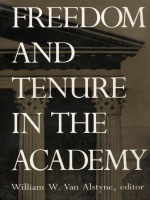 Freedom and Tenure in the Academy
William W. Van Alstyne, ed.
Duke University Press, 1993 Questions of academic freedom--from hate speech to the tenure structure—continue to be of great urgency and perennial debate in American higher education. Originally published as a special issue of Law and Contemporary Problems (Summer 1990), this volume draws together leading scholars of law, philosophy, and higher education to offer a fresh assessment of the founding principles of academic freedom and to define this crucial topic for the 1990s. The original 1940 Statement of Principles on Academic Freedom and Tenure, which has been influential in determining institutional practices for the last half century, has required continual redefinition since its initial declaration. The volume begins with two overview articles: the most complete examination of the 1940 Statement ever provided (shedding light on some of its most troublesome clauses) and a historical review of the extent to which academic freedom has been accepted into domestic constitutional law. Subsequent articles address a range of issues related to academic freedom: the relationship between tenure and academic freedom; tenure and labor law; ideology and faculty selection; freedom of expression and the arts on campus; the boundaries defining hate speech and offensive expression; the clash between institutional and individual claims of academic freedom; and the practices of religious colleges in the United States. Contributors. Ralph S. Brown, Matthew W. Finkin, Jordan E. Kurland, Michael W. McConnell, Walter P. Metzger, Robert M. O'Neil, David M. Rabban, Rodney A, Smolla, Janet Sinder, Judith Jarvis Thomson, William W. Van Alstyne
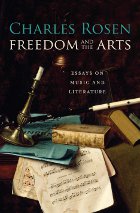 Freedom and the Arts: Essays on Music and Literature
Charles Rosen
Harvard University Press, 2012 Is there a moment in history when a work receives its ideal interpretation? Or is negotiation always required to preserve the past and accommodate the present? The freedom of interpretation, Charles Rosen suggests in these sparkling explorations of music and literature, exists in a delicate balance with fidelity to the identity of the original work.
Rosen cautions us to avoid doctrinaire extremes when approaching art of the past. To understand Shakespeare only as an Elizabethan or Jacobean theatergoer would understand him, or to modernize his plays with no sense of what they bring from his age, deforms the work, making it less ambiguous and inherently less interesting. For a work to remain alive, it must change character over time while preserving a valid witness to its earliest state. When twentieth-century scholars transformed Mozart’s bland, idealized nineteenth-century image into that of a modern revolutionary expressionist, they paradoxically restored the reputation he had among his eighteenth-century contemporaries. Mozart became once again a complex innovator, challenging to perform and to understand.
Drawing on a variety of critical methods, Rosen maintains that listening or reading with intensity—for pleasure—is the one activity indispensable for full appreciation. It allows us to experience multiple possibilities in literature and music, and to avoid recognizing only the revolutionary elements of artistic production. By reviving the sense that works of art have intrinsic merits that bring pleasure, we justify their continuing existence.
Freedom and the End of Reason: On the Moral Foundation of Kant's Critical Philosophy
Richard L. Velkley
University of Chicago Press, 1989 In Freedom and the End of Reason, Richard L. Velkley offers an influential interpretation of the central issue of Kant’s philosophy and an evaluation of its position within modern philosophy’s larger history. He persuasively argues that the whole of Kantianism—not merely the Second Critique—focuses on a “critique of practical reason” and is a response to a problem that Kant saw as intrinsic to reason itself: the teleological problem of its goodness. Reconstructing the influence of Rousseau on Kant’s thought, Velkley demonstrates that the relationship between speculative philosophy and practical philosophy in Kant is far more intimate than generally has been perceived. By stressing a Rousseau-inspired notion of reason as a provider of practical ends, he is able to offer an unusually complete account of Kant’s idea of moral culture.
Freedom and the Human Person
Richard Velkley
Catholic University of America Press, 2007 The present collection seeks to contribute toward finding that distance by making the tradition of thought more a living reality and not an object of arid analyses. Unlike most collections the present one transcends disciplinary boundaries, as it acknowledges the interconnectedness of philosophical, theological, and political arguments on these themes.
Freedom and Virtue: The Conservative/Libertarian Debate
George W. Carey
Intercollegiate Studies Institute, 2004 The long-running debates between between conservatives and libertarians are vigorous and highly charged, dealing with ideas about the very nature of liberty and morality. Like no other single work, Freedom and Virtue explores what unites and divides the adherents of these two important American traditions—shedding much light on our current political landscape.
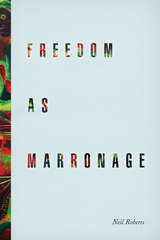 Freedom as Marronage
Neil Roberts
University of Chicago Press, 2015 What is the opposite of freedom? In Freedom as Marronage, Neil Roberts answers this question with definitive force: slavery, and from there he unveils powerful new insights on the human condition as it has been understood between these poles. Crucial to his investigation is the concept of marronage—a form of slave escape that was an important aspect of Caribbean and Latin American slave systems. Examining this overlooked phenomenon—one of action from slavery and toward freedom—he deepens our understanding of freedom itself and the origin of our political ideals.
Roberts examines the liminal and transitional space of slave escape in order to develop a theory of freedom as marronage, which contends that freedom is fundamentally located within this space—that it is a form of perpetual flight. He engages a stunning variety of writers, including Hannah Arendt, W. E. B. Du Bois, Angela Davis, Frederick Douglass, Samuel Taylor Coleridge, and the Rastafari, among others, to develop a compelling lens through which to interpret the quandaries of slavery, freedom, and politics that still confront us today. The result is a sophisticated, interdisciplinary work that unsettles the ways we think about freedom by always casting it in the light of its critical opposite.
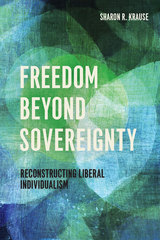 Freedom Beyond Sovereignty: Reconstructing Liberal Individualism
Sharon R. Krause
University of Chicago Press, 2015 What does it mean to be free? We invoke the word frequently, yet the freedom of countless Americans is compromised by social inequalities that systematically undercut what they are able to do and to become. If we are to remedy these failures of freedom, we must move beyond the common assumption, prevalent in political theory and American public life, that individual agency is best conceived as a kind of personal sovereignty, or as self-determination or control over one’s actions.
In Freedom Beyond Sovereignty, Sharon R. Krause shows that individual agency is best conceived as a non-sovereign experience because our ability to act and affect the world depends on how other people interpret and respond to what we do. The intersubjective character of agency makes it vulnerable to the effects of social inequality, but it is never in a strict sense socially determined. The agency of the oppressed sometimes surprises us with its vitality. Only by understanding the deep dynamics of agency as simultaneously non-sovereign and robust can we remediate the failed freedom of those on the losing end of persistent inequalities and grasp the scope of our own responsibility for social change. Freedom Beyond Sovereignty brings the experiences of the oppressed to the center of political theory and the study of freedom. It fundamentally reconstructs liberal individualism and enables us to see human action, personal responsibility, and the meaning of liberty in a totally new light.
 Freedom: Christian and Muslim Perspectives
Lucinda Mosher, Editor
Georgetown University Press, 2023 A unique interreligious dialogue provides needed context for deeper understanding of interfaith relations, from ancient to modern times Freedom is far from straightforward as a topic of comparative theology. While it is often identified with modernity and even postmodernity, freedom has long been an important topic for reflection by both Christians and Muslims, discussed in both the Bible and the Quran. Each faith has a different way of engaging with the idea of freedom shaped by the political context of their beginnings. The New Testament emerged in a region under occupation by the Roman Empire, whereas the Quran was first received in tribal Arabia, a stateless environment with political freedom. Freedom: Christian and Muslim Perspectives, edited by Lucinda Mosher, considers how Christian and Muslim faith communities have historically addressed many facets of freedom. The book presents essays, historical and scriptural texts, and reflections. Topics include God's freedom, human freedom to obey God, autonomy versus heteronomy, autonomy versus self-governance, freedom from incapacitating addiction and desire, hermeneutic or discursive freedom vis-à-vis scripture and tradition, religious and political freedom, and the relationship between personal conviction and public order. The rich insights expressed in this unique interfaith discussion will benefit readers—from students and scholars, to clerics and community leaders, to politicians and policymakers—who will gain a deeper understanding of how these two communities define freedom, how it is treated in both religious and secular texts, and how to make sense of it in the context of our contemporary lives.
 Freedom Colonies: Independent Black Texans in the Time of Jim Crow
By Thad Sitton and James H. Conrad
University of Texas Press, 2005 Friends of the Dallas Public Library Award, 2006
Best Book on East Texas, East Texas Historical Association, 2007 In the decades following the Civil War, nearly a quarter of African Americans achieved a remarkable victory—they got their own land. While other ex-slaves and many poor whites became trapped in the exploitative sharecropping system, these independence-seeking individuals settled on pockets of unclaimed land that had been deemed too poor for farming and turned them into successful family farms. In these self-sufficient rural communities, often known as "freedom colonies," African Americans created a refuge from the discrimination and violence that routinely limited the opportunities of blacks in the Jim Crow South. Freedom Colonies is the first book to tell the story of these independent African American settlements. Thad Sitton and James Conrad focus on communities in Texas, where blacks achieved a higher percentage of land ownership than in any other state of the Deep South. The authors draw on a vast reservoir of ex-slave narratives, oral histories, written memoirs, and public records to describe how the freedom colonies formed and to recreate the lifeways of African Americans who made their living by farming or in skilled trades such as milling and blacksmithing. They also uncover the forces that led to the decline of the communities from the 1930s onward, including economic hard times and the greed of whites who found legal and illegal means of taking black-owned land. And they visit some of the remaining communities to discover how their independent way of life endures into the twenty-first century.
Freedom for Publishing, Publishing for Freedom
Timothy Garton Ash
Central European University Press, 1995 This is an assessment of the Central and East European Publishing Project, an initiative designed to support embattled Central and East European publishers and journals, and to punch holes through the cultural Iron Curtain by encouraging translations. The nine years of its existence straddle the largest watershed in European history since 1945, and the Project's history - told here by some of its leading participants - illuminates the nature of the recent changes in Central and Eastern Europe.
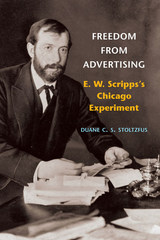 Freedom from Advertising: E. W. Scripps's Chicago Experiment
Duane C. S. Stoltzfus
University of Illinois Press, 2006 Disgusted by publishers and editors who refused to cover important stories for fear of offending advertisers, the press baron E. W. Scripps rejected conventional wisdom and set out to prove that an ad-free newspaper could be profitable entirely on circulation. Duane C. S. Stoltzfus details the history of Scripps’s innovative 1911 experiment, which began in Chicago amid great secrecy. The tabloid-sized newspaper was called the Day Book, and at a penny a copy, it aimed for a working-class market, crusading for higher wages, more unions, safer factories, lower streetcar fares, and women’s right to vote. It also tackled the important stories ignored by most other dailies, like the labor conflicts that shook Chicago in 1912. Though the Day Book’s financial losses steadily declined over the years, it never became profitable, and publication ended in 1917. Nevertheless, Stoltzfus explains that the Day Book served as an important ally of workers, a keen watchdog on advertisers, and it redefined news by providing an example of a paper that treated its readers first as citizens with rights rather than simply as consumers.
Freedom from the Press: Journalism and State Power in Singapore
Cherian George
National University of Singapore Press, 2011 For several decades, the city-state of Singapore has been an international anomaly, combining an advanced, open economy with restrictions on civil liberties and press freedom. Freedom from the Press analyses the republic’s media system, showing how it has been structured ”like the rest of the political framework” to provide maximum freedom of manœuvre for the People's Action Party (PAP) government.
 Freedom from Want: The Human Right to Adequate Food
George Kent
Georgetown University Press, 2005 There is, literally, a world of difference between the statements "Everyone should have adequate food," and "Everyone has the right to adequate food." In George Kent's view, the lofty rhetoric of the first statement will not be fulfilled until we take the second statement seriously. Kent sees hunger as a deeply political problem. Too many people do not have adequate control over local resources and cannot create the circumstances that would allow them to do meaningful, productive work and provide for themselves. The human right to an adequate livelihood, including the human right to adequate food, needs to be implemented worldwide in a systematic way. Freedom from Want makes it clear that feeding people will not solve the problem of hunger, for feeding programs can only be a short-term treatment of a symptom, not a cure. The real solution lies in empowering the poor. Governments, in particular, must ensure that their people face enabling conditions that allow citizens to provide for themselves. In a wider sense, Kent brings an understanding of human rights as a universal system, applicable to all nations on a global scale. If, as Kent argues, everyone has a human right to adequate food, it follows that those who can empower the poor have a duty to see that right implemented, and the obligation to be held morally and legally accountable, for seeing that that right is realized for everyone, everywhere.
Freedom Hill: A Poem
L.S. Asekoff
Northwestern University Press, 2011 Recepient, 2013 Guggenheim Fellowship Winner, 2012 Witter Bynner Award and Fellowship L. S. Asekoff's Freedom Hill is a dramatic monologue divided into three sections. The first concerns the speaker's visit with his aging parents and the death of his father. The second, set at an art party, is a meditation on women, desire, and the nature of the self. In the third, we witness the effects on the speaker of a cerebral stroke, along with his gradual recovery. As readers of Asekoff's unique body of work have come to expect, this highly allusive poem encompasses a wide range of subject matter: Heidegger, C-SPAN, modern art, aging, capitalism, religion. Also familiar will be Asekoff's great variety of tone and verbal ingenuity. Although indebted to high modernism, Freedom Hill is an ambitious, thoroughly contemporary meditation on issues very much of the present.
 Freedom in Entangled Worlds: West Papua and the Architecture of Global Power
Eben Kirksey
Duke University Press, 2012 Eben Kirksey first went to West Papua, the Indonesian-controlled half of New Guinea, as an exchange student in 1998. His later study of West Papua's resistance to the Indonesian occupiers and the forces of globalization morphed as he discovered that collaboration, rather than resistance, was the primary strategy of this dynamic social movement. Accompanying indigenous activists to Washington, London, and the offices of the oil giant BP, Kirksey saw the revolutionaries' knack for getting inside institutions of power and building coalitions with unlikely allies, including many Indonesians. He discovered that the West Papuans' pragmatic activism was based on visions of dramatic transformations on coming horizons, of a future in which they would give away their natural resources in grand humanitarian gestures, rather than watch their homeland be drained of timber, gold, copper, and natural gas. During a lengthy, brutal occupation, West Papuans have harbored a messianic spirit and channeled it in surprising directions. Kirksey studied West Papua's movement for freedom while a broad-based popular uprising gained traction from 1998 until 2008. Blending ethnographic research with indigenous parables, historical accounts, and narratives of his own experiences, he argues that seeking freedom in entangled worlds requires negotiating complex interdependencies.
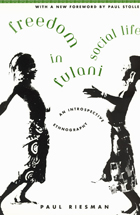 Freedom in Fulani Social Life: An Introspective Ethnography
Paul Riesman
University of Chicago Press, 1977 Paul Riesman's Freedom in Fulani Social Life is based upon his two years of residence among the Jelgobe, a group of semi-nomadic Fulani of the Sahel in Upper Volta, western Africa. Since its original publication, this classic study has profoundly influenced the field of anthropology through its re-examination of the enthnographer's personal input on his research.
"Freedom in Fulani Social Life richly documents how the ethnographer's own personal and cultural background is implicated in the research process. . . . For this reason, [Riesman's] book will be of paramount interest to all ethnographers."—Philip L. Kilbride, Reviews in Anthropology
"A remarkably well-written and insightful account of Fulani life. . . . In addition to using the conventional approaches of participating in and observing the daily activities of the Jelgobe . . . Riesman enriches his account by examining his personal feelings about particular incidents."—Library Journal
"An interesting and provocative study."—Choice
At the time of his death in 1988, Paul Riesman was an anthropologist who taught at Carleton College.
 Freedom In Our Lifetime: The Collected Writings Of Anton Muziwakhe Lembede
Anton Muziwakhe Lembede
Ohio University Press, 1996 When a group of young political activists met in 1944 to launch the African National Congress Youth League, it included the nucleus of a remarkable generation of leaders who forged the struggle for freedom and equality in South Africa for the next half century: Nelson Mandela, Oliver Tambo, Walter Sisulu, Jordan Ngubane, Ellen Kuzwayo, Albertina Smith, A. P. Mda, Dan Tloome, and David Bopape. It was Anton Lembede, however whom they chose as their first president. Lembede, who had just begun practicing law in Johannesburg, was known for his sharp intellect, fiery personality, and unwavering commitment to the struggle at hand. The son of farm laborers from the district of Georgedale, Natal, Lembede had worked tirelessly to put himself through school and college, and then to qualify for the bachelor of laws degree. When he began law practice in 1943, he had also earned the respect of his fellows, not only for his intellectual achievements (which were many), but also for his dedication to the cause of freedom in South Africa. “I am,” he explained, “Africa’s own child.” His untimely death in 1947 at the age of 33 sent a wave of grief through the Congress Youth, who had looked to him for moral as well as political leadership. With the publication of Freedom In Our Lifetime, the editors acknowledge Lembede’s early contribution to the freedom movement, in particular his passionate and eloquent articulation of the African-centered philosophy he called “Africanism.”
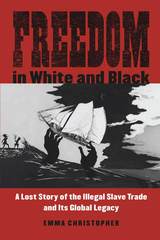 Freedom in White and Black: A Lost Story of the Illegal Slave Trade and Its Global Legacy
Emma Christopher
University of Wisconsin Press, 2020 By 1808, both Britain and the United States had passed laws outlawing the transatlantic slave trade. Yet the trade covertly carried on. In the summer of 1813, in what is now Liberia, a compound of slave pens was bursting with sick and anguished captives, guarded by other African slaves. As a British patrol swooped down on the illicit barracoon, the slavers burned the premises to the ground, hoping to destroy evidence.
This story can be told because of an exceptional trove of court documents that provides unparalleled insight into one small link in the great, horrific chain of slavery. Emma Christopher follows a trail of evidence across four continents to examine the lives of this barracoon's owners, their workers, and their tragic human merchandise. She reveals how an American, Charles Mason, escaped justice, while British subjects Robert Bostock and John McQueen were arrested. In court five African men—Tamba, Tom Ball, Yarra, Noah, and Sessay—courageously testified against their former owners/captors. They, and 233 other liberated men, women, and children, were relocated to Freetown, Sierra Leone. There they endured harsh lives of "freedom," while the punishment of Bostock and McQueen was fleeting.
From the fragmented facts of these lives, Christopher sheds fascinating light on the early development of the nations of Sierra Leone, Liberia, and Australia (where Bostock and McQueen were banished) and the role of former slaves in combatting the illegal trade.
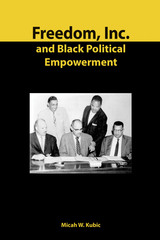 Freedom, Inc. and Black Political Empowerment
Micah W. Kubic
University of Missouri Press, 2016 Much has been written about black urban empowerment and about the candidates—particularly the winning candidates—who are the public face of such shifts in power. Authors invariably mention the important role played by black political organizations in electing black officials or organizing communities, but Micah W. Kubic goes further, making, for the first time, one such organization the focus of a book-length study. Kubic tells the story of black political empowerment in Kansas City through the prism of Freedom, Inc., the nation’s oldest existing black political organization. Using interviews and observation of participants as well as archival research, Kubic offers historical and political analysis of Freedom, Inc. from its founding in 1962 through its role in municipal elections of 2007. Kubic asserts that strong local organizations are living, dynamic organisms and that they, rather than charismatic candidates or interracial alliances, are the crucial players in both determining political outcomes and advancing black interests in urban areas.
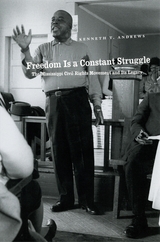 Freedom Is a Constant Struggle: The Mississippi Civil Rights Movement and Its Legacy
Kenneth T. Andrews
University of Chicago Press, 2004 No part of the United States was more resistant to the civil rights movement and its pursuit of racial equality than Mississippi. Freedom Is a Constant Struggle explores the civil rights movement in that state to consider its emergence before the 1965 Voting Rights Act and its impact long after. Did the civil rights movement have a lasting impact, and, if so, how did it bring about change? Kenneth T. Andrews is the first scholar to examine not only the history of the movement but its social and political legacy as well. His study demonstrates how during the 1970s and '80s, local movements worked to shape electoral politics, increase access to better public schools, and secure the administration of social welfare to needy African Americans.
Freedom Is a Constant Struggle is also the first book of its kind to detail the activities of white supremacists in Mississippi, revealing how white repression and intimidation sparked black activism and simultaneously undermined the movement's ability to achieve far-reaching goals. Andrews shows that the federal government's role was important but reactive as federal actors responded to the sustained struggles between local movements and their opponents. He tracks the mobilization of black activists by the NAACP, the creation of Freedom Summer, efforts to galvanize black voters, the momentous desegregation of public schools and the rise of all-white private academies, and struggles over the economic development of black communities. From this complex history, Andrews shows how the civil rights movement built innovative organizations and campaigns that empowered local leadership and had a lasting legacy in Mississippi and beyond.
Based on an original and creative research design that combines extensive archival research, interviews with activists, and quantitative historical data, Freedom Is a Constant Struggle provides many new insights into the civil rights struggle, and it presents a much broader theory to explain whether and how movements have enduring impacts on politics and society. What results is a work that will be invaluable to students of social movements, democratic politics, and the struggle for racial freedom in the U.S.
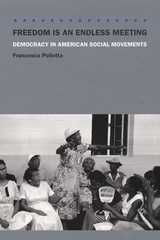 Freedom Is an Endless Meeting: Democracy in American Social Movements
Francesca Polletta
University of Chicago Press, 2002 Freedom Is an Endless Meeting offers vivid portraits of American experiments in participatory democracy throughout the twentieth century. Drawing on meticulous research and more than one hundred interviews with activists, Francesca Polletta challenges the conventional wisdom that participatory democracy is worthy in purpose but unworkable in practice. Instead, she shows that social movements have often used bottom-up decision making as a powerful tool for political change.
Polletta traces the history of democracy in early labor struggles and pre-World War II pacifism, in the civil rights, new left, and women's liberation movements of the sixties and seventies, and in today's faith-based organizing and anti-corporate globalization campaigns. In the process, she uncovers neglected sources of democratic inspiration—Depression-era labor educators and Mississippi voting registration workers, among them—as well as practical strategies of social protest. But Freedom Is an Endless Meeting also highlights the obstacles that arise when activists model their democracies after familiar nonpolitical relationships such as friendship, tutelage, and religious fellowship. Doing so has brought into their deliberations the trust, respect, and caring typical of those relationships. But it has also fostered values that run counter to democracy, such as exclusivity and an aversion to rules, and these have been the fault lines around which participatory democracies have often splintered. Indeed, Polletta attributes the fragility of the form less to its basic inefficiency or inequity than to the gaps between activists' democratic commitments and the cultural models on which they have depended to enact those commitments. The challenge, she concludes, is to forge new kinds of democratic relationships, ones that balance trust with accountability, respect with openness to disagreement, and caring with inclusiveness.
For anyone concerned about the prospects for democracy in America, Freedom Is an Endless Meeting will offer abundant historical, theoretical, and practical insights.
"This is an excellent study of activist politics in the United States over the past century. . . . Assiduously researched, impressively informed by a great number of thoughtful interviews with key members of American social movements, and deeply engaged with its subject matter, the book is likely to become a key text in the study of grass-roots democracy in America."—Kate Fullbrook, Times Literary Supplement
"Polletta's portrayal challenges the common assumption that morality and strategy are incompatible, that those who aim at winning must compromise principle while those who insist on morality are destined to be ineffective. . . . Rather than dwell on trying to explain the decline of 60s movements, Polletta shows how participatory democracy has become the guiding framework for many of today's activists."—Richard Flacks, Los Angeles Times Book Review
"In Freedom Is an Endless Meeting, Francesca Polletta has produced a remarkable work of historical sociology. . . . She provides the fullest theoretical work of historical sociology. . . . She provides the fullest theoretical picture of participatory democracy, rich with nuance, ambiguity, and irony, that this reviewer has yet seen. . . . This wise book should be studied closely by both academics and by social change activists."—Stewart Burns, Journal of American History
 Freedom Is, Freedom Ain’t: Jazz and the Making of the Sixties
Scott Saul
Harvard University Press, 2003 In the long decade between the mid-1950s and the late ’60s, jazz was changing more than its sound. The age of Max Roach’s Freedom Now Suite, John Coltrane’s A Love Supreme, and Charles Mingus’s The Black Saint and the Sinner Lady was a time when jazz became both newly militant and newly seductive, its example powerfully shaping the social dramas of the Civil Rights movement, the Black Power movement, and the counterculture. Freedom Is, Freedom Ain’t is the first book to tell the broader story of this period in jazz—and American—history.
The story’s central figures are jazz musicians like Coltrane and Mingus, who rewrote the conventions governing improvisation and composition as they sought to infuse jazz with that gritty exuberance known as “soul.” Scott Saul describes how these and other jazz musicians of the period engaged in a complex cultural balancing act: utopian and skeptical, race-affirming and cosmopolitan, they tried to create an art that would make uplift into something forceful, undeniable in its conviction, and experimental in its search for new possibilities. Freedom Is, Freedom Ain’t considers these musicians and their allies as a cultural front of the Civil Rights movement, a constellation of artists and intellectuals whose ideas of freedom pushed against a Cold War consensus that stressed rational administration and collective security. Capturing the social resonance of the music’s marriage of discipline and play, the book conveys the artistic and historical significance of the jazz culture at the start, and the heart, of the Sixties.
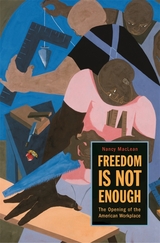 Freedom Is Not Enough: The Opening of the American Workplace
Nancy MacLean
Harvard University Press, 2008 In the 1950s, the exclusion of women and of black and Latino men from higher-paying jobs was so universal as to seem normal to most Americans. Today, diversity in the workforce is a point of pride. How did such a transformation come about?
In this bold and groundbreaking work, Nancy MacLean shows how African-American and later Mexican-American civil rights activists and feminists concluded that freedom alone would not suffice: access to jobs at all levels is a requisite of full citizenship. Tracing the struggle to open the American workplace to all, MacLean chronicles the cultural and political advances that have irrevocably changed our nation over the past fifty years.
Freedom Is Not Enough reveals the fundamental role jobs play in the struggle for equality. We meet the grassroots activists—rank-and-file workers, community leaders, trade unionists, advocates, lawyers—and their allies in government who fight for fair treatment, as we also witness the conservative forces that assembled to resist their demands. Weaving a powerful and memorable narrative, MacLean demonstrates the life-altering impact of the Civil Rights Act and the movement for economic advancement that it fostered.
The struggle for jobs reached far beyond the workplace to transform American culture. MacLean enables us to understand why so many came to see good jobs for all as the measure of full citizenship in a vital democracy. Opening up the workplace, she shows, opened minds and hearts to the genuine inclusion of all Americans for the first time in our nation’s history.
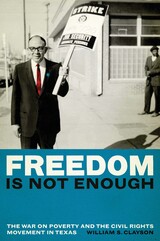 Freedom Is Not Enough: The War on Poverty and the Civil Rights Movement in Texas
By William S. Clayson
University of Texas Press, 2010 Led by the Office of Economic Opportunity, Lyndon Johnson's War on Poverty reflected the president's belief that, just as the civil rights movement and federal law tore down legalized segregation, progressive government and grassroots activism could eradicate poverty in the United States. Yet few have attempted to evaluate the relationship between the OEO and the freedom struggles of the 1960s. Focusing on the unique situation presented by Texas, Freedom Is Not Enough examines how the War on Poverty manifested itself in a state marked by racial division and diversity—and by endemic poverty. Though the War on Poverty did not eradicate destitution in the United States, the history of the effort provides a unique window to examine the politics of race and social justice in the 1960s. William S. Clayson traces the rise and fall of postwar liberalism in the Lone Star State against a backdrop of dissent among Chicano militants and black nationalists who rejected Johnson's brand of liberalism. The conservative backlash that followed is another result of the dramatic political shifts revealed in the history of the OEO, completing this study of a unique facet in Texas's historical identity.
Freedom Made Manifest
Peter Joseph Fritz
Catholic University of America Press, 2019 Freedom Made Manifest explicates Rahner’s theology of freedom by elucidating its configuration and sources. Much of its inquiry centers on the fundamental option: each human person’s eternal decision made, paradoxically, in time, as a definitive answer to God’s personally-tailored call to salvation. This idea stems from three principal sources: Catholic conversations with transcendental-idealist philosophy, penitential theology and practice, and Ignatian spirituality. Rahner’s unique redeployment of these sources inflects the fundamental option with theologies of concupiscence, mercy and forgiveness (especially as ecclesially mediated), and devotion to Jesus Christ. Awareness of these inflections can show how Rahner’s theology of freedom may assist in theological reflection on freedom’s susceptibility to injury and trauma.
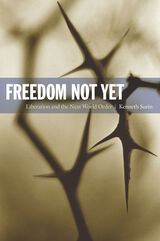 Freedom Not Yet: Liberation and the Next World Order
Kenneth Surin
Duke University Press, 2009 The neoliberal project in the West has created an increasingly polarized and impoverished world, to the point that the vast majority of its citizens require liberation from their present socioeconomic circumstances. The marxist theorist Kenneth Surin contends that innovation and change at the level of the political must occur in order to achieve this liberation, and for this endeavor marxist theory and philosophy are indispensable. In Freedom Not Yet, Surin analyzes the nature of our current global economic system, particularly with regard to the plight of less developed countries, and he discusses the possibilities of creating new political subjects necessary to establish and sustain a liberated world. Surin begins by examining the current regime of accumulation—the global domination of financial markets over traditional industrial economies—which is used as an instrument for the subordination and dependency of poorer nations. He then moves to the constitution of subjectivity, or the way humans are produced as social beings, which he casts as the key arena in which struggles against dispossession occur. Surin critically engages with the major philosophical positions that have been posed as models of liberation, including Derrida’s notion of reciprocity between a subject and its other, a reinvigorated militancy in political reorientation based on the thinking of Badiou and Zizek, the nomad politics of Deleuze and Guattari, and the politics of the multitude suggested by Hardt and Negri. Finally, Surin specifies the material conditions needed for liberation from the economic, political, and social failures of our current system. Seeking to illuminate a route to a better life for the world’s poorer populations, Surin investigates the philosophical possibilities for a marxist or neo-marxist concept of liberation from capitalist exploitation and the regimes of power that support it.
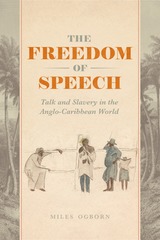 The Freedom of Speech: Talk and Slavery in the Anglo-Caribbean World
Miles Ogborn
University of Chicago Press, 2019 The institution of slavery has always depended on enforcing the boundaries between slaveholders and the enslaved. As historical geographer Miles Ogborn reveals in The Freedom of Speech, across the Anglo-Caribbean world the fundamental distinction between freedom and bondage relied upon the violent policing of the spoken word. Offering a compelling new lens on transatlantic slavery, this book gathers rich historical data from Barbados, Jamaica, and Britain to delve into the complex relationships between voice, slavery, and empire. From the most quotidian encounters to formal rules of what counted as evidence in court, the battleground of slavery lay in who could speak and under what conditions. But, as Ogborn shows through keen attention to both the traces of talk and the silences in the archives, if enslavement as a legal status could be made by words, it could be unmade by them as well. A deft interrogation of the duality of domination, The Freedom of Speech offers a rich interpretation of oral cultures that both supported and constantly threatened to undermine the slave system.
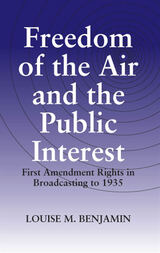 Freedom of the Air and the Public Interest: First Amendment Rights in Broadcasting to 1935
Louise M. Benjamin
Southern Illinois University Press, 2006 A unique and definitive study of freedom of expression rights in electronic media from the 1920s through the mid-1930s, Louise M. Benjamin’s Freedom of the Air and the Public Interest: First Amendment Rights in Broadcasting to 1935 examines the evolution of free speech rights in early radio. Drawing on primary resources from sixteen archives plus contemporary secondary sources, Benjamin analyzes interactions among the players involved and argues that First Amendment rights in radio evolved in the 1920s and 1930s through the interaction of many entities having social, political, or economic interests in radio. She shows how free speech and First Amendment rights were defined and perceived up to 1935. Focusing on the evolution of various electronic media rights, Benjamin looks at censorship, speakers’ rights of access to the medium, broadcasters’ rights to use radio as they desired, and listeners’ rights to receive information via the airwaves. With many interested parties involved, conflict was inevitable, resulting in the establishment of industry policies and government legislation—particularly the Radio Act of 1927. Further debate led to the Communications Act of 1934, which has provided the regulatory framework for broadcasting for over sixty years. Controversies caused by new technology today continue to rage over virtually the same rights and issues that Benjamin deals with.
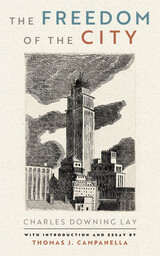 The Freedom of the City
Charles Downing Lay, with introduction and essay by Thomas J. Campanella
Island Press, 2023 “Congestion is the life of the city . . . it is what we came for, what we stay for, what we hunger for”, wrote Charles Downing Lay, prominent American landscape architect and planner of the early 1920s. These words are relevant today as density and congestion are once again under siege, especially in our most productive and thriving cities.
Published in 1926, The Freedom of the City by Charles Downing Lay is an eloquent and timely defense of urbanism and city life. Award-winning author and urban historian Thomas J. Campanella has given Lay’s text new life and relevance, with the addition of explanatory notes, imagery, an introduction, and biographical essay, to bring this important work to a new generation of urbanists.
Lay was decades ahead of his time, writing The Freedom of the City as Americans were just beginning to fall in love with the automobile and leave town for a romanticized life on the suburban fringe. Planners and theorists were arguing that heavily congested cities were a form of cancer, that great metropolitan centers like London and New York City must be decanted into a leafy “garden cities” in the countryside. Lay saved his sharpest pen for these anti-urbanists in his own profession of city and regional planning.
Lay writes of the delights of city life and—especially—that importance of the singular, essential ingredient that makes it all possible: “congestion” (closest in definition to “density” today). Congestion, to Lay, is the secret sauce of cities, the singular element that gives London, Paris, or New York its dynamism and magic. He believed that the amenities and affordances of a city are “the direct result of its great congestion”; indeed, congestion is “the life of the city. Reduce it below a certain point and much of our ease and convenience disappears.
Campanella writes “for all his blind spots, Lay's core argument still obtains. The Freedom of the City was prescient in 1926 and timely now. Certainly, the essentials of good urbanism extolled in the book—human scale, diversity, walkability, the serendipities of the street; above all, density—are articles of faith among architects and urbanists today.”
The Freedom of the Migrant: Objections to Nationalism
Vilém Flusser. Translated to the German by Kenneth Kronenberg. Edited and with an Introduction by Anke K. Finger
University of Illinois Press, 2013 Vilém Flusser was one of the most fascinating and original European thinkers of the late twentieth century. In this collection of his essays on emigration, nationalism, and information theory, he raises questions about the viability of ideas of national identity in a world whose borders are becoming increasingly arbitrary and permeable. Flusser argues that modern societies are in flux, with traditional linear and textual epistemologies being challenged by global circulatory networks and a growth in visual stimulation. Beyond globalization, Flusser's ideas about communication and identity are rooted in the Judeo-Christian concept of self-determination and self-realization through recognition of the other.
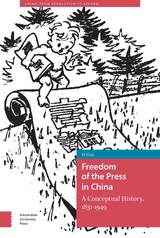 Freedom of the Press in China: A Conceptual History, 1831-1949
Yi Guo
Amsterdam University Press, 2020 Western commentators have often criticized the state of press freedom in China, arguing that individual speech still suffers from arbitrary restrictions and that its mass media remains under an authoritarian mode. Yet the history of press freedom in the Chinese context has received little examination. Unlike conventional historical accounts which narrate the institutional development of censorship and people’s resistance to arbitrary repression, Freedom of the Press in China: A Conceptual History, 1831-1949 is the first comprehensive study presenting the intellectual trajectory of press freedom. It sheds light on the transcultural transference and localization of the concept in modern Chinese history, spanning from its initial introduction in 1831 to the establishment of the People’s Republic of China in 1949. By examining intellectuals’ thoughts, common people’s attitudes, and official opinions, along with the social-cultural factors that were involved in negotiating Chinese interpretations and practices in history, this book uncovers the dynamic and changing meanings of press freedom in modern China.
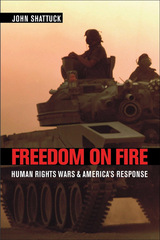 Freedom on Fire: Human Rights Wars and America’s Response
John Shattuck
Harvard University Press, 2003 As the chief human rights official of the Clinton Administration, John Shattuck faced far-flung challenges. Disasters were exploding simultaneously--genocide in Rwanda and Bosnia, murder and atrocities in Haiti, repression in China, brutal ethnic wars, and failed states in other parts of the world. But America was mired in conflicting priorities and was reluctant to act. What were Shattuck and his allies to do?
This is the story of their struggle inside the U.S. government over how to respond. Shattuck tells what was tried and what was learned as he and other human rights hawks worked to change the Clinton Administration's human rights policy from disengagement to saving lives and bringing war criminals to justice. He records his frustrations and disappointments, as well as the successes achieved in moving human rights to the center of U.S. foreign policy.
Shattuck was at the heart of the action. He was the first official to interview the survivors of Srebrenica. He confronted Milosevic in Belgrade. He was a key player in bringing the leaders of genocide in Bosnia and Rwanda to justice. He pushed from the inside for an American response to the crisis of the Haitian boat people. He pressed for the release of political prisoners in China. His book is both an insider's account and a detailed prescription for preventing such wars in the future.
Shattuck criticizes the Bush Administration's approach, which he says undermines human rights at home and around the world. He argues that human rights wars are breeding grounds for terrorism. Freedom on Fire describes the shifting challenges of global leadership in a world of explosive hatreds and deepening inequalities.
 Freedom Papers: An Atlantic Odyssey in the Age of Emancipation
Rebecca J. Scott and Jean M. Hébrard
Harvard University Press, 2012 Around 1785, a woman was taken from her home in Senegambia and sent to Saint-Domingue in the Caribbean. Those who enslaved her there named her Rosalie. Her later efforts to escape slavery were the beginning of a family's quest, across five generations and three continents, for lives of dignity and equality. Freedom Papers sets the saga of Rosalie and her descendants against the background of three great antiracist struggles of the nineteenth century: the Haitian Revolution, the French Revolution of 1848, and the Civil War and Reconstruction in the United States.
Freed during the Haitian Revolution, Rosalie and her daughter Elisabeth fled to Cuba in 1803. A few years later, Elisabeth departed for New Orleans, where she married a carpenter, Jacques Tinchant. In the 1830s, with tension rising against free persons of color, they left for France. Subsequent generations of Tinchants fought in the Union Army, argued for equal rights at Louisiana's state constitutional convention, and created a transatlantic tobacco network that turned their Creole past into a commercial asset. Yet the fragility of freedom and security became clear when, a century later, Rosalie's great-great-granddaughter Marie-José was arrested by Nazi forces occupying Belgium.
Freedom Papers follows the Tinchants as each generation tries to use the power and legitimacy of documents to help secure freedom and respect. The strategies they used to overcome the constraints of slavery, war, and colonialism suggest the contours of the lives of people of color across the Atlantic world during this turbulent epoch.
The Freedom Quilting Bee: Folk Art and the Civil Rights Movement
Nancy Callahan
University of Alabama Press, 2005 The original book on the renowned Freedom quilters of Gee's Bend - stitching justice, one quilt at a time. In December of 1965, the year of the Selma-to-Montgomery march, a white Episcopal priest driving through a desperately poor, primarily black section of Wilcox County found himself at a great bend of the Alabama River. He noticed a cabin clothesline from which were hanging three magnificent quilts unlike any he had ever seen. They were of strong, bold colors in original, op-art patterns—the same art style then fashionable in New York City and other cultural centers. An idea was born and within weeks took on life, in the form of the Freedom Quilting Bee, a handcraft cooperative of black women artisans who would become acclaimed throughout the nation.
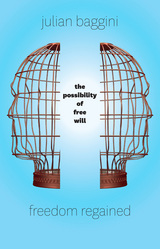 Freedom Regained: The Possibility of Free Will
Julian Baggini
University of Chicago Press, 2015 It’s a question that has puzzled philosophers and theologians for centuries and is at the heart of numerous political, social, and personal concerns: Do we have free will? In this cogent and compelling book, Julian Baggini explores the concept of free will from every angle, blending philosophy, sociology, and cognitive science to find rich new insights on the intractable questions that have plagued us. Are we products of our culture, or free agents within it? Are our neural pathways fixed early on by a mixture of nature and nurture, or is the possibility of comprehensive, intentional psychological change always open to us? And what, exactly, are we talking about when we talk about “freedom” anyway?
Freedom Regained brings the issues raised by the possibilities—and denials—of free will to thought-provoking life, drawing on scientific research and fascinating encounters with everyone from artists to prisoners to dissidents. He looks at what it means for us to be material beings in a universe of natural laws. He asks if there is any difference between ourselves and the brains from which we seem never able to escape. He throws down the wildcards and plays them to the fullest: What about art? What about addiction? What about twins? And he asks, of course, what this all means for politics.
Ultimately, Baggini challenges those who think free will is an illusion. Moving from doubt to optimism to a hedged acceptance of free will, he ultimately lands on a satisfying conclusion: it is something we earn. The result is a highly engaging, new, and more positive understanding of our sense of personal freedom, a freedom that is definitely worth having.
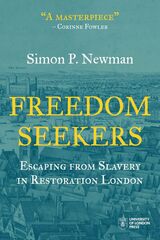 Freedom Seekers: Escaping from Slavery in Restoration London
Simon P. Newman
University of London Press, 2021 Freedom Seekers reveals the hidden stories of Britain’s enslaved people and their liberation.
This book brings the history of slavery in England to light, revealing the powerful untold stories of resistance by enslaved workers from Africa, South Asia, and First-Nations America forced to work in London as sailors and dockworkers, wet-nurses and washerwomen. Featuring a series of original case studies on those enslaved people who escaped captivity, this volume provides a rich source of information about slavery in eighteenth-century mainland Britain and the “freedom seekers” therein. Using maps, photographs, newspaper advertisements, and more, the book details escape routes, the networks of slaveholders, and the community of people of color across the London region.
Freedom Seekers demonstrates that not only were enslaved people present in Restoration London but that white Londoners were intimately involved in the construction of the system of racial slavery, a process traditionally regarded as happening in the colonies rather than the British Isles. Freedom Seekers is an utterly unmissable and important book that seeks to delve into Britain’s colonial past.
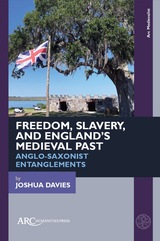 Freedom, Slavery, and England’s Medieval Past: Anglo-Saxonist Entanglements
Joshua Davies
Arc Humanities Press, 2025 This book is a study of how ideas drawn from the English Middle Ages have been used to preserve and withhold freedom in the modern world. Broad in scope, it draws on canonical and ephemeral texts, including chronicles, memoirs, novels, political pamphlets, archival material, and works of history by scholars, colonizers, abolitionists, and Lost Cause apologists. Using three generations of a single family to frame its analysis, it reveals an intellectual genealogy that moves from medieval England to modern Africa, the Caribbean, the plantations of the US, and back again, to the academic disciplines of medieval studies and the very fabric of England’s medieval heritage. It argues that England’s medieval past has been a source of tenacious bonds—of family, freedom, slavery, nation, and race—and suggests that better understanding how those bonds were formed and resisted will enable full analysis of their legacy.
 Freedom Struggles: African Americans and World War I
Adriane Lentz-Smith
Harvard University Press, 2011 For many of the 200,000 black soldiers sent to Europe with the American Expeditionary Forces in World War I, encounters with French civilians and colonial African troops led them to imagine a world beyond Jim Crow. They returned home to join activists working to make that world real. In narrating the efforts of African American soldiers and activists to gain full citizenship rights as recompense for military service, Adriane Lentz-Smith illuminates how World War I mobilized a generation.
Black and white soldiers clashed as much with one another as they did with external enemies. Race wars within the military and riots across the United States demonstrated the lengths to which white Americans would go to protect a carefully constructed caste system. Inspired by Woodrow Wilson’s rhetoric of self-determination but battered by the harsh realities of segregation, African Americans fought their own “war for democracy,” from the rebellions of black draftees in French and American ports to the mutiny of Army Regulars in Houston, and from the lonely stances of stubborn individuals to organized national campaigns. African Americans abroad and at home reworked notions of nation and belonging, empire and diaspora, manhood and citizenship. By war’s end, they ceased trying to earn equal rights and resolved to demand them.
This beautifully written book reclaims World War I as a critical moment in the freedom struggle and places African Americans at the crossroads of social, military, and international history.
Freedom Sun in the Tropics
Ana Maria Machado, Translated by Renata R. M. Wasserman
Tagus Press, 2020 Based upon the author's own experiences of life, exile, and return under the dictatorship that gripped Brazil in the 1960s and 1970s, Freedom Sun in the Tropics follows Lena, a journalist, as she resists violence and political repression, and decides to flee to Paris. Upon her eventual return, Lena soon discovers that the dictatorship's prison walls have enclosed private lives and hold strong even after the collapse of authoritarianism. With friendship, truth, and family broken, she struggles to make the difficult return to freedom and regain a sense of life—and simple decency—on the other side of trauma. Originally published in 1988, Ana Maria Machado's novel vividly captures one of the darkest periods in recent Brazilian history.
 Freedom Through Education
Lotus Coffman
University of Minnesota Press, 1939
Freedom Through Education was first published in 1939. Minnesota Archive Editions uses digital technology to make long-unavailable books once again accessible, and are published unaltered from the original University of Minnesota Press editions.February 15, 1939To the People of Minnesota:Knowing President Coffman as well as I did, I know he would have deprecated any elaborate eulogy of his work in and for the University of Minnesota. I know also that he welcomed always any opportunity to present his though about it and his reflections on the changing world that conditioned the flexible and forward-looking policy he thought the University should pursue. In the pages here published by the University are embodied some of his last and most suggestive thinking about the problems that concerned him always. They were prepared in large part in the year he used to rebuild his health and to formulate his ideas, free from the discursive and unending tasks of a university presidency. Of that year he in his last public address said:“. . . I am almost convinced that it would be a good thing if the administrative officers of the university, certainly the president, were compelled to take a leave of absence once every fife years. Their strength would be renewed and they would have ample opportunity, free from the restraints and responsibilities of office, to read, to reflect on education, and to visit other educational institutions . . .”Here were give voice to his thinking in the full faith that the works of men who are really builders are the reflection of their thinking.This booklet is also a memorial tribute that he would not deny us the right to pay to him and the work he did as an educator. His labors at Minnesota were so conceived and so carried on that they have a significance beyond the boundaries of the state and beyond the days of their doing.It is with profound appreciation of the importance of the contributions that Lotus Delta Coffman made to the University of Minnesota, and with deep admiration for the extent of his influence, that the Regents of the University of Minnesota issue Freedom Through Education as a tribute to him.Guy Stanton Ford,President
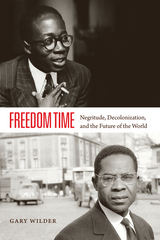 Freedom Time: Negritude, Decolonization, and the Future of the World
Gary Wilder
Duke University Press, 2015 Freedom Time reconsiders decolonization from the perspectives of Aimé Césaire (Martinique) and Léopold Sédar Senghor (Senegal) who, beginning in 1945, promoted self-determination without state sovereignty. As politicians, public intellectuals, and poets they struggled to transform imperial France into a democratic federation, with former colonies as autonomous members of a transcontinental polity. In so doing, they revitalized past but unrealized political projects and anticipated impossible futures by acting as if they had already arrived. Refusing to reduce colonial emancipation to national independence, they regarded decolonization as an opportunity to remake the world, reconcile peoples, and realize humanity’s potential. Emphasizing the link between politics and aesthetics, Gary Wilder reads Césaire and Senghor as pragmatic utopians, situated humanists, and concrete cosmopolitans whose postwar insights can illuminate current debates about self-management, postnational politics, and planetary solidarity. Freedom Time invites scholars to decolonize intellectual history and globalize critical theory, to analyze the temporal dimensions of political life, and to question the territorialist assumptions of contemporary historiography.
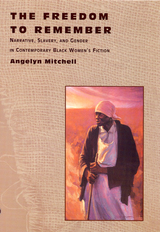 The Freedom to Remember: Narrative, Slavery, and Gender in Contemporary Black Women's Fiction
Mitchell, Angelyn
Rutgers University Press, 2002 The Freedom to Remember examines contemporary literary revisions of slavery in the United States by black women writers. The narratives at the center of this book include: Octavia E. Butler’s Kindred, Sherley Anne Williams’s Dessa Rose, Toni Morrison’s Beloved, J. California Cooper’s Family, and Lorene Cary’s The Price of a Child.
Recent studies have investigated these works only from the standpoint of victimization. Angelyn Mitchell changes the conceptualization of these narratives, focusing on the theme of freedom, not slavery, defining these works as “liberatory narratives.” These works create a space to problematize the slavery/freedom dichotomy from which contemporary black women writers have the “safe” vantage point to reveal aspects of enslavement that their ancestors could not examine. The nineteenth-century female emancipatory narrative, by contrast, was written to aid the cause of abolition by revealing the unspeakable realitiesof slavery. Mitchell shows how the liberatory narrative functions to emancipate its readers from the legacies of slavery in American society: by facilitating a deeper discussion of the issues and by making them new through illumination and interrogation.
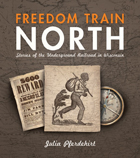 Freedom Train North: Stories of the Underground Railroad in Wisconsin
Julia Pferdehirt
Wisconsin Historical Society Press, 2011 People running from slavery made many hard journeys to find freedom—on steamboats and in carriages, across rivers and in hay-covered wagons. Some were shot at. Many were chased by slave catchers. Others hid in tunnels and secret rooms. But these troubles were worth it for the men, women, and children who eventually reached freedom. Freedom Train North tells the stories of fugitive slaves who found help in Wisconsin. Young readers (ages 7 to 12) will meet people like Joshua Glover, who was broken out of jail by a mob of freedom workers in Milwaukee, and Jacob Green, who escaped five times before he finally made it to freedom. This compelling book also introduces stories of the strangers who hid fugitive slaves and helped them on their way, brave men and women who broke the law to do what was right. As both a historian and a storyteller, author Julia Pferdehirt shares these exciting and important stories of a dangerous time in Wisconsin’s past. Using manuscripts, letters, and artifacts from the period, as well as stories passed down from one generation to another, Pferdehirt takes us deep into our state’s past, challenging and inspiring us with accounts of courage and survival.
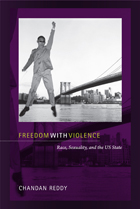 Freedom with Violence: Race, Sexuality, and the US State
Chandan Reddy
Duke University Press, 2011 In Freedom with Violence, Chandan Reddy develops a new paradigm for understanding race, sexuality, and national citizenship. He examines a crucial contradiction at the heart of modernity: the nation-state’s claim to provide freedom from violence depends on its systematic deployment of violence against peoples perceived as nonnormative and irrational. Reddy argues that the modern liberal state is organized as a “counterviolence” to race even as, and precisely because, race persists as the condition of possibility for the modern subject. Rejecting liberal notions of modernity as freedom from violence or revolutionary ideas of freedom through violence, Reddy contends that liberal modernity is a structure for authorizing state violence. Contemporary neoliberal societies link freedom to the notion of legitimate (state) violence and produce narratives of liberty that tie rights and citizenship to institutionalized violence. To counter these formulations, Reddy proposes an alternative politics of knowledge grounded in queer of color critique and critical ethnic studies. He uses issues that include asylum law and the military’s “don’t ask, don’t tell” policy to illustrate this major rethinking of the terms of liberal modernity.
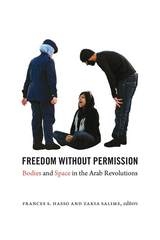 Freedom without Permission: Bodies and Space in the Arab Revolutions
Frances S. Hasso and Zakia Salime, editors
Duke University Press, 2016 As the 2011 uprisings in North Africa reverberated across the Middle East, a diverse cross section of women and girls publicly disputed gender and sexual norms in novel, unauthorized, and often shocking ways. In a series of case studies ranging from Tunisia's 14 January Revolution to the Taksim Gezi Park protests in Istanbul, the contributors to Freedom without Permission reveal the centrality of the intersections between body, gender, sexuality, and space to these groundbreaking events. Essays include discussions of the blogs written by young women in Egypt, the Women2Drive campaign in Saudi Arabia, the reintegration of women into the public sphere in Yemen, the sexualization of female protesters encamped at Bahrain's Pearl Roundabout, and the embodied, performative, and artistic spaces of Morocco's 20 February Movement. Conceiving of revolution as affective, embodied, spatialized, and aesthetic forms of upheaval and transgression, the contributors show how women activists imagined, inhabited, and deployed new spatial arrangements that undermined the public-private divisions of spaces, bodies, and social relations, continuously transforming them through symbolic and embodied transgressions. Contributors. Lamia Benyoussef, Susanne Dahlgren, Karina Eileraas, Susana Galan, Banu Gökariksel, Frances S. Hasso, Sonali Pahwa, Zakia Salime
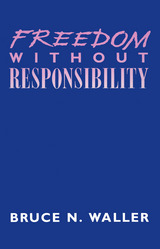 Freedom Without Responsibility
Bruce Waller
Temple University Press, 1990 "What I like most about this book is that it attacks two received positions. One, that a host of other judgments require the retention of moral responsibility The other, that moral responsibility is the best or only game in town when it comes to achieving various social goals. Received opinions are always in need of energetic attack, and the attacks here are both energetic and well written."
--Jeffrey Olen, author of Moral Freedom, former Professor of Philosophy, University of Wisconsin, Stevens Point
In this book, Bruce Waller attacks two prevalent philosophical beliefs. First, he argues that moral responsibility must be rejected; there is no room for such a notion within our naturalist framework. Second, he denies the common assumption that moral responsibility is inseparably linked with individual freedom. Rejection of moral responsibility does not entail the demise of individual freedom; instead, individual freedom is enhanced by the rejection of moral responsibility. According to this theory of "no-fault naturalism," no one deserves either blame or reward.
In the course of arguing against moral responsibility, Waller critiques major compatibilist arguments--by Dennett, Frankfurt, Strawson, Bennett, Wolf, Hampshire, Glover, Rachels, Sher, and others. In addition, the implications of denying moral responsibility--for individual freedom, for moral judgments and moral behavior, and for social justice--are examined; the supposed dire consequences of the denial of moral responsibility are challenged; and the benefits of denying moral responsibility are described.
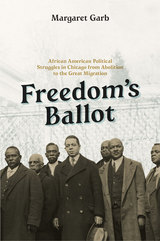 Freedom's Ballot: African American Political Struggles in Chicago from Abolition to the Great Migration
Margaret Garb
University of Chicago Press, 2014 In the spring of 1915, Chicagoans elected the city’s first black alderman, Oscar De Priest. In a city where African Americans made up less than five percent of the voting population, and in a nation that dismissed and denied black political participation, De Priest’s victory was astonishing. It did not, however, surprise the unruly group of black activists who had been working for several decades to win representation on the city council.
Freedom’s Ballot is the history of three generations of African American activists—the ministers, professionals, labor leaders, clubwomen, and entrepreneurs—who transformed twentieth-century urban politics. This is a complex and important story of how black political power was institutionalized in Chicago in the half-century following the Civil War. Margaret Garb explores the social and political fabric of Chicago, revealing how the physical makeup of the city was shaped by both political corruption and racial empowerment—in ways that can still be seen and felt today.
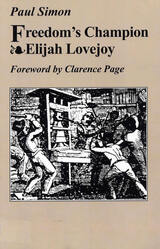 Freedom's Champion: Elijah Lovejoy
Elijah Lovejoy. Revised by Paul Simon. Foreword by Clarence Page
Southern Illinois University Press, 1994 In this revised edition of his earlier biography, Paul Simon provides an inspiring account of the life and work of Elijah Lovejoy, an avid abolitionist in the 1830s and the first martyr to freedom of the press in the United States. Lovejoy was a native New Englander, the son of a Congregational minister. He came to the Midwest in 1827 in pursuit of a teaching career and succeeded in running his own school for two years in St. Louis. Teaching failed to challenge Lovejoy, however, so he bought a half interest in the St. Louis Times and became its editor. In 1832, after experiencing a religious conversion, he returned east to study for the ministry at Princeton Theological Seminary. After his graduation, Lovejoy was called back to St. Louis by a group of Christian businessmen to serve as the editor of a new religious newspaper, the Observer, promoting religion, morality, and education. It was through this forum that Lovejoy took an ever stronger stance against slavery. In the slave state of Missouri, such a view was not onlyunpopular, but in the eyes of many, criminal. As a result, Lovejoy and his family suffered repeated persecution and acts of violence from angry mobs. In July 1836, in hopes of finding a more tolerant community in a "free" state, he moved both his printing press and his family across the Mississippi River to Alton, Illinois. The move to Alton was a fateful one. Lovejoy’s press was dismantled and thrown into the river by a mob on the night of its arrival. Lovejoy ordered a new printing press, and it, too, was destroyed eleven months later. A determined and dedicated man, Lovejoy ordered a third press, and city officials took special precautions to ensure its safety after delivery. Nevertheless, an organized and angry mob rolled this third press, still in its crate, into the river exactly one month after Lovejoy’s second press had been destroyed. A fourth press, housed in a large stone warehouse and guarded by Lovejoy and his supporters, met the same fate but only after a drunken mob had killed Lovejoy himself. He was buried two days later, 9 November 1837, on his thirty-fifth birthday. No one was ever convicted of his murder. Rather than suppressing the abolitionist movement, Lovejoy’s death caused an eruption of antislavery activity throughout the nation. At a protest meeting in Ohio, John Brown dedicated his life to fighting slavery, and Wendell Phillips emerged from a Lovejoy protest meeting in Boston to become a leader in the antislavery fight. Simon defines Lovejoy’s fight as a struggle for human dignity and the oppressed. He distinguishes Lovejoy as a courageous and admirable individual and his story as an important and enduring one for both the cause of freedom for the slaves and the cause of freedom of the press.
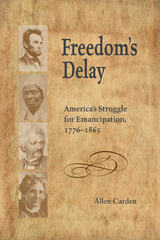 Freedom’s Delay: America’s Struggle for Emancipation, 1776–1865
Allen Carden
University of Tennessee Press, 2014 The Declaration of Independence proclaimed freedom for Americans from the domination of Great Britain, yet for millions of African Americas caught up in a brutal system of racially based slavery, freedom would be denied for ninety additional years until the ratification of the Thirteenth Amendment to the U.S. Constitution. Freedom’s Delay: America’s Struggle for Emancipation, 1776–1865 probes the slow, painful, yet ultimately successful crusade to end slavery throughout the nation, North and South.
This work fills an important gap in the literature of slavery’s demise. Unlike other authors who focus largely on specific time periods or regional areas, Allen Carden presents a thematically structured national synthesis of emancipation. Freedom’s Delay offers a comprehensive and unique overview of the process of manumission commencing in 1776 when slavery was a national institution, not just the southern experience known historically by most Americans. In this volume, the entire country is examined, and major emancipatory efforts—political, literary, legal, moral, and social—made by black and white, free and enslaved individuals are documented over the years from independence through the ratification of the Thirteenth Amendment.
Freedom’s Delay dispels many of the myths about slavery and abolition, including that racial servitude was of little consequence in the North, and, where it did exist, it ended quickly and easily; that abolition was a white man’s cause and blacks were passive recipients of liberty; that the South seceded primarily to protect states’ rights, not slavery; and that the North fought the Civil War primarily to end the subjugation of African Americans. By putting these misunderstandings aside, this book reveals what actually transpired in the fight for human rights during this critical era. Carden’s inclusion of a cogent preface and epilogue assures that Freedom’s Delay will find a significant place in the literature of American slavery and freedom.
With a compelling preface and epilogue, notes, illustrations and tables, and a detailed bibliography, this volume will be of great value not only in courses on American history and African American history but also to the general reading public.
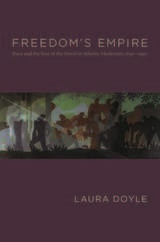 Freedom's Empire: Race and the Rise of the Novel in Atlantic Modernity, 1640-1940
Laura Doyle
Duke University Press, 2007 In this pathbreaking work of scholarship, Laura Doyle reveals the central, formative role of race in the development of a transnational, English-language literature over three centuries. Identifying a recurring freedom plot organized around an Atlantic Ocean crossing, Doyle shows how this plot structures the texts of both African-Atlantic and Anglo-Atlantic writers and how it takes shape by way of submerged intertextual exchanges between the two traditions. For Anglo-Atlantic writers, Doyle locates the origins of this narrative in the seventeenth century. She argues that members of Parliament, religious refugees, and new Atlantic merchants together generated a racial rhetoric by which the English fashioned themselves as a “native,” “freedom-loving,” “Anglo-Saxon” people struggling against a tyrannical foreign king. Stories of a near ruinous yet triumphant Atlantic passage to freedom came to provide the narrative expression of this heroic Anglo-Saxon identity—in novels, memoirs, pamphlets, and national histories. At the same time, as Doyle traces through figures such as Friday in Robinson Crusoe, and through gothic and seduction narratives of ruin and captivity, these texts covertly register, distort, or appropriate the black Atlantic experience. African-Atlantic authors seize back the freedom plot, placing their agency at the origin of both their own and whites’ survival on the Atlantic. They also shrewdly expose the ways that their narratives have been “framed” by the Anglo-Atlantic tradition, even though their labor has provided the enabling condition for that tradition. Doyle brings together authors often separated by nation, race, and period, including Aphra Behn, Eliza Haywood, Olaudah Equiano, Nathaniel Hawthorne, Harriet Wilson, Pauline Hopkins, George Eliot, and Nella Larsen. In so doing, she reassesses the strategies of early women novelists, reinterprets the significance of rape and incest in the novel, and measures the power of race in the modern English-language imagination.
 Freedom’s Ferment: Phases of American Social History to 1860
Alice Felt Tyler
University of Minnesota Press, 1944 Freedom's Ferment was first published in 1944. Minnesota Archive Editions uses digital technology to make long-unavailable books once again accessible, and are published unaltered from the original University of Minnesota Press editions. In this historical synthesis of men and movements, Alice Felt Tyler shows in action the democratic faith of the young American republic. She tells the stories of the reform movements and social and religious experiments characteristic of the early half of the nineteenth century. The early efforts toward social and economic equality — later engulfed in the urgent issues of the Civil War—are here depicted and interpreted in their relation to the history of American thought and action. Freedom's Ferment divides the movements of the early 1800's into two groups: the cults and utopias of varied origins and the humanitarian crusades. A wave of revivalistic religions swept the country. Here is the story of the Millerites, who believed the end of the world would come on October 22, 1844, of the Spiritualists, Rappites, the Mormons, the Shakers. Many experiments in communal living were instituted by religious groups, but others were entirely social in concept. Life at Brook Farm, in Robert Owen's colony, in the Oneida Community, and a score of others, is interestingly reconstructed. Humanitarian reforms and crusades represent the other phase of the movements. Tyler, "exasperated by all the silly twaddle being written about the eccentricities" of the early American republic, shows these movements and the leaders—event the crackpots—as manifestations of the American creed of perfectibility. Prison and educational reforms, work for delinquents and unfortunates, crusades for world peace, temperance, and women's rights flourished. All to be overshadowed by the antislavery movement and submerged temporarily by the Civil War. Freedom's Ferment pictures the days when the pattern for the American way of life and the fundamentals of the American faith were being set by crusaders who fought for righteousness. The changes in out social picture have altered the form of the humanitarian movements but not the purpose. Interpretative and critical, the book show the ferment of the period and the urge to reform, found in every phase of life, to be the result of the fusion of religious freedom and political democracy.
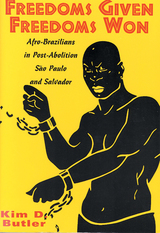 Freedoms Given, Freedoms Won: Afro-Brazilians in Post-Abolition São Paolo and Salvador
Butler, Kim D
Rutgers University Press, 1998 Freedoms Given, Freedoms Won explores the ways Afro-Brazilians in two major cities adapted to the new conditions of life after the abolition of slavery and how they confronted limitations placed on their new freedom. The book sets forth new ways of understanding why the abolition of slavery did not yield equitable fruits of citizenship, not only in Brazil, but throughout the Americas and the Caribbean. Afro-Brazilians in Sao Paulo and Salvador lived out their new freedom in ways that raise issues common to the entire Afro-Atlantic diaspora. In Sao Paulo, they initiated a vocal struggle for inclusion in the creation of the nation's first black civil rights organization and political party, and they appropriated a discriminatory identity that isolated blacks. In contrast, African identity prevaled over black identity in Salvador, where social protest was oriented toward protecting the right of cultural pluralism. Of all the eras and issues studied in Afro-Brazilian history, post-abolition social and political action has been the most neglected. Butler provides many details of this period for the first time in English and supplements published sources with original oral histories, Afro-Brazilian newspapers, and new state archival documents currently being catalogued in Bahia. Freedoms Given, Freedoms Won sets the Afro-Brazilian experience in a national context as well as situating it within the Afro-Atlantic diaspora through a series of explicit parallels, particularly with Cuba and Jamaica.
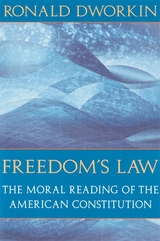 Freedom's Law: The Moral Reading of the American Constitution
Ronald Dworkin
Harvard University Press, 1996 Ronald Dworkin argues that Americans have been systematically misled about what their Constitution is, and how judges decide what it means. The Constitution, he observes, grants individual rights in extremely abstract terms. The First Amendment prohibits the passing of laws that “abridge the freedom of speech”; the Fifth Amendment insists on “due process of law”; and the Fourteenth Amendment demands “equal protection of the laws” for all persons. What does that abstract language mean when it is applied to the political controversies that divide Americans—about affirmative action and racial justice, abortion, euthanasia, capital punishment, censorship, pornography, and homosexuality, for example? Judges, and ultimately the justices of the Supreme Court, must decide for everyone, and that gives them great power. How should they decide?Dworkin defends a particular answer to that question, which he calls the “moral reading” of the Constitution. He argues that the Bill of Rights must be understood as setting out general moral principles about liberty and equality and dignity, and that private citizens, lawyers, and finally judges must interpret and apply those general principles by posing and trying to answer more concrete moral questions. Is freedom to choose abortion really a basic moral right and would curtailing that right be a deep injustice, for example? Why? In the detailed discussions of individual constitutional issues that form the bulk of the book, Dworkin shows that our judges do decide hard constitutional cases by posing and answering such concrete moral questions. Indeed he shows that that is the only way they can decide those cases.But most judges—and most politicians and most law professors—pretend otherwise. They say that judges must never treat constitutional issues as moral issues because that would be “undemocratic”—it would mean that judges were substituting their own moral convictions for those of Congressmen and state legislators who had been elected by the people. So they insist that judges can, and should, decide in some more mechanical way which involves no fresh moral judgment on their part.The result, Dworkin shows, has been great constitutional confusion. Is the premise at the core of this confusion really sound? Is the moral reading—the only reading of the American Constitution that makes sense—really undemocratic? In spirited and illuminating discussions both of the great constitutional cases of recent years, and of general constitutional principles, Dworkin argues, to the contrary, that the distinctly American version of government under principle, based on the moral reading of the Constitution, is in fact the best account of what democracy really is.
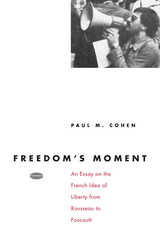 Freedom's Moment: An Essay on the French Idea of Liberty from Rousseau to Foucault
Paul M. Cohen
University of Chicago Press, 1997 What kind of freedom, and what kind of individual, has the French Revolutionary tradition sought to propagate? Paul Cohen finds a distinctly French articulation of freedom in the texts and lives of eight renowned cultural critics who lived between the eighteenth century and the present day.
Arranged not according to the lives and times of its protagonists but to the narrative themes and structures they held in common, Cohen’s study discerns a single master narrative of liberty in modern France. He captures these radicals, whose tradition bids them to resist the authority of power structures and public opinion. They denounce bourgeois and utilitarian values, the power of Church and State, and the corrupting influence of everyday politics, and they dream of a revolutionary rupture, a fleeting instant of sometimes violent but always meaningful transgression.
An eloquent and insightful work on French political culture, Freedom's Moment also helps explain how France, even as it has oscillated between political stagnation and crisis, has held onto its faith that liberty, equality, and fraternity remain within its grasp.
Examines the ideas of Rousseau, Robespierre, Stendahl, Michelet, Bergson, Peguy, Sartre, and Foucault.
Freedom's Port: The African American Community of Baltimore, 1790-1860
Christopher Phillips
University of Illinois Press, 1997 Baltimore's African-American population--nearly 27,000 strong and more than 90 percent free in 1860--was the largest in the nation at that time. Christopher Phillips's Freedom's Port, the first book-length study of an urban black population in the antebellum Upper South, chronicles the growth and development of that community.
He shows how it grew from a transient aggregate of individuals, many fresh from slavery, to a strong, overwhelmingly free community less wracked by class and intraracial divisions than were other cities. Almost from the start, Phillips states, Baltimore's African Americans forged their own freedom and actively defended it--in a state that maintained slavery and whose white leadership came to resent the liberties the city's black people had achieved.
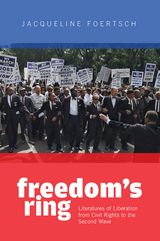 Freedom’s Ring: Literatures of Liberation from Civil Rights to the Second Wave
Jacqueline Foertsch
Rutgers University Press, 2021 Freedom’s Ring begins with the question of how the American ideal of freedom, which so effectively defends a conservative agenda today, from globally exploitative free trade to anti-French “freedom fries” during the War in Iraq, once bolstered the progressive causes of Freedom Summer, the Free Speech Movement, and more militant Black Power and Women’s Liberation movements with equal efficacy. Focused as it is on the faring of freedom throughout the liberation era, this book also explores attempts made by rights movements to achieve the often competitive or cross-canceling American ideal of equality–economic, professional, and otherwise. Although many struggled and died for it in the civil rights era, freedoms such as the vote, integrated bus rides, and sex without consequences via the Pill, are ultimately free–costing officialdom little if anything to fully implement—while equality with respect to jobs, salaries, education, housing, and health care, will forever be the much more expensive nut to crack. Freedom’s Ring regards the politics of freedom, and politics in general, as a low-cost substitute for and engrossing distraction from substantive economic problem-solving from the liberation era to the present day.
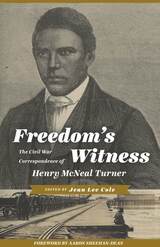 Freedom's Witness: The Civil War Correspondence of Henry McNeal Turner
Jean Lee Cole
West Virginia University Press, 2013 In a series of columns published in the African American newspaper The Christian Recorder, the young, charismatic preacher Henry McNeal Turner described his experience of the Civil War, first from the perspective of a civilian observer in Washington, D.C., and later, as one of the Union army’s first black chaplains.
In the halls of Congress, Turner witnessed the debates surrounding emancipation and black enlistment. As army chaplain, Turner dodged “grape” and cannon, comforted the sick and wounded, and settled disputes between white southerners and their former slaves. He was dismayed by the destruction left by Sherman’s army in the Carolinas, but buoyed by the bravery displayed by black soldiers in battle. After the war ended, he helped establish churches and schools for the freedmen, who previously had been prohibited from attending either.
Throughout his columns, Turner evinces his firm belief in the absolute equality of blacks with whites, and insists on civil rights for all black citizens. In vivid, detailed prose, laced with a combination of trenchant commentary and self-deprecating humor, Turner established himself as more than an observer: he became a distinctive and authoritative voice for the black community, and a leader in the African Methodist Episcopal church. After Reconstruction failed, Turner became disillusioned with the American dream and became a vocal advocate of black emigration to Africa, prefiguring black nationalists such as Marcus Garvey and Malcolm X. Here, however, we see Turner’s youthful exuberance and optimism, and his open-eyed wonder at the momentous changes taking place in American society.
Well-known in his day, Turner has been relegated to the fringes of African American history, in large part because neither his views nor the forms in which he expressed them were recognized by either the black or white elite. With an introduction by Jean Lee Cole and a foreword by Aaron Sheehan-Dean, Freedom’s Witness: The Civil War Correspondence of Henry McNeal Turner restores this important figure to the historical and literary record.
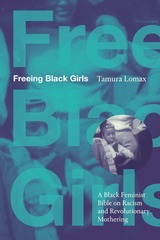 Freeing Black Girls: A Black Feminist Bible on Racism and Revolutionary Mothering
Tamura Lomax
Duke University Press, 2025 In Freeing Black Girls, Tamura Lomax offers an insurgent feminist love letter to Black girls, women, mothers, and othermothers. Exploring what it means to mother Black children in the twenty-first century, Lomax shares her journey from her traditionalist Black girlhood to finding the path to revolutionary Black motherhood. Along the way, she shows how all Black people are endangered by white supremacist capitalist heteropatriarchal dominance and emphasizes the power of looking and talking back. Lomax insists on Black feminist ways of living that value and nourish whole persons, sketching a radical dream that will allow Black women and girls to survive America while being able to love themselves, others, and collective Black freedom. Ultimately, Lomax declares that Black women and girls are emphatically not defective, second-class, or immanent nurturers; they are sacred and revolutionary beings who deserve to live a life free of predation, patriarchy, misrecognition, misogynoir, and violence.
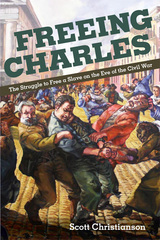 Freeing Charles: The Struggle to Free a Slave on the Eve of the Civil War
Scott Christianson
University of Illinois Press, 2010 Freeing Charles recounts the life and epic rescue of captured fugitive slave Charles Nalle of Culpeper, Virginia, who was forcibly liberated by Harriet Tubman and others in Troy, New York, on April 27, 1860. Scott Christianson follows Nalle from his enslavement by the Hansborough family in Virginia through his escape by the Underground Railroad and his experiences in the North on the eve of the Civil War. This engaging narrative represents the first in-depth historical study of this crucial incident, one of the fiercest anti-slavery riots after Harpers Ferry. Christianson also presents a richly detailed look at slavery culture in antebellum Virginia and probes the deepest political and psychological aspects of this epic tale. His account underscores fundamental questions about racial inequality, the rule of law, civil disobedience, and violent resistance to slavery in the antebellum North and South.
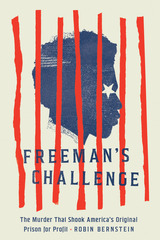 Freeman's Challenge: The Murder That Shook America's Original Prison for Profit
Robin Bernstein
University of Chicago Press, 2024 An award-winning historian tells a gripping, morally complicated story of murder, greed, race, and the true origins of prison for profit.
In the early nineteenth century, as slavery gradually ended in the North, a village in New York State invented a new form of unfreedom: the profit-driven prison. Uniting incarceration and capitalism, the village of Auburn built a prison that enclosed industrial factories. There, “slaves of the state” were leased to private companies. The prisoners earned no wages, yet they manufactured furniture, animal harnesses, carpets, and combs, which consumers bought throughout the North. Then one young man challenged the system.
In Freeman’s Challenge, Robin Bernstein tells the story of an Afro-Native teenager named William Freeman who was convicted of a horse theft he insisted he did not commit and sentenced to five years of hard labor in Auburn’s prison. Incensed at being forced to work without pay, Freeman demanded wages. His challenge triggered violence: first against him, then by him. Freeman committed a murder that terrified and bewildered white America. And white America struck back—with aftereffects that reverberate into our lives today in the persistent myth of inherent Black criminality. William Freeman’s unforgettable story reveals how the North invented prison for profit half a century before the Thirteenth Amendment outlawed slavery “except as a punishment for crime”—and how Frederick Douglass, Harriet Tubman, and other African Americans invented strategies of resilience and resistance in a city dominated by a citadel of unfreedom.
Through one Black man, his family, and his city, Bernstein tells an explosive, moving story about the entangled origins of prison for profit and anti-Black racism.
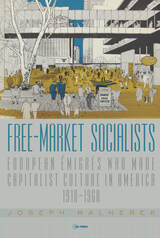 Free-Market Socialists: European Émigrés Who Made Capitalist Culture in America, 1918–1968
Joseph Malherek
Central European University Press, 2022 The Hungarian artist-designer László Moholy-Nagy, the Austrian sociologist Paul Lazarsfeld, and his fellow Viennese Victor Gruen—an architect and urban planner—made careers in different fields. Yet they shared common socialist politics, Jewish backgrounds, and experience as refugees from the Nazis. This book tells the story of their intellectual migration from Central Europe to the United States, beginning with the collapse of the Habsburg Empire, and moving through the heady years of newly independent social-democratic republics before the descent into fascism. It follows their experience of exile and adaptation in a new country, and culminates with a surprising outcome of socialist thinking: the opening of the first fully enclosed, air-conditioned suburban shopping center in the United States. Although the American culture they encountered ostensibly celebrated entrepreneurial individualism and capitalistic “free enterprise,” Moholy-Nagy, Lazarsfeld, and Gruen arrived at a time of the progressive economic reforms of the New Deal and an extraordinary open-mindedness about social democracy. This period of unprecedented economic experimentation nurtured a business climate that, for the most part, did not stifle the émigrés’ socialist idealism but rather channeled it as the source of creative solutions to the practical problems of industrial design, urban planning, and consumer behavior. Based on a vast array of original sources, Malherek interweaves the biographies of these three remarkable personalities and those of their wives, colleagues, and friends with whom they collaborated on innovative projects that would shape the material environment and consumer culture of their adopted home. The result is a narrative of immigration and adaptation that challenges the crude binary of capitalism and socialism with a story of creative economic hybridization.
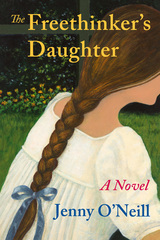 The Freethinker’s Daughter: A Novel
Jenny O'Neill
Ohio University Press, 2022 This historical and inspiring coming-of-age novel for young readers explores topics of both historical and contemporary relevance as it follows a harrowing year in the life of its intrepid teenaged narrator. Lexington, Kentucky, 1833: Calendula “Cal” Farmer, a thirteen-year-old white girl, has been raised by her abolitionist, freethinking mother to reason for herself, consult her inner wisdom, and come to her own conclusions. But when a flash flood devastates her family’s home, Cal is unexpectedly thrust into domestic service in a wealthy family’s mansion. There, she encounters firsthand the physical, intellectual, and emotional brutalities of slavery. Later, a cholera outbreak kills a quarter of the population, including Cal’s mother, and Cal enters an orphanage, where she bravely begins another chapter in her young life. Cal’s story is sure to captivate readers as she confronts the injustices and uncertainties of racism, class consciousness, epidemic disease, and personal loss with independent thinking, perseverance, and love.
Freethinkers, Libertines and Schwarmer: Heterodoxy in German Literature, 1750-1800
K. F. Hilliard
University of London Press, 2010 Professor Senia Pašeta argues that our understanding of modern Irish and British politics would be enormously enriched if we recognized two things: that the Irish and British suffrage movements were deeply connected; and that the women’s suffrage movement across the United Kingdom was shaped in fundamental ways by the Irish Question from the late nineteenth century and into the twentieth. In other words, the women’s suffrage movement did not exist in a political vacuum. It interacted with, influenced and was influenced by the other main political questions of the day, and with the main political question of the day - Ireland.
Frege: Philosophy of Language, Second Edition
Michael Dummett
Harvard University Press, 1981 No one has figured more prominently in the study of German philosopher Gottlob Frege than Michael Dummett. This highly acclaimed book is a major contribution to the philosophy of language as well as a systematic interpretation of Frege, indisputably the father of analytic philosophy. Frege: Philosophy of Language remains indispensable for an understanding of contemporary philosophy. Harvard University Press is pleased to reissue this classic book in paperback.
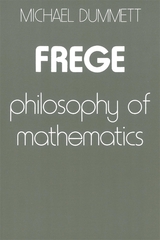 Frege: Philosophy of Mathematics
Michael Dummett
Harvard University Press, 1991 No one has figured more prominently in the study of the German philosopher Gottlob Frege than Michael Dummett. His magisterial Frege: Philosophy of Language is a sustained, systematic analysis of Frege's thought, omitting only the issues in philosophy of mathematics. In this work Dummett discusses, section by section, Frege's masterpiece The Foundations of Arithmetic and Frege's treatment of real numbers in the second volume of Basic Laws of Arithmetic, establishing what parts of the philosopher's views can be salvaged and employed in new theorizing, and what must be abandoned, either as incorrectly argued or as untenable in the light of technical developments.
Gottlob Frege (1848-1925) was a logician, mathematician, and philosopher whose work had enormous impact on Bertrand Russell and later on the young Ludwig Wittgenstein, making Frege one of the central influences on twentieth-century Anglo-American philosophy; he is considered the founder of analytic philosophy. His philosophy of mathematics contains deep insights and remains a useful and necessary point of departure for anyone seriously studying or working in the field.
 Frege's Logic
Danielle Macbeth
Harvard University Press, 2005 For many philosophers, modern philosophy begins in 1879 with the publication of Gottlob Frege's Begriffsschrift, in which Frege presents the first truly modern logic in his symbolic language, Begriffsschrift, or concept-script. Danielle Macbeth's book, the first full-length study of this language, offers a highly original new reading of Frege's logic based directly on Frege's own two-dimensional notation and his various writings about logic.
Setting out to explain the nature of Frege's logical notation, Macbeth brings clarity not only to Frege's symbolism and its motivation, but also to many other topics central to his philosophy. She develops a uniquely compelling account of Frege's Sinn/Bedeutung distinction, a distinction central to an adequate logical language; and she articulates a novel understanding of concepts, both of what they are and of how their contents are expressed in properly logical language. In her reading, Frege's Begriffsschrift emerges as a powerful and deeply illuminating alternative to the quantificational logic it would later inspire.
The most enlightening examination to date of the developments of Frege's thinking about his logic, this book introduces a new kind of logical language, one that promises surprising insight into a range of issues in metaphysics and epistemology, as well as in the philosophy of logic.
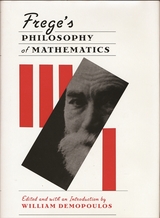 Frege’s Philosophy of Mathematics
William Demopoulos
Harvard University Press, 1995 Widespread interest in Frege’s general philosophical writings is, relatively speaking, a fairly recent phenomenon. But it is only very recently that his philosophy of mathematics has begun to attract the attention it now enjoys. This interest has been elicited by the discovery of the remarkable mathematical properties of Frege’s contextual definition of number and of the unique character of his proposals for a theory of the real numbers.
This collection of essays addresses three main developments in recent work on Frege’s philosophy of mathematics: the emerging interest in the intellectual background to his logicism; the rediscovery of Frege’s theorem; and the reevaluation of the mathematical content of The Basic Laws of Arithmetic. Each essay attempts a sympathetic, if not uncritical, reconstruction, evaluation, or extension of a facet of Frege’s theory of arithmetic. Together they form an accessible and authoritative introduction to aspects of Frege’s thought that have, until now, been largely missed by the philosophical community.
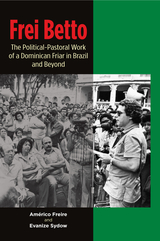 Frei Betto: The Political-Pastoral Work of a Dominican Friar in Brazil and Beyond
Evanize Sydow
Sussex Academic Press, 2022 The biography includes a preface by Cuban Commander Fidel Castro Frei Betto's roles as a revolutionary Christian, popular educator, social movement articulator, and journalist/writer provide insight into the political and religious history not only of Brazil, but of Cuba and former socialist countries of Eastern Europe. His lifepath is one of engagement with the revolutionary struggle against the Brazilian military dictatorship in favor of social transformation. His arrest in 1969 for coordinating the safe departure of political militants from Brazil, and his concern to eliminate hunger and suffering from the poorer classes, were strong credentials as he promoted dialogue between political bodies, the religious establishment and the population at large. Strongly influenced by the propositions of Liberation Theology, a defining thread of its activities was to seek an understanding, an accommodation, between Christianity and socialism. Frei Betto's biography is an invitation to understand five decades of a personal pursuit of revolutionary ideals through the prism of religious tolerance and the pursuit of socialism. The Portuguese edition was a finalist in the biography section of Jabuti the prestigious national literary prize granted by the Brazilian Book Chamber (CBL).
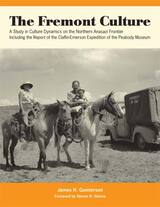 The Fremont Culture: A Study in Culture Dynamics on the Northern Anasazi Frontier, including the Report of the Claflin-Emerson Expedition of the Peabody Museum
James H Gunnerson
University of Utah Press, 2009 In 1927, the Claflin-Emerson expedition of the Peabody Museum began a rapid and extensive archaeological reconnaissance of eastern Utah. The expedition was funded by William H. Claflin and Raymond Emerson, Bostonian businessmen with a deep devotion to the American Indian and a probing interest in the remote and mysterious regions of the American West.
Early expedition surveys and excavations conducted by Noel Morss would lead to a definition of the Fremont culture; later research would augment existing data on the Fremont by adding entirely new traits, disclosing new variations in architecture and basketry, and providing new information on the distribution of previously known traits.
In The Fremont Culture: A Study in Culture Dynamics on the Northern Anasazi Frontier, archaeologist James H. Gunnerson provides the results of his 1950s survey and excavation in the Utah area. He presents a functional synthesis of the Fremont culture and discusses the dynamics of its growth and decline.
Gunnerson’s report also uses the original field notes, maps, plans, photographs, sketches, and unpublished preliminary reports of the Claflin-Emerson expedition. Together, the reports of Morss and Gunnerson offer the most important and complete overview of the expedition available. They are fitting tributes to the men of that expedition, scientists who recognized the importance of an ancient people who once wrested a meager living from the rugged canyon country of the Green and Colorado Rivers.
Fremont: Explorer For A Restless Nation
Ferol Egan
University of Nevada Press, 1985 Foreword by Richard Dillon. Between 1842 and 1853, John C. Fremont led five expeditions across the trans-Mississippi West. While the success of his early journeys gained him acclaim as a national hero, his later missions ended in tragedy and ultimately a court-martial. Historian Ferol Egan focuses on Fremont’s explorations, providing a vivid portrait of a courageous man in an emerging young nation.
French and Germans, Germans and French: A Personal Interpretation of France under Two Occupations, 1914–1918/1940–1944
Richard Cobb
Brandeis University Press, 2018 The noted historian Richard Cobb presents an engaging synthesis of research, combined with highly original observations and analyses of the war years in France. The reader is given access to a unique private chronicle of the relations between occupants and occupés, which provides the “I was there” understanding that is a hallmark of Cobb’s well-known ability to humanize history. The author characterizes this work as “an essay in interpretation and imagination, an evocation drawing heavily on literary, or semi-literary, sources and even on autobiography, rather than a straight piece of history. The book is about people, individuals, rather than about institutions and administration.” A recognized classic is now back in print.
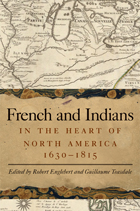 French and Indians in the Heart of North America, 1630-1815
Robert Englebert
Michigan State University Press, 2013 In the past thirty years, the study of French-Indian relations in the center of North America has emerged as an important field for examining the complex relationships that defined a vast geographical area, including the Great Lakes region, the Illinois Country, the Missouri River Valley, and Upper and Lower Louisiana. For years, no one better represented this emerging area of study than Jacqueline Peterson and Richard White, scholars who identified a world defined by miscegenation between French colonists and the native population, or métissage, and the unique process of cultural accommodation that led to a “middle ground” between French and Algonquians. Building on the research of Peterson, White, and Jay Gitlin, this collection of essays brings together new and established scholars from the United States, Canada, and France, to move beyond the paradigms of the middle ground and métissage. At the same time it seeks to demonstrate the rich variety of encounters that defined French and Indians in the heart of North America from 1630 to 1815. Capturing the complexity and nuance of these relations, the authors examine a number of thematic areas that provide a broader assessment of the historical bridge-building process, including ritual interactions, transatlantic connections, diplomatic relations, and post-New France French-Indian relations.
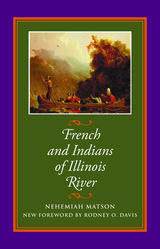 French and Indians of Illinois River
Nehemiah Matson. Foreword by Rodney O. Davis
Southern Illinois University Press, 2001 Complex and paradoxical, Nehemiah Matson (1816–1873) celebrated the occupation of the Middle West by European pioneers even as he labored to preserve the memory of the natives these pioneers replaced. He perpetuated the memory of the Indians who were driven out of the territory, but he nevertheless accumulated wealth selling their land to the pioneers. Rodney O. Davis notes in his new foreword to this book that Matson combined the attributes of a scholar with those of a salesman and promoter. Matson settled in Princeton, Illinois, in 1836. He left behind a library partially endowed by him, named for him, and finally completed in 1913. According to Davis, however, Matson’s other legacy, “of equal significance in his own eyes, consisted of the five books he authored on northern Illinois and Illinois River history and cartography, volumes based not only on conscientious scholarship but also on both Indian and white reminiscence and on local folklore.” Matson’s historical writings are valuable even when he deals with well-known events because his personal perspective makes his observations unique. Without the stories and reminiscences he collected, much valuable information would have been lost, especially since many of his informants, both Indian and European, were illiterate. Because his informants often told conflicting stories, Matson admitted that “harmonizing all conflicting accounts . . . has not been a success.” Although Matson’s sources may not always have agreed, and sometimes his heart may have overruled his head and colored his accounts, he was a conscientious and committed author. “Obviously,” Davis explains, “this book must be evaluated as what it is, a piece of colorful local history, romantically anchored in legend yet rooted also in invaluable research and produced by a dedicated amateur whose standards were high. . . . French and Indians of Illinois River is a model of its type, indeed a minor classic.”
 The French Apanages and the Capetian Monarchy, 1224-1328
Charles T. Wood
Harvard University Press An analytical study of the French apanages from their creation to the end of the Capetian period, this pioneering book offers an explanation of why the French kings began the practice of granting fiefs to their younger sons, and why they introduced the curious inheritance restrictions which limited succession in an apanage to direct heirs of the original holder. The author also examines the connection of the apanages with the royal government in terms of sovereignty, jurisdiction, administration, military obligations, and financial affairs, showing how difficult it was to draw distinctions between the two spheres of government.
Since the original apanages were granted from lands only recently conquered from the English, they had the important practical effect of introducing the notion of French royal authority into areas that had not known it for centuries. People living in these lands became used to the fact that "the king" was the king of France, not of England. A clear understanding of the relationship of the apanages to the monarchy, the author maintains, is at the same time a large step toward an understanding of how the monarchy gained control of France and,ultimately, made a nation out of her fragmented provinces.
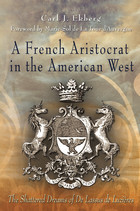 A French Aristocrat in the American West: The Shattered Dreams of De Lassus De Luzières
Carl J. Ekberg & Foreword by Marie-Sol de La Tour d'Auvergne
University of Missouri Press, 2010 In 1790, Pierre-Charles de Lassus de Luzières gathered his wife and children and fled Revolutionary France. His trek to America was prompted by his “purchase” of two thousand acres situated on the bank of the Ohio River from the Scioto Land Company—the institution that infamously swindled French buyers and sold them worthless titles to property. When de Luzières arrived and realized he had been defrauded, he chose, in a momentous decision, not to return home to France. Instead, he committed to a life in North America and began planning a move to the Mississippi River valley. De Luzières dreamed of creating a vast commercial empire that would stretch across the frontier, extending the entire length of the Ohio River and also down the Mississippi from Ste. Genevieve to New Orleans. Though his grandiose goal was never realized, de Luzières energetically pursued other important initiatives. He founded the city of New Bourbon in what is now Missouri and recruited American settlers to move westward across the Mississippi River. The highlight of his career was being appointed Spanish commandant of the New Bourbon District, and his 1797 census of that community is an invaluable historical document. De Luzières was a significant political player during the final years of the Spanish regime in Louisiana, but likely his greatest contributions to American history are his extensive commentaries on the Mississippi frontier at the close of the colonial era. A French Aristocrat in the American West: The Shattered Dreams of De Lassus de Luzières is both a narrative of this remarkable man’s life and a compilation of his extensive writings. In Part I of the book, author Carl Ekberg offers a thorough account of de Luzières, from his life in Pre-Revolutionary France to his death in 1806 in his house in New Bourbon. Part II is a compilation, in translation, of de Luzières’s most compelling correspondence. Until now very little of his writing has been published, despite the fact that his letters constitute one of the largest bodies of writing ever produced by a French émigré in North America. Though de Luzières’s presence in early American history has been largely overlooked by scholars, the work left behind by this unlikely frontiersman merits closer inspection. A French Aristocrat in the American West brings the words and deeds of this fascinating man to the public for the first time.
French as Language of Intimacy in the Modern Age: Le français, langue de l'intime à l'époque moderne et contemporaine
Edited by Madeleine van Strien-Chardonneau and Marie-Christine Kok Escalle
Amsterdam University Press, 2017 For centuries, French was the language of international commercial and diplomatic relations, a near-dominant language in literature and poetry, and was widely used in teaching. It even became the fashionable language of choice in the eighteenth and nineteenth centuries for upper class Dutch, Russians, Italians, Egyptians, and others for personal correspondence, travel journals, and memoirs. This book is the first to take a close look at how French was used in that latter context: outside of France, in personal and private life. It gathers contributions from historians, literary scholars, and linguists and covers a wide range of geographical areas.
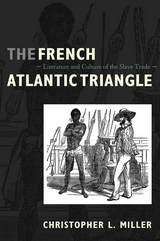 The French Atlantic Triangle: Literature and Culture of the Slave Trade
Christopher L. Miller
Duke University Press, 2008 The French slave trade forced more than one million Africans across the Atlantic to the islands of the Caribbean. It enabled France to establish Saint-Domingue, the single richest colony on earth, and it connected France, Africa, and the Caribbean permanently. Yet the impact of the slave trade on the cultures of France and its colonies has received surprisingly little attention. Until recently, France had not publicly acknowledged its history as a major slave-trading power. The distinguished scholar Christopher L. Miller proposes a thorough assessment of the French slave trade and its cultural ramifications, in a broad, circum-Atlantic inquiry. This magisterial work is the first comprehensive examination of the French Atlantic slave trade and its consequences as represented in the history, literature, and film of France and its former colonies in Africa and the Caribbean. Miller offers a historical introduction to the cultural and economic dynamics of the French slave trade, and he shows how Enlightenment thinkers such as Montesquieu and Voltaire mused about the enslavement of Africans, while Rousseau ignored it. He follows the twists and turns of attitude regarding the slave trade through the works of late-eighteenth- and early-nineteenth-century French writers, including Olympe de Gouges, Madame de Staël, Madame de Duras, Prosper Mérimée, and Eugène Sue. For these authors, the slave trade was variously an object of sentiment, a moral conundrum, or an entertaining high-seas “adventure.” Turning to twentieth-century literature and film, Miller describes how artists from Africa and the Caribbean—including the writers Aimé Césaire, Maryse Condé, and Edouard Glissant, and the filmmakers Ousmane Sembene, Guy Deslauriers, and Roger Gnoan M’Bala—have confronted the aftermath of France’s slave trade, attempting to bridge the gaps between silence and disclosure, forgetfulness and memory.
French Canadians in Michigan
John P. DuLong
Michigan State University Press, 2001 As the first European settlers in Michigan, the French Canadians left an indelible mark on the place names and early settlement patterns of the Great Lakes State. Because of its importance in the fur trade, many French Canadians migrated to Michigan, settling primarily along the Detroit- Illinois trade route, and throughout the fur trade avenues of the Straits of Mackinac. When the British conquered New France in 1763, most Europeans in Michigan were Francophones. John DuLong explores the history and influence of these early French Canadians, and traces, as well, the successive 19th- and 20th-century waves of industrial migration from Quebec, creating new communities outside the old fur trade routes of their ancestors.
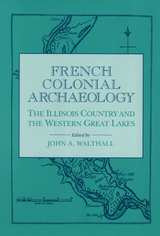 French Colonial Archaeology: The Illinois Country and the Western Great Lakes
Edited by John A. Walthall
University of Illinois Press, 1991 This wide-ranging book is the first to offer---in one volume---detailed
results of many of the investigations of French colonial sites made in
the mid-continent during the last decade. It includes work done at Fort
St. Louis, Fort de Chartres, Fort Massac, French Peoria, Cahokia, Prairie
du Pont, Prairie du Rocher, and other locations controlled by the French
during a time when their dominance in North America was more than twice
that of Britain and Spain combined.
Five of the book's fifteen chapters summarize major excavations at colonial
fortifications, four of which are public monuments that currently attract
thousands of visitors each year. Another five chapters deal with French
colonial villages, and the remainder of the book is devoted to diet, trade,
the role of historic documents in the reconstruction of life on the French
colonial frontier, and other topics.
 French Colonial Documentary: Mythologies of Humanitarianism
Peter J. Bloom
University of Minnesota Press, 2008 Despite altruistic goals, humanitarianism often propagates foreign, and sometimes unjust, power structures where it is employed. Tracing the visual rhetoric of French colonial humanitarianism, Peter J. Bloom’s unexpected analysis reveals how the project of remaking the colonies in the image of France was integral to its national identity.
French Colonial Documentary investigates how the promise of universal citizenship rights in France was projected onto the colonies as a form of evolutionary interventionism. Bloom focuses on the promotion of French education efforts, hygienic reform, and new agricultural techniques in the colonies as a means of renegotiating the social contract between citizens and the state on an international scale. Bloom’s insightful readings disclose the pervasiveness of colonial iconography, including the relationship between “natural man” and colonial subjectivity; representations of the Senegalese Sharpshooters as obedient, brave, and sexualized colonial subjects; and the appeal of exotic adventure narratives in the trans-Saharan film genre.
Examining the interconnection between French documentary realism and the colonial enterprise, Bloom demonstrates how the colonial archive is crucial to contemporary debates about multiculturalism in France.
Peter J. Bloom is associate professor of film and media studies at the University of California-Santa Barbara.y debates about multiculturalism in France.
French Colonial History 15
Kenneth J. Orosz
Michigan State University Press Journals, 2015 IN THIS ISSUE
Preface | Jeremy Rich
A Conflicted Sense of Nationality: Napoleon III’s Arab Kingdom and the Paradoxes of French Multiculturalism | Gavin Murray-Miller
Social Networks and Empire: Senegalese Students in France in the Late Nineteenth Century | Kelly Duke Bryant
The Mise en Valeur of the Gold Mines in the Haut-Niger, 1918–1939 | Sabine Luning, Jan Jansen, and Cristiana Panella
Belgium, the Congo, and Imperial Immobility: A Singular Empire and the Historiography of the Single Analytic Field | Matthew G. Stanard
The Missionary Réductions in New France: An Epistemological Problem with a Popular Historical Theory | Takao Abé
L’ordre public: Sully Brunet et les contradictions de la justice et de la politique dans l’Affaire Furcy (Ile Bourbon, 1817–1818) | Jérémy Boutie
French Colonial History 16
Kenneth J. Orosz
Michigan State University Press Journals, 2016 Preface
Articles
Barbara Traver “'The Benefıts of Their Liberty': Race and the Eurafricans of Gorée in Eighteenth-Century French Guiana"
Virginie Chaillou-Atrous, "La reprise de l’immigration africaine à La Réunion à la fın du XIXème siècle: de la traite déguisée à l’engagement de travail libre"
Jean-François Klein, "Industrialiser l’Indochine (1898–1900)?: Entre “petite patrie” lyonnaise et réseaux à l’échelle du monde"
Sally Low, "Les Tribunaux Résidentiels: Disputed Jurisdictions in the Protectorate of Cambodia"
French Colonial History 17
Kenneth J. Orosz
Michigan State University Press Journals, 2017 IN THIS ISSUE
Kenneth J. Orosz, "Preface"
Alice Bairoch de Sainte-Marie, "Loi, nationalité et mariages mixtes entre Français et autochtones: Le cas de l’arrêt du Conseil supérieur de la Louisiane du 18 décembre 1728"
Robert Englebert, "The Legacy of New France: Law and Social Cohesion between Quebec and the Illinois Country, 1763–1790"
Bonnie Stepenoff, "The Real 'Maid of Saint Phillippe': Kate Chopin’s French Colonial Heritage"
Dannelle Gutarra, "The Discourses of Sonthonax’s Mission in Saint-Domingue: The Coda to the Abolition of Slavery"
Phi Vân Nguyen, "The Vietnamization of Personalism: The Role of Missionaries in the Spread of Personalism in Vietnam, 1930–1961"
French Colonial History 18
Kenneth J. Orosz
Michigan State University Press Journals, 2019 In This Issue
Preface | Kenneth J. Orosz
Glory in the Memory of Men: Military Masculinities in the Mohawk Wars | Sandra Slater
The Lord and the Lawyer: Lord Durham, Edward Livingston, and Legal Accommodation in Louisiana | Julien Paul Vernet
« Ne visitez pas l’exposition coloniale! » La campagne contre l’exposition coloniale internationale de 1931, un moment anti-impérialiste | Vincent Bollenot
Assimilation, Association, and French Advice to Japan on How to Rule Taiwan | John L. Hennessey
Great Men in Greater France: Léon Poirier’s L’Appel du silence and Brazza, ou l’épopée du Congo | Owen White
French Colonial History 19
Kenneth J. Orosz
Michigan State University Press Journals, 2020 In This Issue
Kenneth J. Orosz, "Preface"
Guillaume Teasdale, "Statut social et prestige aux marges de l’Empire: Lamothe Cadillac et le Détroit du lac Érié"
Makhroufi Ousmane Traoré, "La diplomatie des femmes au coeur des rivalités impériales européennes et dans la traite atlantique en Afrique de l’Ouest, XVIIe-XVIIIe siècles"
Molly J. Giblin, "The Emperor’s Old Clothes: Chinese Objects and the Renaissance of French Imperialism"
Tran Thi Phuong Hoa, "Pragmatizing Schools: A History of Vocational Training in Colonial Vietnam"
Stanislas Frenkiel, "Pieds-noirs, têtes hautes: Une histoire des sélectionnés olympiques d’Algérie"
French Colonial History 20
Kenneth J. Orosz
Michigan State University Press Journals, 2021 In This Issue
Preface | Kenneth J. Orosz
St. Louis Once Was “P(a)in-Cour(t)”—But Was It Ever “Short of Bread”? | Pierre Gendreau-Hétu
Come Drive French North Africa: Cartographic and Guidebook Discourse in Michelin’s 1929 Maroc, Algérie, Tunisie | Kory Olson
« Une République s’étendant sur plusieurs continents » : le projet non advenu du Comité d’action pour une République fédérale française de 1957 | Vincent Houle
Special Section: World War II and Transnational Feminisms in the French Empire
Introduction | Emmanuelle Saada
World War II and the Rise of Feminism in Martinique | Annette K. Joseph-Gabriel
“I May Vote Like All Women”: Protest, Gender, and Suffrage in French Senegal, 1944–1945 | Emily Lord Fransee
“The Great Game of Hide and Seek Has Worked”: Suzanne Césaire, Cultural Marronnage, and a Caribbean Mosaic of Gendered Race Consciousness around World War II | Jennifer Anne Boittin
French Costume Drama of the 1950s: Fashioning Politics in Film
Susan Hayward
Intellect Books, 2010 When political and civil unrest threatened France’s social order in the 1950s, French cinema provided audiences a unique form of escapism from such troubled times: a nostalgic look back to the France of the nineteenth century, with costume dramas set in the age of Napoleon and the Belle Époque. Film critics, however, have routinely dismissed this period of French cinema, overlooking a very important period of political cultural history. French Costume Drama of the 1950s redresses this balance, exploring a diverse range of films including Guitry’s Napoléon (1955), Vernay’s Le Comte de Monte Cristo (1943), and Becker’s Casque d’Or (1952) to expose the political cultural paradox between nostalgia for a lost past and the drive for modernization.
 French Daguerreotypes
Janet E. Buerger
University of Chicago Press, 1989 Upon its introduction in 1839, the daguerreotype was hailed as a magical reflection of reality. Today, these early examples of the first practical photographic process offer fascinating windows into the past. The daguerreotypes collected here not only document the birth of photography and its aesthetic and historical legacy but also provide insight into French art and culture.
Lavishly illustrated, this volume is the first complete catalog of the French daguerreotype collection of the International Museum of Photography at George Eastman House. Janet E. Buerger uses this remarkable collection of images to produce a cultural history of the daguerreotype's most learned following—an elite group of mid-nineteenth-century intellectuals who sought to understand and develop the usefulness, potential, and beauty of this camera image. This varied group, including entrepreneurs, painters, scientists, and historians, enables Buerger to trace the influence of photography into virtually every area of nineteenth-century European intellectual life.
French DNA: Trouble in Purgatory
Paul Rabinow
University of Chicago Press, 1999 In 1993, an American biotechnology company and a French genetics lab developed a collaborative research plan to search for diabetes genes. But just as the project was to begin, the French government called it to a halt, barring the laboratory from sharing something never previously thought of as a commodity unto itself: French DNA.
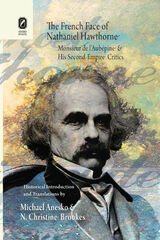 The French Face of Nathaniel Hawthorne: Monsieur de l'Aubépine and His Second Empire Critics
Michael Anesko and N. Christine Brookes
Ohio State University Press, 2011 Most students of American literature probably can recall the playful French nom de plume—Monsieur de l’Aubépine—that Nathaniel Hawthorne occasionally employed to disguise some of his early attempts at authorship. But very few will know that Monsieur de l’Aubépine enjoyed a surprisingly intelligent critical reception in France during his lifetime. No fewer than six—often startling—essays about the American author appeared in leading French periodicals from 1852 to 1864. The French Face of Nathaniel Hawthorne, edited by Michael Anesko and N. Christine Brookes, recuperates these lost (or forgotten) critical assessments, making available to English readers for the first time the full texts of these extraordinary contemporaneous French critical essays. Besides offering elegantly rendered (and helpfully annotated) translations of the essays, Anesko and Brookes analyze them in relation to their immediate historical context and examine their unexpected relevance to later critical trends and arguments. Literary scholarship in our own time calls more and more for the enlargement of perspective and the adaptation of our reading practices to dismantle the narrower limits of nationalist traditions. The French Face of Nathaniel Hawthorne is a remarkable body of work that can help scholars better understand
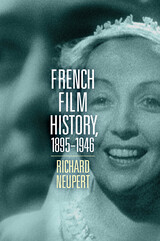 French Film History, 1895–1946
Richard Neupert
University of Wisconsin Press, 2022 French Film History, 1895–1946 addresses the creative and often unexpected trajectory of French cinema, which continues to be one of the most provocative and engaging cinemas in the world. Tracing French film and its developments from the earliest days, when France dominated world cinema, up through the Occupation and Liberation, Neupert outlines major players and films that made it so influential. Paris held a privileged position as one of the world’s hubs of scientific, social, and cultural experimentation; it is no wonder that the cinema as we know it was born there in the nineteenth century. This book presents French cinema’s most significant creative filmmakers and movies but also details the intricate relations between technology, economics, and government that helped shape the unique conditions for cinematic experimentation in the country.
Neupert explains the contexts behind the rise of cinema in France, including groundbreaking work by the Lumière family, Georges Méliès, and Alice Guy; the powerhouse studios of Pathé and Gaumont; directors such as René Clair, Germaine Dulac, Marcel Pagnol, and Jean Renoir; and an array of stars, including Max Linder, Jean Gabin, Josephine Baker, and Michèle Morgan. The first fifty years of French film practice established cinema’s cultural and artistic potential, setting the stage for the global post–World War II explosion in commercial movies and art cinema alike. French film and its rich history remain at the heart of cinematic storytelling and our moviegoing pleasure.
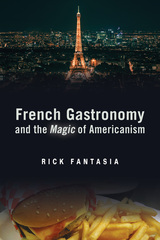 French Gastronomy and the Magic of Americanism
Rick Fantasia
Temple University Press, 2019 A tectonic shift has occurred in the gastronomic field in France, upsetting the cultural imagination. In a European country captivated by a high-stakes power struggle between chefs and restaurants in the culinary field, the mass marketing of factory-processed industrial cuisine and fast foods has created shock waves in French society, culture, and the economy. In this insightful book, French Gastronomy and the Magic of Americanism, Rick Fantasia examines how national identity and the dynamics of cultural meaning-making within gastronomy have changed during a crucial period of transformation, from the 1970s through the 1990s. He illuminates the tensions and surprising points of cooperation between the skill, expertise, tradition, artistry, and authenticity of grand chefs and the industrial practices of food production, preparation, and distribution. Fantasia examines the institutions and beliefs that have reinforced notions of French cultural supremacy—such as the rise and reverence of local cuisine—as well as the factors that subvert those notions, such as when famous French chefs lend their names to processed, frozen, and pre-packaged foods available at the supermarket. Ultimately, French Gastronomy and the Magic of Americanism shows what happens to a cultural field, like French gastronomy, when the logic and power of the economic field imposes itself upon it.
 A French Genocide: The Vendee
Reynald Secher
University of Notre Dame Press, 2003 A French Genocide: The Vendée provides a detailed narrative of the civil war in the Vendée region of western France, which lasted for much of the 1790s but was most intensely fought at the height of the Reign of Terror, from March 1793 to early 1795. In this shocking and controversial book, Reynald Secher argues that the massacres which resulted from the conflict between "patriotic" revolutionary forces and those of the counterrevolution were not the inevitable result of fierce battle, but rather were "premeditated, committed in cold blood, massive and systematic, and undertaken with the conscious and proclaimed will to destroy a well-defined region, and to exterminate an entire people." Drawing upon previously unavailable sources, Secher argues that more than 14 percent of the population and 18 percent of the housing stock in the Vendée was destroyed in this catastrophic conflict.
Secher's review of the social and political structure of the region presents a dramatically different image of the people of the Vendée than the stereotype common among historians favorable to the French Revolution. He demonstrates that they were not archaic and superstitious or even necessarily adverse to the forward-looking forces of the Revolution. Rather, the region turned against the Revolution because of a series of misguided policy choices that failed to satisfy the desire for reform and offended the religious sensibilities of the Vendéans.
Using an array of primary sources, many from provincial archives, including personal accounts and statistical data, Secher convincingly argues for a demythologized view of the French Revolution. Contrary to most twentieth-century academic accounts of the Revolution, which have either ignored, apologized for, or explained away the Vendée, Secher demonstrates that the vicious nature of this civil war is a key event that forces us to reconsider the revolutionary regime.
REYNALD SECHER is a scholar, businessman, and author of several books and articles. He produces historical videos, and is a specialist in the field of identity and national memory.
----------
"Secher's work is among the most significant accounts of the Revolution. This translation will be welcomed by American historians of France. It provides an important case study for readers interested in the relationships between religion, region, and political violence." --Thomas Kselman, University of Notre Dame
"In [this] controversial book, Reynald Secher takes some elements of the revisionist school and transforms them. . . . Secher sees in the violence a kind of precursor to the absolute ruthlessness of twentieth-century totalitarianism." --New York Times Book Review (Review of the French edition)
"Secher belongs to a school of French historians who view the French Revolution as the godfather of the harsh leftist regimes of Lenin, Stalin, Mao, and Pol Pot, and his work is a major contribution to this point of view. Through an exhaustive examination of obscure departmental archives and private parish records, Secher certainly proves that the French Reign of Terror was not restricted to the streets of Paris." --Library Journal
"Highly recommended. Important for all collections; accessible to general readers; of great interest to specialists." --Choice
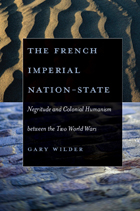 The French Imperial Nation-State: Negritude and Colonial Humanism between the Two World Wars
Gary Wilder
University of Chicago Press, 2005 France experienced a period of crisis following World War I when the relationship between the nation and its colonies became a subject of public debate. The French Imperial Nation-State focuses on two intersecting movements that redefined imperial politics—colonial humanism led by administrative reformers in West Africa and the Paris-based Negritude project, comprising African and Caribbean elites.
Gary Wilder develops a sophisticated account of the contradictory character of colonial government and examines the cultural nationalism of Negritude as a multifaceted movement rooted in an alternative black public sphere. He argues that interwar France must be understood as an imperial nation-state—an integrated sociopolitical system that linked a parliamentary republic to an administrative empire. An interdisciplinary study of colonial modernity combining French history, colonial studies, and social theory, The French Imperial Nation-State will compel readers to revise conventional assumptions about the distinctions between republicanism and racism, metropolitan and colonial societies, and national and transnational processes.
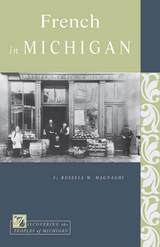 French in Michigan
Russell M. Magnaghi
Michigan State University Press, 2016 Compared to other nationalities, few French have immigrated to the United States, and the state of Michigan is no exception in that regard. Although the French came in small numbers, those who did settle in or pass through Michigan played important roles as either permanent residents or visitors.
The colonial French served as explorers, soldiers, missionaries, fur traders, and colonists. Later, French priests and nuns were influential in promoting Catholicism in the state and in developing schools and hospitals. Father Gabriel Richard fled the violence of the French Revolution and became a prominent and influential citizen of the state as a U.S. Congressman and one of the founders of the University of Michigan. French observers of Michigan life included Alexis de Tocqueville. French entrepreneurs opened copper mines and a variety of service-oriented businesses. Louis Fasquelle became the first foreign-language instructor at the University of Michigan, and François A. Artault introduced photography to the Upper Peninsula. As pioneers of the early automobile, the French made a major contribution to the language used in auto manufacturing.
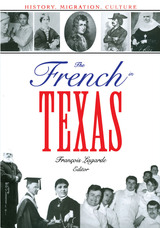 The French in Texas: History, Migration, Culture
Edited by François Lagarde
University of Texas Press, 2003 2005 — San Antonio Conservation Society Citation Original articles that explore the French presence and influence on Texas history, arts, education, religion, and business. The flag of France is one of the six flags that have flown over Texas, but all that many people know about the French presence in Texas is the ill-fated explorer Cavelier de La Salle, fabled pirate Jean Laffite, or Cajun music and food. Yet the French have made lasting contributions to Texas history and culture that deserve to be widely known and appreciated. In this book, François Lagarde and thirteen other experts present original articles that explore the French presence and influence on Texas history, arts, education, religion, and business from the arrival of La Salle in 1685 to 2002. Each article covers an important figure or event in the France-Texas story. The historical articles thoroughly investigate early French colonists and explorers, the French pirates and privateers, the Bonapartists of Champ-d'Asile, the French at the Alamo, Dubois de Saligny and French recognition of the Republic of Texas, the nineteenth-century utopists of Icaria and Reunion, and the French Catholic missions. Other articles deal with French immigration in Texas, including the founding of Castroville, Cajuns in Texas, and the French economic presence in Texas today (the first such study ever published). The remaining articles look at painters Théodore and Marie Gentilz, sculptor Raoul Josset, French architecture in Texas, French travelers from Théodore Pavie to Simone de Beauvoir who have written on Texas, and the French heritage in Texas education. More than seventy color and black-and-white illustrations complement the text.
 The French Institutionalists: Maurice Hauriou, Georges Renard, Joseph T. Delos
Albert Broderick
Harvard University Press, 1970 In tracing the evolution of the institutional conception of positive law, this volume makes an important contribution to the study of positive law. It also provides the first extensive translation of important writings on the theory of the institution, which has had continuing influence in France but has been known only by repute in English-speaking countries.
Supplementing the selections from the most significant works of Hauriou, Renard, and Delos are critiques that provide a contemporary focus to institutionalist thought. They include pieces by the noted jurists Jean Brèthe de la Gressaye, André Hauriou (the son), François and Bernard Geny, and Marcel Waline, as well as a retrospective essay prepared by Delos especially for this volume.
The writings themselves range over a number of areas--sociology, psychology, law, and philosophy--and they cover such subjects as juridical method, public law, individual rights and the state, Hauriou's famous "Notes" on decisions of the Conseil d'Etat, natural law, and the social order.
The French International Accounts, 1880-1913
Harry D. White
Harvard University Press This book is a detailed examination of the French international accounts made with a view to testing and verifying the theory of international trade, especially as regards the mechanism of adjustment. In the light of this instance, the neo-classical theory is critically examined, and some necessary modifications are considered. The importance of gold movements and capital exports in the French accounts renders the analysis of special significance to students of international trade. For the historian of pre-war French economics, the specially constructed price indices and the computation and evaluation of the changing terms of trade under which France exchanged her imports for her exports, as well as the discussion of the various items entering into the balance sheet, are significant.
French Joyce
Geert Lernout
University of Michigan Press, 1992 A major contribution to James Joyce studies, as well as a historical review of the French intellectual climate since the 1960s
 The French Labor Movement
Val R. Lorwin
Harvard University Press This comprehensive history of the French labor movement is notable for a number of reasons. It is a critical account of “unions in crisis” in a Democracy in crisis. It offers the only full description of the highly regulated collective bargaining system in France, and it shows why in France there are strikes against the Government as well as against private industry. It analyzes the Communist Party capture of the most influential labor combine—the General Federation of Labor—despite the fact that much of the rank and file do not concern themselves with political parties.
Val Lorwin gives his readers a good many reasons why the unfortunate situation which we know today has developed, and he provides a few indications as to how French labor may get out of the impasse into which it has slipped. He discusses the Government role in labor politics, and explains why French workers do not pay dues, and why poverty-stricken unions persist in striking. At the bottom of all French labor troubles, he points out, is the concept of class struggle; healthy, dynamic French economic growth will be achieved only when the labor unions adopt a more responsible position.
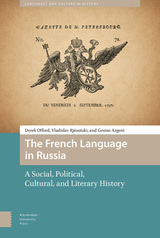 The French Language in Russia: A Social, Political, Cultural, and Literary History
Derek Offord, Vladislav Rjéoutski, and Gesine Argent
Amsterdam University Press, 2018 -- With support from the Arts and Humanities Research Council of the UK and the Deutsches Historisches Institut Moskau --
The French Language in Russia provides the fullest examination and discussion to date of the adoption of the French language by the elites of imperial Russia during the eighteenth and nineteenth centuries. It is interdisciplinary, approaching its subject from the angles of various kinds of history and historical sociolinguistics. Beyond its bearing on some of the grand narratives of Russian thought and literature, this book may afford more general insight into the social, political, cultural, and literary implications and effects of bilingualism in a speech community over a long period. It should also enlarge understanding of francophonie as a pan-European phenomenon. On the broadest plane, it has significance in an age of unprecedented global connectivity, for it invites us to look beyond the experience of a single nation and the social groups and individuals within it in order to discover how languages and the cultures and narratives associated with them have been shared across national boundaries.
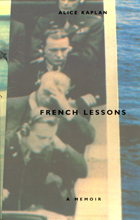 French Lessons: A Memoir
Alice Kaplan
University of Chicago Press, 1993 Brilliantly uniting the personal and the critical, French Lessons is a powerful autobiographical experiment. It tells the story of an American woman escaping into the French language and of a scholar and teacher coming to grips with her history of learning. Kaplan begins with a distinctly American quest for an imaginary France of the intelligence. But soon her infatuation with all things French comes up against the dark, unimagined recesses of French political and cultural life.
The daughter of a Jewish lawyer who prosecuted Nazi war criminals at Nuremburg, Kaplan grew up in the 1960s in the Midwest. After her father's death when she was seven, French became her way of "leaving home" and finding herself in another language and culture. In spare, midwestern prose, by turns intimate and wry, Kaplan describes how, as a student in a Swiss boarding school and later in a junior year abroad in Bordeaux, she passionately sought the French "r," attentively honed her accent, and learned the idioms of her French lover.
When, as a graduate student, her passion for French culture turned to the elegance and sophistication of its intellectual life, she found herself drawn to the language and style of the novelist Louis-Ferdinand Celine. At the same time she was repulsed by his anti-Semitism. At Yale in the late 70s, during the heyday of deconstruction she chose to transgress its apolitical purity and work on a subject "that made history impossible to ignore:" French fascist intellectuals. Kaplan's discussion of the "de Man affair" — the discovery that her brilliant and charismatic Yale professor had written compromising articles for the pro-Nazi Belgian press—and her personal account of the paradoxes of deconstruction are among the most compelling available on this subject.
French Lessons belongs in the company of Sartre's Words and the memoirs of Nathalie Sarraute, Annie Ernaux, and Eva Hoffman. No book so engrossingly conveys both the excitement of learning and the moral dilemmas of the intellectual life.
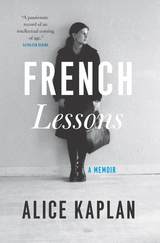 French Lessons: A Memoir
Alice Kaplan
University of Chicago Press, 2018 Brilliantly uniting the personal and the critical, French Lessons is a powerful autobiographical experiment. It tells the story of an American woman escaping into the French language and of a scholar and teacher coming to grips with her history of learning. Kaplan begins with a distinctly American quest for an imaginary France of the intelligence. But soon her infatuation with all things French comes up against the dark, unimagined recesses of French political and cultural life.
The daughter of a Jewish lawyer who prosecuted Nazi war criminals at Nuremburg, Kaplan grew up in the 1960s in the Midwest. After her father's death when she was seven, French became her way of "leaving home" and finding herself in another language and culture. In spare, midwestern prose, by turns intimate and wry, Kaplan describes how, as a student in a Swiss boarding school and later in a junior year abroad in Bordeaux, she passionately sought the French "r," attentively honed her accent, and learned the idioms of her French lover.
When, as a graduate student, her passion for French culture turned to the elegance and sophistication of its intellectual life, she found herself drawn to the language and style of the novelist Louis-Ferdinand Celine. At the same time she was repulsed by his anti-Semitism. At Yale in the late 70s, during the heyday of deconstruction she chose to transgress its apolitical purity and work on a subject "that made history impossible to ignore:" French fascist intellectuals. Kaplan's discussion of the "de Man affair" — the discovery that her brilliant and charismatic Yale professor had written compromising articles for the pro-Nazi Belgian press—and her personal account of the paradoxes of deconstruction are among the most compelling available on this subject.
French Lessons belongs in the company of Sartre's Words and the memoirs of Nathalie Sarraute, Annie Ernaux, and Eva Hoffman. No book so engrossingly conveys both the excitement of learning and the moral dilemmas of the intellectual life.
French Lessons in Late-Medieval England: The "Liber Donati" and "Commune Parlance"
Rory G. Critten
Arc Humanities Press, 2024 French Lessons in Late-Medieval England presents two fifteenth-century manuals designed to support facility in French among the English, the Liber donati and Commune parlance. These texts treat the grammar, lexis, and orthography of French as well as compiling a selection of entertaining dialogues that model the language in action. Together, they paint a vivid picture of the kinds of French that English learners might desire to wield and of the high levels of fluency that they could achieve. Critten's comprehensive introduction discusses his materials' relevance both for histories of language education and for recent reassessments of the longevity of French in medieval England. His pairing of first-time modern-English translations with facing-page original text makes these fascinating works newly available for a twenty-first-century audience.
French Modal Syntax in the Sixteenth Century
Newton S. Bement
University of Michigan Press, 1934 The French language was marked by significant shifts during the sixteenth century that would settle into more standardized usage thereafter. The purpose of this volume, a comparative grammar, is to discern transitions in modal syntax and to formulate the rules that governed it during that time. Major sections address rules regarding usage after declarative expressions; after expressions of emotion; after expressions of volition or necessity; in adverbial clauses of purpose; in consecutive clauses; in comparative clauses; in temporal adverbial clauses; in causative adverbial clauses; in adverbial clauses of concession; and a general summary of subjunctive usage.
French Modern: Norms and Forms of the Social Environment
Paul Rabinow
University of Chicago Press, 1995 In this study of space and power and knowledge in France from the 1830s through the 1930s, Rabinow uses the tools of anthropology, philosophy, and cultural criticism to examine how social environment was perceived and described. Ranging from epidemiology to the layout of colonial cities, he shows how modernity was revealed in urban planning, architecture, health and welfare administration, and social legislation.
French Policy in Japan during the Closing Years of the Tokugawa Regime
Meron Medzini
Harvard University Press, 1971 This first study of French policy in mid-nineteenth century Japan examines France’s position among the foreign powers in Japan and her loss of status in 1867 when Minister Leon Roches, who was attempting to revive France’s silk industry through the establishment of a steady flow of raw silk from Japan, read the Japanese political situation incorrectly.
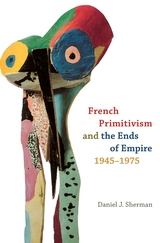 French Primitivism and the Ends of Empire, 1945-1975
Daniel J. Sherman
University of Chicago Press, 2011 For over a century, the idea of primitivism has motivated artistic modernism. Focusing on the three decades after World War II, known in France as “les trentes glorieuses” despite the loss of most of the country’s colonial empire, this probing and expansive book argues that primitivism played a key role in a French society marked by both economic growth and political turmoil. In a series of chapters that consider significant aspects of French culture—including the creation of new museums of French folklore and of African and Oceanic arts and the development of tourism against the backdrop of nuclear testing in French Polynesia—Daniel J. Sherman shows how primitivism, a collective fantasy born of the colonial encounter, proved adaptable to a postcolonial, inward-looking age of mass consumption. Following the likes of Claude Lévi-Strauss, Andrée Putman, and Jean Dubuffet through decorating magazines, museum galleries, and Tahiti’s pristine lagoons, this interdisciplinary study provides a new perspective on primitivism as a cultural phenomenon and offers fresh insights into the eccentric edges of contemporary French history.
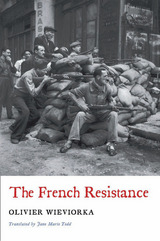 The French Resistance
Olivier Wieviorka
Harvard University Press, 2016 “Whatever happens, the flame of French resistance must not and will not go out.” As Charles de Gaulle ended his radio address to the French nation in June 1940, listeners must have felt a surge of patriotism tinged with uncertainty. Who would keep the flame burning through dark years of occupation? At what cost?
Olivier Wieviorka presents a comprehensive history of the French Resistance, synthesizing its social, political, and military aspects to offer fresh insights into its operation. Detailing the Resistance from the inside out, he reveals not one organization but many interlocking groups often at odds over goals, methods, and leadership. He debunks lingering myths, including the idea that the Resistance sprang up in response to the exhortations of de Gaulle’s Free French government-in-exile. The Resistance was homegrown, arising from the soil of French civil society. Resisters had to improvise in the fight against the Nazis and the collaborationist Vichy regime. They had no blueprint to follow, but resisters from all walks of life and across the political spectrum formed networks, organizing activities from printing newspapers to rescuing downed airmen to sabotage. Although the Resistance was never strong enough to fight the Germans openly, it provided the Allies invaluable intelligence, sowed havoc behind enemy lines on D-Day, and played a key role in Paris’s liberation.
Wieviorka shatters the conventional image of a united resistance with no interest in political power. But setting the record straight does not tarnish the legacy of its fighters, who braved Nazism without blinking.
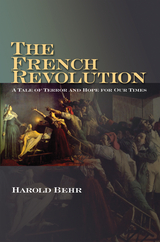 The French Revolution: A Tale of Terror and Hope for Our Times
Harold Behr
Sussex Academic Press, 2022 This is the story of the French Revolution told from a psychological and group dynamic perspective. The aim is to throw light on the workings of the revolutionary mind and the emotions at work in society which pave the way towards revolution and war. Louis XVI and Marie Antoinette are presented as a couple trapped by the symbolism invested in them, a circumstance that turned them into scapegoats. The contrasting personalities of the two most controversial leaders of the Revolution - Robespierre and Danton - provide psychologically informed explanations of their success and failure as leaders. The group perspective - the nature of crowd behaviour and mob violence - links to the complex relationship between leaders and groups. In the Parisian case of 1789 group emotions - fear, rage, euphoria and fervour - influenced the course of the Revolution. The assassination of Marat and the struggle to the death between the extremists of the Left and the Moderates is a classic study in group paranoia culminating in a Reign of Terror destined to end in self-destructive violence. The conflict between the Revolution and the Church as an expression of belief in an ideal society led to a battle for the minds of a people facing two incompatible ideologies. The French Revolution was an important milestone in western social and political development. It carried within itself the seeds of a humane society, but turned into murder and execution. The dichotomies arising echo down the generations. The same split in our thinking applies to how we view today's social upheavals and conflicts - conflicts of opposing mythologies with their psychological overtones interpreted as political doctrines - as evinced currently in Russia's territorial claims to Eastern Ukraine, Islamic fundamentalist wars, and the Israeli-Palestinian conflict. Hope lies in the application of therapeutic principles garnered from the field of group dynamics.
 The French Revolution and Enlightenment in England, 1789–1832
Seamus Deane
Harvard University Press, 1988 In the English response to the increasingly bloody French Revolution, Seamus Deane finds a new perspective on English political thought as well as a striking indication of the sharpening of national consciousness. Ranging widely among the major and lesser thinkers of the period, he has produced a complex picture of cultural affinity and national hostility. The group dominated by Edmund Burke, which included Southey, Wordsworth, and Carlyle, viewed the Revolution as the culmination of a great conspiracy, led by intellectuals, to overthrow all that was sacred and traditional. The radical group, led by Godwin, Shelley, and Hazlitt, welcomed the Revolution but were perturbed by its excesses.
The English debate about the French Revolution tended to focus on the specifically French characteristics that made it what it was, in sharp contrast to the culture and experience that produced the relatively peaceful English revolution of 1688. To see the Revolution as an essentially French phenomenon allowed it to be understood as alien to English circumstances and inclinations. This permitted the English to deny that its basic doctrines had any claim to universality and also led to an enhanced definition of the English national character. In his analysis of major writers, popular political novelists, and pamphleteers, Deane interprets the intellectual indebtedness of individual English writers to their French counterparts, reflects on the power of the written word to influence events, and dissects polemical styles and language. His book constitutes an important chapter of English intellectual history.
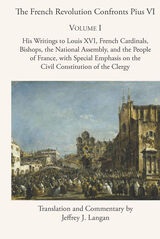 The French Revolution Confronts Pius VI: Volume 1: His Writings to Louis XVI, French Cardinals, Bishops, the National Assembly, and the People of France with Special Emphasis on the Civil Constitution of the Clergy
Jeffrey J. Langan
St. Augustine's Press, 2020 The writings of Pope Pius VI, head of the Catholic Church during the most destructive period of the French Revolution, were compiled in two volumes by M.N.S. Guillon and published in 1798 and 1800. But during the Revolution, the reign of Napoleon, and the various revolutionary movements of the 19th century, there were extraordinary efforts to destroy writings that critiqued the revolutionary ideology. Many books and treatises, if they survived the revolution or the sacking from Napoleon’s armies. To this day, no public copy of Guillon’s work exists in Paris.
Now, for the first time in English, these works comprising the letters, briefs, and other writings of Pius VI on the French Revolution are available. Volume I treats the first shock of the Revolution and the efforts of the Pope in 1790 and 1791 to oppose the Civil Constitution of the Clergy (which famous revolutionary and shrewd diplomat Talleyrand referred to as “the greatest fault of the National Assembly”). Volume II will be published later, and deals with the aftermath of the Civil Constitution through Pius’s death in exile). Editor and translator Jeffrey Langan presents the materials leading up to and directly connected with these decrees, in which the National Assembly attempted to set up a Catholic Church that would be completely submissive to the demands of the Assembly. Volume I also covers Pius’s efforts to deal with the immediate aftermath of the Constitution after the National Assembly implemented it, including his encyclical, Quod Aliquantum.
The letters will show how Pius chose to oppose the Civil Constitution. He did so not by a public campaign, for he had no real temporal power to oppose the violence, but by attempting to work personally with Louis XVI and various archbishops in France to articulate what were the points on which he could concede (matters dealing with the political structures of France) and what were the essential points in which he could not concede (matters dealing with the organization of dioceses and appointment of bishops).
Since the 1980s, with the writings and school that developed around François Furet, as well as Simon Schama’s Citizens, a new debate over the French Revolution has ensued, bringing forth a more objective account of the Revolution, one that avoids an excessively Marxist lens and that brings to light some of its defects and more gruesome parts – the destruction and theft of Church property, and the sadistic methods of torture and killing of priests, nuns, aristocrats, and fellow-revolutionaries.
An examination of the writings of Pius VI will not only help set the historical record straight for English-speaking students of the Revolution, it will also aid them to better understand the principles that the Catholic Church employs when confronted with chaotic political change. They will see that the Church has a principled approach to distinguishing, while not separating, the power of the Church and the power of the state. They will also see, as Talleyrand himself also saw, that one of the essential elements that makes the Church the Church is the right to appoint bishops and to discipline its own bishops. The Church herself recognizes that she cannot long survive without this principle that guarantees her unity.
Pius VI’s efforts were able to keep the Catholic Church intact (though badly bruised) so that she could reconstitute herself and build up a vibrant life in 19th-century France. (He did this in the face of the Church’s prestige having sunk to historic lows; some elites in Europe thought there would be no successor to Pius and jokingly referred to him as “Pius the Last.”) He began a process that led to the restoration of the prestige of the Papacy throughout the world, and he initiated a two-century process that led to the Church finally being able to select bishops without any interference from secular authorities. This had been at least a 1,000-year problem in the history of the Church. By 1990, only two countries of the world, China and Vietnam, were interfering in any significant way in the process that the Church used to select bishops.
Pius VI’s papacy, especially during the years of the French Revolution, was a pivotal point for the French Revolution and for the interaction between Church and state in Western history. All freedom-loving people will be happy to read his distinc-tions between the secular power and the spiritual power. His papacy also was important for the internal developments that the Church would make over the next 200 years with respect to its self-understanding of the Papacy and the role of the bishop.
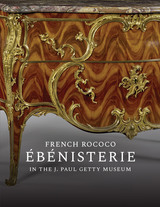 French Rococo Ébénisterie in the J. Paul Getty Museum
Gillian Wilson
J. Paul Getty Trust, The, 2021 The first comprehensive catalogue of the Getty Museum’s significant collection of French Rococo ébénisterie furniture. This catalogue focuses on French ébénisterie furniture in the Rococo style dating from 1735 to 1760. These splendid objects directly reflect the tastes of the Museum’s founder, J. Paul Getty, who started collecting in this area in 1938 and continued until his death in 1976.
The Museum’s collection is particularly rich in examples created by the most talented cabinet masters then active in Paris, including Bernard van Risenburgh II (after 1696–ca. 1766), Jacques Dubois (1694–1763), and Jean-François Oeben (1721–1763). Working for members of the French royal family and aristocracy, these craftsmen excelled at producing veneered and marquetried pieces of furniture (tables, cabinets, and chests of drawers) fashionable for their lavish surfaces, refined gilt-bronze mounts, and elaborate design. These objects were renowned throughout Europe at a time when Paris was considered the capital of good taste.
The entry on each work comprises both a curatorial section, with description and commentary, and a conservation report, with construction diagrams. An introduction by Anne-Lise Desmas traces the collection’s acquisition history, and two technical essays by Arlen Heginbotham present methodologies and findings on the analysis of gilt-bronze mounts and lacquer.
The free online edition of this open-access publication is available at www.getty.edu/publications/rococo/ and includes zoomable, high-resolution photography. Also available are free PDF, EPUB, and Kindle/MOBI downloads of the book, and JPG downloads of the main catalogue images.
French Roots: Adventures along the New Madrid Fault Line, 1811-1812
Norris Norman
Parkhurst Brothers, Inc., 2017 "Norris Norman has picked a very difficult subject for his book and has done wonders with it. There is probably no more obscure part of the history of Arkansas than the period in which this book is situated, namely, the second decade of the nineteenth century. Mr. Norman makes it come alive in a very convincing way. His main character, a French/Indian mixed-blood or metis, is carefully crafted and is ideally positioned to tell the tale of the New Madrid earthquake, the early White settlers of a newly-American Arkansas, and the daily lives of Indians and Europeans alike..." -- Hon. Morris S. Arnold, author of Unequal Laws Unto a Savage Race: European Legal Traditions in Arkansas 1686-1836
French Roots in the Illinois Country: The Mississippi Frontier in Colonial Times
Carl J. Ekberg
University of Illinois Press, 1998 Winner of the Kemper and Leila Williams Book Prize for the Best Book on Louisiana History, French Roots in the Illinois Country creates an entirely new picture of the Illinois country as a single ethnic, economic, and cultural entity. Focusing on the French Creole communities along the Mississippi River, Carl J. Ekberg shows how land use practices such as medieval-style open-field agriculture intersected with economic and social issues ranging from the flour trade between Illinois and New Orleans to the significance of the different mentalities of French Creoles and Anglo-Americans.
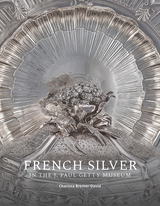 French Silver in the J. Paul Getty Museum
Charissa Bremer-David
J. Paul Getty Trust, The, 2023 Vividly illustrated, this is the first comprehensive catalogue of the J. Paul Getty Museum’s celebrated collection of seventeenth- and eighteenth-century French silver.
The collection of seventeenth- and eighteenth-century French silver at the J. Paul Getty Museum is of exceptional quality and state of preservation. Each piece is remarkable for its beauty, inventive form, skillful execution, illustrious provenance, and the renown of its maker. This volume is the first complete study of these exquisite objects, with more than 250 color photographs bringing into focus extraordinary details such as minuscule makers’ marks, inscriptions, and heraldic armorials.
The publication details the formation of the Museum’s collection of French silver, several pieces of which were selected by J. Paul Getty himself, and discusses the regulations of the historic Parisian guild of gold- and silversmiths that set quality controls and consumer protections. Comprehensive entries catalogue a total of thirty-three pieces with descriptions, provenance, exhibition history, and technical information. The related commentaries shed light on the function of these objects and the roles they played in the daily lives of their prosperous owners. The book also includes maker biographies and a full bibliography.
The free online edition of this open-access publication is available at getty.edu/publications/french-silver/ and includes 360-degree views and zoomable high-resolution photography. Also available are free PDF and EPUB downloads of the book, and JPG downloads of the main catalogue images.
 A French Slave in Nazi Germany: A Testimony
Elie Poulard
University of Notre Dame Press, 2016 The Required Work Service Law, or Service du Travail Obligatoire, was passed in 1943 by the Vichy government of France under German occupation. Passage of the law confirmed the French government’s willing collaboration in providing the Nazi regime with French manpower to replace German workers sent to fight in the war. The result was the deportation of 600,000 young Frenchmen to Germany, where they worked under the harshest conditions. Elie Poulard was one of the Frenchmen forced into labor by the Vichy government. Translated by his brother Jean V. Poulard, Elie’s memoir vividly captures the lives of a largely unrecognized group of people who suffered under the Nazis. He describes in great detail his ordeal at different work sites in the Ruhr region, the horrors that he witnessed, and the few Germans who were good to him. Through this account of one eyewitness on the ground, we gain a vivid picture of Allied bombing in the western part of Germany and its contribution to the gradual collapse and capitulation of Germany at the end of the war. Throughout his ordeal, Elie's Catholic faith, good humor, and perseverance sustained him.
Little has been published in French or English about the use of foreign workers by the Nazi regime and their fate. The Poulards’ book makes an important contribution to the historiography of World War II, with its firsthand account of what foreign workers endured when they were sent to Nazi Germany. The memoir concludes with an explanation of the ongoing controversy in France over the opposition to the title Déporté du Travail, which those who experienced this forced deportation, like Elie, gave themselves after the war.
“A French Slave in Nazi Germany: A Testimony addresses a significant though little-known page of French history during World War II. While many people know of the Vichy government and its collaboration with the Nazis—in particular the deportation of French Jews—few people realized then, and now, the extent of such collaboration. It would surprise many to learn that the Vichy government provided Germany with French citizens who were deported and forced into slave labor in wartime Germany. Poulard’s book confronts this unsavory part of French history and gives personal testimony to the terrible conditions under which the deported laborers existed.” —Michael Khodarkovsky, Loyola University Chicago
"The book vividly evokes the life of a young French man forcibly sent to work in Germany during World War II. Once the Vichy Government of France passed the Required Work Service Law in 1943, more than half a million young French men were deported to Germany where they worked in the harshest conditions to replace the German men sent to fight in the war. This testimony is particularly significant today, at a time when all aspects of the war are closely examined. The chapters about the effects of the Allied bombing in the western part of Germany are especially poignant as they allow the reader to witness the gradual collapse and final capitulation of the Nazi regime." —Thomas Pavel, Gordon J. Laing Distinguished Service Professor, University of Chicago
"This is a fascinating and depressing account of a young Frenchman sent by his own government to be a slave laborer in Nazi Germany. One can only have enormous respect for Elie Poulard, who persevered and kept his faith in the face of hardship and tragedy. He not only witnessed one of the darkest periods in modern history, but he survived it with cunning and dignity." —John J. Mearsheimer, author of Why Leaders Lie: The Truth about Lying in International Politics
"As the passage of time silences the voices of the Second World War generation, we are grateful to have the memories of Elie Poulard. A French Slave in Nazi Germany tells the story of how Elie Poulard’s faith helped him endure the many years of suffering as a Déporté du Travail. His eloquent and gripping tale is testament to the abiding power of the human will in the face of adversity." — Michael Creswell, author of A Question of Balance: How France and the United States Created Cold War Europe
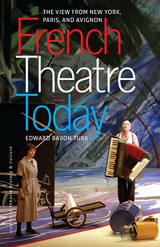 French Theatre Today: The View from New York, Paris, and Avignon
Turk, Edward B.
University of Iowa Press, 2011 @font-face { font-family: "Times";}@font-face { font-family: "Palatino";}p.MsoNormal, li.MsoNormal, div.MsoNormal { margin: 0in 0in 0.0001pt; font-size: 12pt; font-family: "Times New Roman"; }div.Section1 { page: Section1; } In 2005 literary and film critic Edward Turk immersed himself in New York City’s ACT FRENCH festival, a bold effort to enhance American contact with the contemporary French stage. This dizzying crash course on numerous aspects of current French theatre paved the way for six months of theatregoing in Paris and a month’s sojourn at the 2006 Avignon Festival. In French Theatre Today he turns his yearlong involvement with this rich topic into an accessible, intelligent, and comprehensive overview of contemporary French theatre. Situating many of the nearly 150 stage pieces he attended within contexts and timeframes that stretch backward and forward over a number of years, he reveals French theatre during the first decade of the twenty-first century to be remarkably vital, inclined toward both innovation and concern for its audience, and as open to international influence as it is respectful of national tradition. French Theatre Today provides a seamless mix of critical analysis with lively description, theoretical considerations with reflexive remarks by the theatremakers themselves, and matters of current French and American cultural politics. In the first part, “New York,” Turk offers close-ups of French theatre works singled out during the ACT FRENCH festival for their presumed attractiveness to American audiences and critics. The second part, “Paris,” depicts a more expansive range of French theatre pieces as they play out on their own soil. In the third part, “Avignon,” Turk captures the subject within a more fluid context that is, most interestingly, both eminently French and resolutely international. The Paris and Avignon chapters contain valuable and well-informed contextual and background information as well as descriptions of the milieus of the Avignon Festival and the various neighborhoods in Paris where he attended performances, information that readers cannot find easily elsewhere. Finally, in the spirit of inclusiveness that characterizes so much new French theatre and to give a representative account of his own experiences as a spectator, Turk rounds out his survey with observations on Paris’s lively opera scene and France’s wealth of circus entertainments, both traditional and newly envisioned With his shrewd assessments of contemporary French theatre, Turk conveys an excitement and an affection for his topic destined to arouse similar responses in his readers. His book’s freshness and openness will reward theatre enthusiasts who are curious about an aspect of French culture that is inadequately known in this country, veteran scholars and students of contemporary world theatre, and those American theatre professionals who have the ultimate authority and good fortune to determine which new French works will reach audie
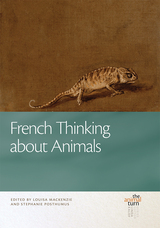 French Thinking about Animals
Louisa Mackenzie
Michigan State University Press, 2015 Bringing together leading scholars from Belgium, Canada, France, and the United States, French Thinking about Animals makes available for the first time to an Anglophone readership a rich variety of interdisciplinary approaches to the animal question in France. While the work of French thinkers such as Jacques Derrida, Gilles Deleuze, and Felix Guattari has been available in English for many years, French Thinking about Animals opens up a much broader cross-cultural dialogue within animal studies. These original essays, many of which have been translated especially for this volume, draw on anthropology, ethology, geography, history, legal studies, phenomenology, and philosophy to interrogate human-animal relationships. They explore the many ways in which animals signify in French history, society, and intellectual history, illustrating the exciting new perspectives being developed about the animal question in the French-speaking world today. Built on the strength and diversity of these contributions, French Thinking about Animals demonstrates the interdisciplinary and internationalism that are needed if we hope to transform the interactions of humans and nonhuman animals in contemporary society.
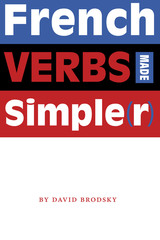 French Verbs Made Simple(r)
By David Brodsky
University of Texas Press, 2006 It's time for a new approach to learning French verbs. Unlike popular verb guides that require the rote memorization of hundreds of verb forms, this book clearly explains the rules that govern the conjugation of all classes of French verbs—especially the irregular ones that give second-language learners the most trouble. These straightforward, easy-to-understand rules for conjugating French verbs are effective learning tools for both beginning students and more advanced speakers who want to perfect their usage of French verb forms. French Verbs Made Simple(r) has many helpful features that you won't find in any other verb guide: - Clear explanations of all verb tenses and forms.
- The simple patterns and rules that govern the conjugation of all verbs—including those verbs whose irregularities follow patterns that can be easily learned.
- A detailed discussion of how each verb form is used, with numerous examples.
- A full explanation of whether a verb should be conjugated with avoir or être, and the conditions under which the past participle is variable—two of the thorniest problems for students of French.
- An extended treatment of the subjunctive that will help you understand why it is used in some situations but not others.
- Complete conjugations for 57 basic model verbs (along with 27 "variants") and a comprehensive listing of some 6,200 verbs that indicates which of the models each verb follows.
Going well beyond any other guide in the clarity and detail of its explanations—as well as the innovative manner in which individual verbs are linked to model conjugations—French Verbs Made Simple(r) is the only guide to French verbs a learner needs.
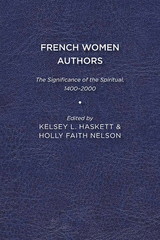 French Women Authors: The Significance of the Spiritual, 1400–2000
Kelsey L. Haskett
University of Delaware Press, 2013 French Women Authors examines the importance afforded the spiritual in the lives and works of French women authors over the centuries, thereby highlighting both the significance of spiritually informed writings in French literature in general, as well as the specific contribution made by women writers. Eleven different authors have been selected for this collection, representing major literary periods from the medieval to the (post)modern. Each author is examined in the light of a Christian worldview, creating an approach which both validates and interrogates the spiritual dimension of the works under consideration. At the same time, the book as a whole presents a broad perspective on French women writers, showing how they reflect or stand in opposition to their times. The chronological order of the chapters reveals an evolution in the modes of spirituality expressed by these authors and in the role of spiritual belief or religion in French society over time. From the overwhelmingly Christian culture of the Middle Ages and pre-Enlightenment France to the wide diversity prevalent in (post)modern times, including the rise of Islam within French borders, a radical shift has permeated French society, a shift that is reflected in the writers chosen for this book. Moreover, the sensitivity of women writers to the individual side of spiritual life, in contrast with the practices of organized religion, also emerges as a major trend in this book, with women often being seen as a voice for social and religious change, or for a more meaningful, personal faith. Lastly, despite a blatant rejection of God and religion, spiritual threads still run through the works of one of France’s most celebrated contemporary writers (Marguerite Duras), whose cry for an absolute in the midst of a spiritual vacuum only reiterates the quest for transcendence or for some form of spiritual expression, as voiced in the works of her female predecessors and contemporaries in France, and as demonstrated in this book.
Published by University of Delaware Press. Distributed worldwide by Rutgers University Press.
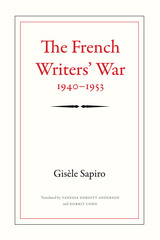 The French Writers' War, 1940-1953
Gisèle Sapiro
Duke University Press, 2014 The French Writers' War, 1940–1953, is a remarkably thorough account of French writers and literary institutions from the beginning of the German Occupation through France's passage of amnesty laws in the early 1950s. To understand how the Occupation affected French literary production as a whole, Gisèle Sapiro uses Pierre Bourdieu's notion of the "literary field." Sapiro surveyed the career trajectories and literary and political positions of 185 writers. She found that writers' stances in relation to the Vichy regime are best explained in terms of institutional and structural factors, rather than ideology. Examining four major French literary institutions, from the conservative French Academy to the Comité national des écrivains, a group formed in 1941 to resist the Occupation, she chronicles the institutions' histories before turning to the ways that they influenced writers' political positions. Sapiro shows how significant institutions and individuals within France's literary field exacerbated their loss of independence or found ways of resisting during the war and Occupation, as well as how they were perceived after Liberation.
The French-Canadian Heritage in New England
Gerard J. Brault
University Press of New England, 1986 A comprehensive historical, sociological, and cultural introduction to the sizable Franco-American population in New England.
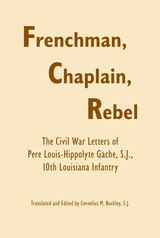 Frenchman, Chaplain, Rebel: The Civil War Letters of Pere Louis-Hippoltye Gache, 10th Louisiana Infantry
Pere Louis-Hippolyte Gache, S.J.
University of Alabama Press, 2007 The American Civil War through the eyes of a French Jesuit chaplain.
"This book has a tantalizing quality, and it certainly is fresh literature for those who have watched the story of the Civil War unfold. . . . One cannot help but marvel at the research undertaken by Fr. Buckley. These letters of Fr. Gache cover such subjects as the duties of a chaplain, the lack of stimulating conversation in camp, whiskey as medication for diarrhea, the chaplain’s uniform, the oversupply of Catholic chaplains, descriptions of battles—Chancellorsville, Fredericksburg—chaplains as prisoners of war, the possibility of General Lee being chosen as the second president of the Confederacy, making candles for the alter and bleaching wax, procuring sacramental wine, conflicts with Protestant preachers, and the surrender of Richmond. Such subjects allow the personality and character of Hippolyte to stand out. . . . [The book] is interesting reading for all who love and admire the Jesuits. Its wealth of information makes it a must for others whose concern is the Confederate soldier and his God."
—Journal of Southern History
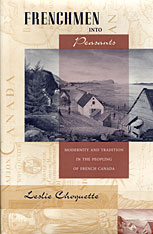 Frenchmen into Peasants: Modernity and Tradition in the Peopling of French Canada
Leslie P. Choquette
Harvard University Press, 1997 In unprecedented detail, Leslie Choquette narrates the peopling of French Canada across the seventeenth and eighteenth centuries, the lesser known colonial phase of French migration. Drawing on French and Canadian archives, she carefully traces the precise origins of individual immigrants, describing them by gender, class, occupation, region, religion, age, and date of departure. Her archival work is impressive: of the more than 30,000 emigrants who embarked for Quebec and the Maritimes during the French Regime, nearly 16,000 are chronicled here.
In considering the pattern of emigration in the context of migration history, Choquette shows that, in many ways, the movement toward Canada occurred as a byproduct of other, perennial movements, such as the rural exodus or interurban labor migrations. Overall, emigrants to Canada belonged to an outwardly turned and mobile sector of French society, and their migration took place during a phase of vigorous Atlantic expansion. They crossed the ocean to establish a subsistence economy and peasant society, traces of which lingered on into the twentieth century.
Because Choquette looks at the entire history of French migration to Canada—its social and economic aspects as well as its place in the larger history of migration—her work makes a remarkable contribution in the field of immigration history.
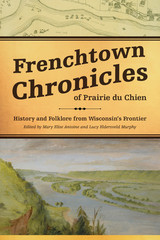 Frenchtown Chronicles of Prairie du Chien: History and Folklore from Wisconsin's Frontier
Mary Elise Antoine
Wisconsin Historical Society Press, 2016 Albert Coryer, the grandson of a fur trade voyageur-turned-farmer, had a gift for storytelling. Born in 1877, he grew up in Prairie du Chien hearing tales of days gone by from his parents, grandparents, and neighbors who lived in the Frenchtown area. Throughout his life, Albert soaked up the local oral traditions, including narratives about early residents, local landmarks, interesting and funny events, ethnic customs, myths, and folklore. Late in life, this lively man who had worked as a farm laborer and janitor drew a detailed illustrated map of the Prairie du Chien area and began to write his stories out longhand, in addition to sharing them in an interview with a local historian and folklore scholar. The map, stories, and interview transcript provide a colorful account of Prairie du Chien in the late nineteenth century, when it was undergoing significant demographic, social, and economic change. With sharp historical context provided by editors Lucy Eldersveld Murphy and Mary Elise Antoine, Coryer’s tales offer an unparalleled window into the ethnic community comprised of the old fur trade families, Native Americans, French Canadian farmers, and their descendants.
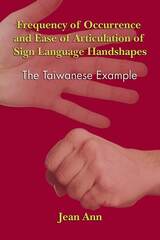 Frequency of Occurrence and Ease of Articulation of Sign Language Handshapes: The Taiwanese Example
Jean Ann
Gallaudet University Press, 2006 In the growing body of research on sign language linguistics, one area of inquiry considers an important component of all sign languages — handshapes — and whether the use of specific kinds increase in direct relation to the ease of their formation. Author Jean Ann provides significant clarification in her book Frequency of Occurrence and Ease of Articulation of Sign Language Handshapes: The Taiwanese Example.
Ann employs a straightforward methodology in her examination of the use of Taiwan Sign Language (TSL) handshapes in five succinct chapters. In the first chapter, she discusses the two approaches linguists have taken toward understanding languages, and how these theories have influenced sign language researchers’ consideration of the ease of articulation and frequency of handshapes. In her second chapter, Ann delineates the physiology of hands and explains why certain digits move with greater dexterity than others.
Ann applies this physiological information in the third chapter to construct a model for determining the ease of articulation of any logically possible handshape. She divides the handshapes into three categories, ranging from impossible to easy. In the fourth chapter, she applies her model to examine the patterns of TSL, first by describing the 56 handshapes identified in TSL, then determining how often each is used. She then compares the usage data to the handshapes’ ease of formation. The final chapter summarizes her findings and suggests implications of this work that are bound to generate further speculation and study on sign language handshapes in the future.
Frequency-Domain Control Design for High-Performance Systems
John O'Brien
The Institution of Engineering and Technology, 2012 Frequency-Domain Control Design for High-Performance Systems serves as a practical guide for the control engineer, and attempts to bridge the gap between industrial and academic control theory. Frequency-domain techniques rooted in classical control theory are presented with new approaches in nonlinear compensation that result in robust, high-performance closed-loop systems. Illustrative examples using data from actual control designs are included.
Frescobaldi Studies
Alexander Silbiger, ed.
Duke University Press, 1987 Girolamo Frescobaldi (1583–1643) occupies a special place in the history of music as the first significant European composer who concentrated his major creative efforts into the realm of instrumental music. In this collection of papers based on the Quadricentennial Frescobaldi Studies Conference, sixteen American and European specialists examine important aspects of the life and works of this composer and of his role in the creation of a new musical language of the Baroque.
 The Frescoed Façade in Renaissance Roman Visual Culture
Alexis Culotta
Amsterdam University Press, 2025 This book examines Roman façades decorated with fresco and sgraffito between the fifteenth and sixteenth centuries that once enveloped the central rioni of Rome within a web of symbolic social, political, and familial allegiances that transformed a street-side stroll into a visually engaging experience. Today, many of these faces are lost, and our understanding of what they comprised is frighteningly incomplete. This book offers a refreshed look at this often-forgotten facet of Renaissance visual culture to reignite interest in the tradition before its last remnants disappear. In addition to offering a new compilation of these documented façades, this book also places new emphasis on the making and meaning of these “painted faces” to provide new insights into the place of the decorated façade at the intersections of patron identity and painterly innovation in a city working tirelessly to reinvent itself.
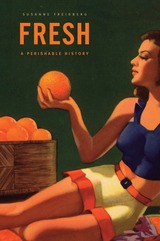 Fresh: A Perishable History
Susanne Freidberg
Harvard University Press, 2010 That rosy tomato perched on your plate in December is at the end of a great journey—not just over land and sea, but across a vast and varied cultural history. This is the territory charted in Fresh. Opening the door of an ordinary refrigerator, it tells the curious story of the quality stored inside: freshness.
We want fresh foods to keep us healthy, and to connect us to nature and community. We also want them convenient, pretty, and cheap. Fresh traces our paradoxical hunger to its roots in the rise of mass consumption, when freshness seemed both proof of and an antidote to progress. Susanne Freidberg begins with refrigeration, a trend as controversial at the turn of the twentieth century as genetically modified crops are today. Consumers blamed cold storage for high prices and rotten eggs but, ultimately, aggressive marketing, advances in technology, and new ideas about health and hygiene overcame this distrust.
Freidberg then takes six common foods from the refrigerator to discover what each has to say about our notions of freshness. Fruit, for instance, shows why beauty trumped taste at a surprisingly early date. In the case of fish, we see how the value of a living, quivering catch has ironically hastened the death of species. And of all supermarket staples, why has milk remained the most stubbornly local? Local livelihoods; global trade; the politics of taste, community, and environmental change: all enter into this lively, surprising, yet sobering tale about the nature and cost of our hunger for freshness.
 Fresh Blood: THE NEW AMERICAN IMMIGRANTS
Sanford J. Ungar
University of Illinois Press, 1998 Drawing on hundreds of richly textured interviews conducted from one
end of the country to the other, veteran journalist Sanford J. Ungar documents
the real-life struggles and triumphs of America's newest immigrants. He
finds that the self-chosen who arrive every day, most of them legally,
still enrich our national character and experience and make invaluable
political, economic, social, cultural, and even gastronomic contributions.
"First-class journalism, a book scholars will use decades from now
to find out what it 'felt like' to be an immigrant in the 90s. I do not
know of a better description and analysis of contemporary immigration."
-- Roger Daniels, author of Coming to America: A History of Immigration
and Ethnicity in American Life
"An excellent overview of contemporary immigration issues set within
the context of developments in the past fifty years. Ungar makes a strong
case for the contributions of recent immigrants and for maintaining a
relatively open door in the face of sometimes shrill opposition."
-- Thomas Dublin, editor of Immigrant Voices: New Lives in America
"Exactly the right book at the right time. [Ungar] looks at the
national controversy over immigration policy with a clear eye, producing
a history and a convincing argument why this is no time to reverse a liberal
welcome to newcomers that has always—in good times and bad—made
this a better and more prosperous democracy." -- Ben H. Bagdikian,
author of Double Vision
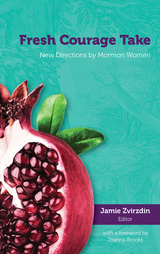 Fresh Courage Take: New Directions by Mormon Women
Jamie Zvirzdin
Signature Books, 2015
The twelve essays in this anthology provide a refreshing array of female perspectives, personalities, and circumstances. Along with an introduction by Jamie Zvirzdin, the essays invite readers to recognize and own their personal struggles, gifts, faults, and desires and to accept where they stand on the spectrum of humanity. Fresh Courage Take demonstrates that the road to heaven is not a conveyor belt powered by a checklist of religious obligations, cooked casseroles, and a collection of children. If anything, it is a complex network of interchanges and decisions … including long, often solitary paths.
The authors span a wide range of views and situations in life: politically conservative to progressive, single to married with many children, highly educated to working-class, stay-at-home moms to the professionally successful, of European or African heritage, religiously orthodox to heterodox. In short, they define, from their diversity, what being a Mormon woman means and what type of path they feel they must take to be true to themselves and their beliefs.
Authors include Carli Anderson, Rachael Decker Bailey, Erika Ball, Rachel Brown, Karen Critchfield, Ashley Mae Hoiland, Sylvia Lankford, Marcee Ludlow, Brooke Stoneman, Camille Strate Fairbanks, Colleen Whitley, and Jamie Zvirzdin.
A Fresh Map of Life: The Emergence of the Third Age
Peter Laslett
Harvard University Press, 1991 The prospect of spending long years in reasonable health and scarcely impaired activity, far beyond the convenient landmark of retirement, has already become the norm—without anybody really noticing it, let alone appreciating the implications. In this highly original and perhaps controversial book, Peter Laslett urges us to plan ahead for personal enrichment—before retirement and before the children leave home—before we reach the Third Age.
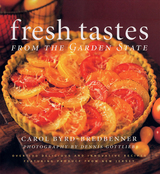 Fresh Tastes from the Garden State
Byrd-Bredbenner, Carol
Rutgers University Press, 2002 With this cookbook you will have the pleasure of preparing recipes that showcase the delicious bounty of fruit and vegetables that come from New Jersey’s gardens, orchards, and farmstands. While it is the country’s fifth-smallest state, the appropriately named Garden State produces tons of succulent produce every year. What a feast for the senses! The state is ablaze with colors—picture vivid green peppers and inky blueberries. Imagine the intense pleasure of biting into a juicy red tomato or a crisp, tangy apple. Think about the scent of strawberries or the sweet flavor of corn-on-the-cob. Recall the feel of plump, fuzzy peaches and smooth slick cranberries.
Fresh Tastes from the Garden State presents new ways for you to savor the flavors of New Jersey’s top fruits and vegetables and capitalize on the health dividends they pay. Presented in an easy-to-use format, the book features dozens of color photographs. It is conveniently divided into chapters brimming with luscious recipes spotlighting New Jersey berries (strawberries, blueberries, and cranberries), peaches, apples, tomatoes, peppers, and corn. Many of the recipes are quick and easy enough to fit into anyone’s hectic lifestyle and so delectable they’ll become family favorites for everyday. Health-conscious cooks will be happy to know that fat is never used gratuitously and the calorie and nutrient content of each recipe is included. Carol Byrd-Bredbenner also includes information on the history, botany, and safe storage of fruits and vegetables. Every recipe has been kitchen tested and tasted by discerning diners to be certain that they are absolutely delicious. When you serve them, you’ll hear forks clanking, lips smacking, and rave reviews. Enjoy!
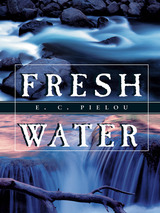 Fresh Water
E. C. Pielou
University of Chicago Press, 1998 With the eye of a professional scientist and the passion of a dedicated amateur, E. C. Pielou conducts a guided tour of fresh water on its course through the natural world. As the world's supply of clean, fresh water continues to dwindle, it becomes increasingly important to understand the close connection between water and all forms of life. Pielou's fascination with fresh water gives us a "natural history" that is remarkable and surprising.
"[A] keen and detailed look at the life and history of fresh water. . . . Dip into Fresh Water. It will both stimulate and satisfy as only good natural history can."—Toronto Globe and Mail
"Pielou's ease with her subject and her no-nonsense style of writing will satisfy and inspire the poet as well as the naturalist."—Denize Springer, Express Books
"[Pielou's] writing is didactic and definitive, in places even charming, and is buttressed by clear illustrations. . . . A welcome addition to the genre of literature designed to bridge the gap between scientists . . . and the intelligent and concerned lay public."—Daniel Hillel, Nature
"A wonderful natural history of one of life's necessities, a refreshing break from the grand theory and special pleading of many a science book. . . . Read it."—Fred Pearce, New Scientist
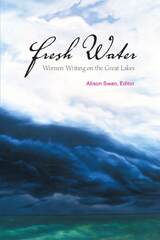 Fresh Water: Women Writing on the Great Lakes
Alison Swan
Michigan State University Press, 2006 Fresh Water: Women Writing on the Great Lakes is a collection of nonfiction works by women writers. These works focus on the Midwest: living with the five interconnected freshwater seas that we know as the Great Lakes. Contributing to this collection are renowned poets, essayists, and fiction writers, all of whom write about their own creative streams of consciousness, the fresh waters of the Great Lakes, and the region's many rivers: Loraine Anderson, Judith Arcana, Rachel Azima, Mary Blocksma, Gayle Boss, Sharon Dilworth, Beth Ann Fennelly, Linda Nemec Foster, Gail Griffin, Rasma Haidri, Aleta Karstad, Laura Kasischke, Janet Kauffman, Jacqueline Kolosov, Susan Laidlaw, Lisa Lenzo, Linda Loomis, Anna Mills, Stephanie Mills, Judith Minty, Anne-Marie Oomen, Rachael Perry, Susan Power, Donna Seaman, Heather Sellers, Gail Louise Siegel, Sue William Silverman,Claudia Skutar, Annick Smith, Leslie Stainton, Kathleen Stocking, Judith Strasser, Alison Swan, Elizabeth A.Trembley, Jane Urquhart, Diane Wakoski, and Leigh Allison Wilson.
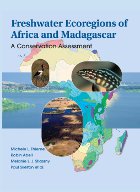 Freshwater Ecoregions of Africa and Madagascar: A Conservation Assessment
Michele L. Thieme, Robin Abell, Melanie L. J. Stiassny, and Paul Skelton
Island Press, 2005 As part of a global effort to identify those areas where conservation measures are needed most urgently, World Wildlife Fund has assembled teams of scientists to conduct ecological assessments of all seven continents. Freshwater Ecoregions of Africa and Madagascar is the latest contribution, presenting in a single volume the first in-depth analysis of the state of freshwater biodiversity across Africa, Madagascar, and the islands of the region. Looking at biodiversity and threats in terms of biological units rather than political units, the book offers a comprehensive examination of the entire range of aquatic systems.
In addition to its six main chapters, the book includes nineteen essays by regional experts that provide more depth on key issues, as well as six detailed appendixes that present summary data used in the analyses, specific analytical methodologies, and a thorough text description for each of Africa's ninety-three freshwater ecoregions.
Freshwater Ecoregions of Africa and Madagascar provides a blueprint for conservation action and represents an unparalleled guide for investments and activities of conservation agencies and donor organizations.
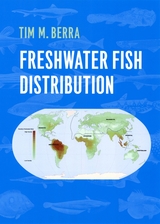 Freshwater Fish Distribution
Tim M. Berra
University of Chicago Press, 2007 With more than 29,000 species, fishes are the most diverse group of vertebrates on the planet. Of that number, more than 12,000 species are found in freshwater ecosystems, which occupy less than 1 percent of the Earth’s surface and contain only 2.4 percent of plant and animal species. But, on a hectare-for-hectare basis, freshwater ecosystems are richer in species than more extensive terrestrial and marine habitats. Examination of the distribution patterns of fishes in these fresh waters reveals much about continental movements and climate changes and has long been critical to biogeographical studies and research in ecology and evolution.
Tim Berra’s seminal resource, Freshwater Fish Distribution,maps the 169 fish families that swim in fresh water around the world. Each family account includes the class, subclass, and order; a pronunciation guide to the family name; life cycle information; and interesting natural history facts. Each account is illustrated, many with historical nineteenth-century woodcuts.
Now available in paperback, this heavily cited work in ichthyology and biogeography will serve as a reference for students, a research support for professors, and a helpful guide to tropical fish hobbyists and anglers.
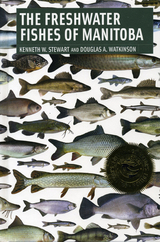 Freshwater Fishes of Manitoba
Kenneth Stewart
University of Manitoba Press, 2004 Manitoba's ninety-three species of fish give the province the third most diverse fish population in Canada. The provinceís variety of geological features, with its major lakes, rivers, tributaries, and watersheds, is due in large part to its history as the basin for Glacial Lake Agassiz. This, combined with its access to the waters of Hudson Bay and large American river systems, has provided habitat for a wide diversity of freshwater fish. Species from lampreys to goldeye, catfish to perch, bigmouth bass to slimy sculpin swim in waters from arctic rivers in the north to Red River tributaries and down to the Mississippi in the south.Freshwater Fishes of Manitoba is a comprehensive, user-friendly guide. Each species is accurately depicted in detailed colour photographs and accompanying map, with descriptions of physical characteristics, spawning and feeding habits, distribution, habitat, ecological role, and economic importance. The guide also includes an extensive glossary, keys to identifying the families, species, and subspecies, and information on documentation and preservation of specimens. Freshwater Fishes of Manitoba is not only the definitive guide to these fishes of Manitoba, it is also accessible and reliable for a range of users from general fishers to professional fish biologists.
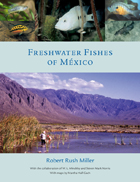 Freshwater Fishes of Mexico
Robert Rush Miller, W. L. Minckley, and Steven Mark Norris
University of Chicago Press, 2006 Though Mexico is only one-fifth the size of the continental United States, it is home to nearly two-thirds as many freshwater fishes as those that swim the waters of the United States and Canada combined. Mexico's diverse freshwater fauna can be attributed to the country's highly varied physical geography, a wide latitudinal range, the largest river system in middle America, and, ironically, its oceans—many marine groups left the brine for the inland springs and never returned to the sea.
No one knew these Mexican freshwaters or the fish that inhabit them better than the late world-renowned ichthyologist Robert Rush Miller. A pioneer of the field, Miller undertook his first field excursion more than fifty years ago and, in the decades following, amassed the information necessary to write the first encyclopedia of Mexican inland ichthyology. Providing keys to more than 500 native species—accompanied by detailed distribution maps and illustrations—Freshwater Fishes of México offers a historical overview of the country's ichthyology, as well as syntheses of the unique biogeography of Mexican fishes and their current conservation status. Organized by family, the species accounts are supplemented with color galleries containing photographs of live fishes in their native environments and natural habitats. Exploring ecological, biological, and taxonomic issues, the book also considers the evolutionary history of the ichthyofauna itself and the human history of the scientists who researched it during the last several centuries.
The life's work of Robert Rush Miller, the long-awaited Freshwater Fishes of México will be welcomed not only by students of Mexican fishes, but by all ichthyologists working in Central and North America. This book will also find an audience among home aquarium hobbyists, fishery managers, conservation biologists, and environmental planners and managers.
The Freshwater Imperative: A Research Agenda
Robert J. Naiman, John J. Magnuson, Diane M. McKnight, and Jack A. Stanford; Foreword by Kathryn D. Sullivan
Island Press, 1995 This volume summarizes the two-year effort of a working group of leading aquatic scientists sponsored by NSF, EPA, NASA, TVA, and NOAA to identify research opportunities and frontiers in freshwater sciences for this decade and beyond. The research agenda outlined focuses on issues of water availability, aquatic ecosystem integrity, and human health and safety. It is a consensus document that has been endorsed by all of the major professional organizations involved with freshwater issues.
 Freshwater Marshes: Ecology and Wildlife Management
Milton W. Weller
University of Minnesota Press, 1994 Freshwater Marshes was first published in 1994. Minnesota Archive Editions uses digital technology to make long-unavailable books once again accessible, and are published unaltered from the original University of Minnesota Press editions. Prairie potholes, wetland edges of lakes and rivers, and other freshwater marshes play a vital role in maintaining a clean and plentiful water supply for wildlife and human use. These wetland areas provide habitat for spawning fish, feed waterfowl, purify and retain water, and control erosion. In this updated third edition, Milton W. Weller describes the components of the freshwater marsh: its annual and seasonal dynamics as affected by rainfall cycles and the plant and animal population's response to such changes. Weller discusses how such wetland areas are managed for wildlife populations and diversity, and how such processes can be used in wetland conservation and restoration. He considers the impact society has on wetlands and offers conservation goals for freshwater wetland complexes. Weller broadens the third edition to include an analysis of how prairie wetlands compare in water dynamics with swamps, tidal marshes, and other wetlands. He also expands the discussion of wetland classification, evaluation, mitigation, and restoration, and introduces a new glossary of current wetland terminology. Freshwater Marshes is Volume 1 of Wildlife Habitats. Milton W. Weller is professor emeritus and former Kleberg Chair in Wildlife Ecology, at Texas A&M University.
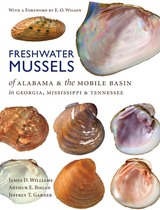 Freshwater Mussels of Alabama and the Mobile Basin in Georgia, Mississippi, and Tennessee
James D. Williams
University of Alabama Press, 2008 Alabama rivers and waterways are home to the largest and most diverse population of freshwater mussel species in the nation, roughly 60% of U.S. mussel fauna. The Mobile River Basin, which drains portions of Tennessee, Georgia, and Mississippi waterways, also contains diverse mussel populations. However, many of these species have been significantly depleted in the last century due to habitat alteration (river damming, channelization, siltation), pollution, and invasive species, and many more are in imminent danger of extinction.
The authors offer encyclopedic entries on each of the 178 mussel species currently identified in Alabama and the Mobile River Basin—the scientific and common names; a morphological description as well as color photographs of the shell appearance; analysis of the soft anatomy; information about ecology, biology, and conservation status; and a color distribution map. With an extensive glossary of terms and full index, plus additional material on the archaeological record, a history of commercial uses of mussels, and the work of significant biologists studying these species, this volume is a long overdue and invaluable resource, not only for scholars of aquatic biology and zoology but also conservationists interested in the preservation of ecological diversity and protection of inland environments.
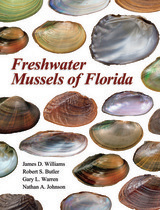 Freshwater Mussels of Florida
James D. Williams, Robert S. Butler, Gary L. Warren, and Nathan A. Johnson
University of Alabama Press, 2014 An exhaustive guide to all aspects of the freshwater mussel fauna in Florida, Freshwater Mussels of Florida covers the ecology, biology, distribution, and conservation of the many species of bivalve mollusks in the Sunshine State. In the past three decades, researchers, the public, businesses that depend on wildlife, and policy makers have given more attention to the threatened natural diversity of the Southeast, including freshwater mussels. This compendium meets the increasingly urgent need to catalog this imperiled group of aquatic organisms in the United States.
Each entry in this definitive guide provides a detailed description and multiple depictions of the species as well as select characteristics of its soft anatomy and miscellaneous notes of interest. Individual distribution maps pinpoint the historical and present occurrence of each bivalve species and are just one component of the rich set of 307 mussel and habitat photographs, seventy-four maps, and thirteen tables that illustrate the book. Of particular interest are remarkable electron micrographs of glochidia, the specialized larval life history stage parasitic upon fishes.
Freshwater Mussels of Florida will be of lasting value to state and federal conservation agencies as well as other government and nongovernment entities that manage aquatic resources in Florida. The research provides a key baseline for future study of Florida mussels. The survey results in this guide, along with extensive reviews of historical mussel collections in natural history museums, provide a complete picture of the Florida mussel fauna, past and present.
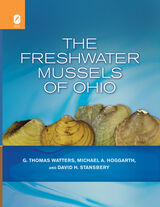 The Freshwater Mussels of Ohio
G. Thomas Watters, Michael A. Hoggarth, and David H. Stansbery
Ohio State University Press, 2009 Nearly 200 years ago, a naturalist named Rafinesque stood on the banks of the Ohio River and began to describe the freshwater mussels he found there. Since that time these animals have become the most imperiled animals in North America. Dozens of species have become extinct, and it is estimated that two-thirds of the remaining freshwater mussels face a similar fate. Yet, despite their importance, the mussels of Ohio remain a poorly documented and largely mysterious fauna. The Freshwater Mussels of Ohio by G. Thomas Watters, Michael A. Hoggarth, and David H. Stansbery brings together, for the first time, the most up-to-date research on Ohio’s mussels. Designed for the weekend naturalist and scientist alike, it synthesizes recent work on genetics, biology, and systematics into one book. Each species is illustrated to a degree not found in any other work. Full-page color plates depict shell variation, hinge detail, and beak sculpture. Full-page maps show the distribution of each species based upon the collections of numerous museums (with historical distributions dating from the 1800s). In addition to species accounts, the book has a substantive introduction that includes information on basic biology, human use, and conservation issues. Extensive synonymies, a key to all species, and an illustrated glossary are included as well.
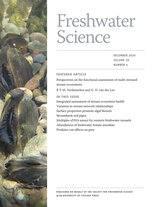 Freshwater Science, volume 39 number 4 (December 2020)
The University of Chicago Press
University of Chicago Press Journals, 2020 This is volume 39 issue 4 of Freshwater Science. Freshwater Science (FWS) publishes articles that advance understanding and environmental stewardship of all types of inland aquatic ecosystems (lakes, rivers, streams, reservoirs, subterranean, and estuaries) and ecosystems at the interface between aquatic and terrestrial habitats (wetlands, riparian areas, and floodplains). The journal regularly features papers on a wide range of topics, including physical, chemical, and biological properties of lentic and lotic habitats; ecosystem processes; structure and dynamics of populations, communities, and ecosystems; ecology, systematics, and genetics of freshwater organisms, from bacteria to vertebrates; linkages between freshwater and other ecosystems and between freshwater ecology and other aquatic sciences; bioassessment, conservation, and restoration; environmental management; and new or novel methods for basic or applied research.
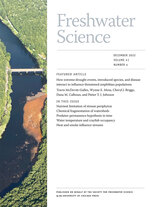 Freshwater Science, volume 41 number 4 (December 2022)
The University of Chicago Press
University of Chicago Press Journals, 2022 This is volume 41 issue 4 of Freshwater Science. Freshwater Science (FWS) publishes articles that advance understanding and environmental stewardship of all types of inland aquatic ecosystems (lakes, rivers, streams, reservoirs, subterranean, and estuaries) and ecosystems at the interface between aquatic and terrestrial habitats (wetlands, riparian areas, and floodplains). The journal regularly features papers on a wide range of topics, including physical, chemical, and biological properties of lentic and lotic habitats; ecosystem processes; structure and dynamics of populations, communities, and ecosystems; ecology, systematics, and genetics of freshwater organisms, from bacteria to vertebrates; linkages between freshwater and other ecosystems and between freshwater ecology and other aquatic sciences; bioassessment, conservation, and restoration; environmental management; and new or novel methods for basic or applied research.
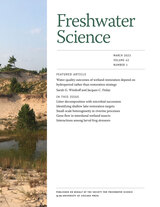 Freshwater Science, volume 42 number 1 (March 2023)
The University of Chicago Press
University of Chicago Press Journals, 2023 This is volume 42 issue 1 of Freshwater Science. Freshwater Science (FWS) publishes articles that advance understanding and environmental stewardship of all types of inland aquatic ecosystems (lakes, rivers, streams, reservoirs, subterranean, and estuaries) and ecosystems at the interface between aquatic and terrestrial habitats (wetlands, riparian areas, and floodplains). The journal regularly features papers on a wide range of topics, including physical, chemical, and biological properties of lentic and lotic habitats; ecosystem processes; structure and dynamics of populations, communities, and ecosystems; ecology, systematics, and genetics of freshwater organisms, from bacteria to vertebrates; linkages between freshwater and other ecosystems and between freshwater ecology and other aquatic sciences; bioassessment, conservation, and restoration; environmental management; and new or novel methods for basic or applied research.
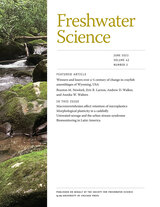 Freshwater Science, volume 42 number 2 (June 2023)
The University of Chicago Press
University of Chicago Press Journals, 2023 This is volume 42 issue 2 of Freshwater Science. Freshwater Science (FWS) publishes articles that advance understanding and environmental stewardship of all types of inland aquatic ecosystems (lakes, rivers, streams, reservoirs, subterranean, and estuaries) and ecosystems at the interface between aquatic and terrestrial habitats (wetlands, riparian areas, and floodplains). The journal regularly features papers on a wide range of topics, including physical, chemical, and biological properties of lentic and lotic habitats; ecosystem processes; structure and dynamics of populations, communities, and ecosystems; ecology, systematics, and genetics of freshwater organisms, from bacteria to vertebrates; linkages between freshwater and other ecosystems and between freshwater ecology and other aquatic sciences; bioassessment, conservation, and restoration; environmental management; and new or novel methods for basic or applied research.
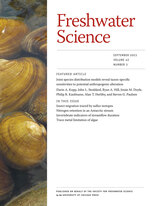 Freshwater Science, volume 42 number 3 (September 2023)
The University of Chicago Press
University of Chicago Press Journals, 2023 This is volume 42 issue 3 of Freshwater Science. Freshwater Science (FWS) publishes articles that advance understanding and environmental stewardship of all types of inland aquatic ecosystems (lakes, rivers, streams, reservoirs, subterranean, and estuaries) and ecosystems at the interface between aquatic and terrestrial habitats (wetlands, riparian areas, and floodplains). The journal regularly features papers on a wide range of topics, including physical, chemical, and biological properties of lentic and lotic habitats; ecosystem processes; structure and dynamics of populations, communities, and ecosystems; ecology, systematics, and genetics of freshwater organisms, from bacteria to vertebrates; linkages between freshwater and other ecosystems and between freshwater ecology and other aquatic sciences; bioassessment, conservation, and restoration; environmental management; and new or novel methods for basic or applied research.
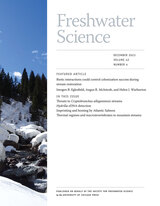 Freshwater Science, volume 42 number 4 (December 2023)
The University of Chicago Press
University of Chicago Press Journals, 2023 This is volume 42 issue 4 of Freshwater Science. Freshwater Science (FWS) publishes articles that advance understanding and environmental stewardship of all types of inland aquatic ecosystems (lakes, rivers, streams, reservoirs, subterranean, and estuaries) and ecosystems at the interface between aquatic and terrestrial habitats (wetlands, riparian areas, and floodplains). The journal regularly features papers on a wide range of topics, including physical, chemical, and biological properties of lentic and lotic habitats; ecosystem processes; structure and dynamics of populations, communities, and ecosystems; ecology, systematics, and genetics of freshwater organisms, from bacteria to vertebrates; linkages between freshwater and other ecosystems and between freshwater ecology and other aquatic sciences; bioassessment, conservation, and restoration; environmental management; and new or novel methods for basic or applied research.
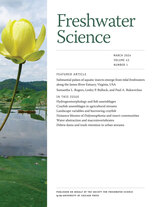 Freshwater Science, volume 43 number 1 (March 2024)
The University of Chicago Press
University of Chicago Press Journals, 2024 This is volume 43 issue 1 of Freshwater Science. Freshwater Science (FWS) publishes articles that advance understanding and environmental stewardship of all types of inland aquatic ecosystems (lakes, rivers, streams, reservoirs, subterranean, and estuaries) and ecosystems at the interface between aquatic and terrestrial habitats (wetlands, riparian areas, and floodplains). The journal regularly features papers on a wide range of topics, including physical, chemical, and biological properties of lentic and lotic habitats; ecosystem processes; structure and dynamics of populations, communities, and ecosystems; ecology, systematics, and genetics of freshwater organisms, from bacteria to vertebrates; linkages between freshwater and other ecosystems and between freshwater ecology and other aquatic sciences; bioassessment, conservation, and restoration; environmental management; and new or novel methods for basic or applied research.
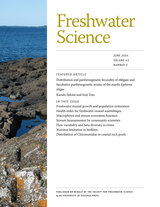 Freshwater Science, volume 43 number 2 (June 2024)
The University of Chicago Press
University of Chicago Press Journals, 2024 This is volume 43 issue 2 of Freshwater Science. Freshwater Science (FWS) publishes articles that advance understanding and environmental stewardship of all types of inland aquatic ecosystems (lakes, rivers, streams, reservoirs, subterranean, and estuaries) and ecosystems at the interface between aquatic and terrestrial habitats (wetlands, riparian areas, and floodplains). The journal regularly features papers on a wide range of topics, including physical, chemical, and biological properties of lentic and lotic habitats; ecosystem processes; structure and dynamics of populations, communities, and ecosystems; ecology, systematics, and genetics of freshwater organisms, from bacteria to vertebrates; linkages between freshwater and other ecosystems and between freshwater ecology and other aquatic sciences; bioassessment, conservation, and restoration; environmental management; and new or novel methods for basic or applied research.
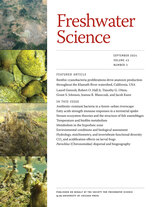 Freshwater Science, volume 43 number 3 (September 2024)
The University of Chicago Press
University of Chicago Press Journals, 2024 This is volume 43 issue 3 of Freshwater Science. Freshwater Science (FWS) publishes articles that advance understanding and environmental stewardship of all types of inland aquatic ecosystems (lakes, rivers, streams, reservoirs, subterranean, and estuaries) and ecosystems at the interface between aquatic and terrestrial habitats (wetlands, riparian areas, and floodplains). The journal regularly features papers on a wide range of topics, including physical, chemical, and biological properties of lentic and lotic habitats; ecosystem processes; structure and dynamics of populations, communities, and ecosystems; ecology, systematics, and genetics of freshwater organisms, from bacteria to vertebrates; linkages between freshwater and other ecosystems and between freshwater ecology and other aquatic sciences; bioassessment, conservation, and restoration; environmental management; and new or novel methods for basic or applied research.
 Freshwater Science, volume 43 number 4 (December 2024)
The University of Chicago Press
University of Chicago Press Journals, 2024 This is volume 43 issue 4 of Freshwater Science. Freshwater Science (FWS) publishes articles that advance understanding and environmental stewardship of all types of inland aquatic ecosystems (lakes, rivers, streams, reservoirs, subterranean, and estuaries) and ecosystems at the interface between aquatic and terrestrial habitats (wetlands, riparian areas, and floodplains). The journal regularly features papers on a wide range of topics, including physical, chemical, and biological properties of lentic and lotic habitats; ecosystem processes; structure and dynamics of populations, communities, and ecosystems; ecology, systematics, and genetics of freshwater organisms, from bacteria to vertebrates; linkages between freshwater and other ecosystems and between freshwater ecology and other aquatic sciences; bioassessment, conservation, and restoration; environmental management; and new or novel methods for basic or applied research.
 Freshwater Science, volume 44 number 1 (March 2025)
The University of Chicago Press
University of Chicago Press Journals, 2025 This is volume 44 issue 1 of Freshwater Science. Freshwater Science (FWS) publishes articles that advance understanding and environmental stewardship of all types of inland aquatic ecosystems (lakes, rivers, streams, reservoirs, subterranean, and estuaries) and ecosystems at the interface between aquatic and terrestrial habitats (wetlands, riparian areas, and floodplains). The journal regularly features papers on a wide range of topics, including physical, chemical, and biological properties of lentic and lotic habitats; ecosystem processes; structure and dynamics of populations, communities, and ecosystems; ecology, systematics, and genetics of freshwater organisms, from bacteria to vertebrates; linkages between freshwater and other ecosystems and between freshwater ecology and other aquatic sciences; bioassessment, conservation, and restoration; environmental management; and new or novel methods for basic or applied research.
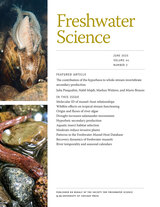 Freshwater Science, volume 44 number 2 (June 2025)
The University of Chicago Press
University of Chicago Press Journals, 2025 This is volume 44 issue 2 of Freshwater Science. Freshwater Science (FWS) publishes articles that advance understanding and environmental stewardship of all types of inland aquatic ecosystems (lakes, rivers, streams, reservoirs, subterranean, and estuaries) and ecosystems at the interface between aquatic and terrestrial habitats (wetlands, riparian areas, and floodplains). The journal regularly features papers on a wide range of topics, including physical, chemical, and biological properties of lentic and lotic habitats; ecosystem processes; structure and dynamics of populations, communities, and ecosystems; ecology, systematics, and genetics of freshwater organisms, from bacteria to vertebrates; linkages between freshwater and other ecosystems and between freshwater ecology and other aquatic sciences; bioassessment, conservation, and restoration; environmental management; and new or novel methods for basic or applied research.
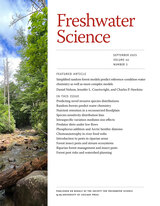 Freshwater Science, volume 44 number 3 (September 2025)
The University of Chicago Press
University of Chicago Press Journals, 2025 This is volume 44 issue 3 of Freshwater Science. Freshwater Science (FWS) publishes articles that advance understanding and environmental stewardship of all types of inland aquatic ecosystems (lakes, rivers, streams, reservoirs, subterranean, and estuaries) and ecosystems at the interface between aquatic and terrestrial habitats (wetlands, riparian areas, and floodplains). The journal regularly features papers on a wide range of topics, including physical, chemical, and biological properties of lentic and lotic habitats; ecosystem processes; structure and dynamics of populations, communities, and ecosystems; ecology, systematics, and genetics of freshwater organisms, from bacteria to vertebrates; linkages between freshwater and other ecosystems and between freshwater ecology and other aquatic sciences; bioassessment, conservation, and restoration; environmental management; and new or novel methods for basic or applied research.
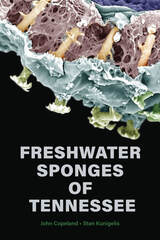 Freshwater Sponges of Tennessee
John Copeland
University of Tennessee Press, 2024 Authors John E. Copeland and Stan C. Kunigelis explore a unique but important class of animals that may be unfamiliar to many readers: freshwater sponges. Freshwater Sponges of Tennessee provides comprehensive information about sponges in Tennessee waterways, vastly updating both the scientific community and the reading public on sponge biodiversity and conservation.
Copeland and Kunigelis offer compelling reasons for studying freshwater sponges. These animals perform unique and beneficial functions within their ecosystems, have fascinating life histories, and are important components of some products useful to humans. The authors approach their subject with a nonspecialized readership in mind, providing explanations of scientific concepts, a glossary of terms, a chapter on taxonomy, and a description of lab and field procedures.
The wide accessibility of freshwater sponges in lakes and streams makes for exciting and informative field trips for students and teachers. The detailed descriptions of sponge species, maps of where they have been found, color photographs from the field, and scans of electron micrographs make Freshwater Sponges of Tennessee an excellent classroom textbook or exploratory field guide for trips to Tennessee’s magnificent waterways.
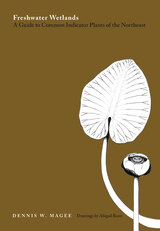 Freshwater Wetlands: A Guide to Common Indicator Plants of the Northeast
Dennis W. Magee
University of Massachusetts Press, 1981 Although public interest in wetlands has grown considerably in recent years, the associated issues of legislation and environmental policy are often confused by the need to correctly define a wetland area. Much of the difficulty comes from an inability to identify wetland indicator species and to determine whether a given area contains a significant proportion of such plants. The 182 species treated in this work represent the fast majority of genera commonly encountered in freshwater wetlands throughout the Northeast, consequently, this will prove an invaluable book for those concerned with how a correct definition of wetland areas affects decisions about land use, development, and/or conservation.
Following a brief introduction that discusses the functional values of wetlands and describes their various types, the manual is organized into two major components, the first consisting of keys that are based on life form and arrangement of plant parts, the second consisting of a description of each species. Such factors as range, habitat, general characteristics, stem, leaves, inflorescence, fruit, and similar species are covered in the descriptions.
fretwork
Glazer, Michele
University of Iowa Press, 2021 Fretwork hazards a response to its dilemma by turning, skeptically and resiliently, toward the materials of lyric poetry and empathetic action, however fragmented and fragile. Glazer’s poems are sculpted word by word, their forms evoking both organic process and machined exactness. Their voice blends command and humility, openness and terseness, generosity and rigor, gravity and mordant humor.
Freud, Biologist of the Mind: Beyond the Psychoanalytic Legend, With a New Preface by the Author
Frank J. Sulloway
Harvard University Press, 1992 In this monumental intellectual biography, Frank Sulloway demonstrates that Freud always remained, despite his denials, a biologist of the mind; and, indeed, that his most creative inspirations derived significantly from biology. Sulloway analyzes the political aspects of the complex myth of Freud as psychoanalytic hero as it served to consolidate the analytic movement. This is a revolutionary reassessment of Freud and psychoanalysis.
|
|
